ZyXEL Communications IX280P WiMAX MIMO 2.5GHz Indoor Simple CPE User Manual ZyBook2
ZyXEL Communications Corporation WiMAX MIMO 2.5GHz Indoor Simple CPE ZyBook2
Contents
- 1. UserMan-2_I88IX280P
- 2. UserMan-1_I88IX280P
UserMan-2_I88IX280P

Chapter 15 The Firewall Screens
MAX-207HW2R User’s Guide 151
15.4 Technical Reference
The following section contains additional technical information about the MAX-
207HW2R features described in this chapter.
15.4.1 Stateful Inspection Firewall.
Stateful inspection firewalls restrict access by screening data packets against
defined access rules. They make access control decisions based on IP address and
protocol. They also "inspect" the session data to assure the integrity of the
connection and to adapt to dynamic protocols. These firewalls generally provide
the best speed and transparency; however, they may lack the granular application
level access control or caching that some proxies support. Firewalls, of one type or
another, have become an integral part of standard security solutions for
enterprises.
15.4.2 Guidelines For Enhancing Security With Your Firewall
1Change the default password via web configurator.
2Think about access control before you connect to the network in any way.
3Limit who can access your router.
4Don't enable any local service (such as telnet or FTP) that you don't use. Any
enabled service could present a potential security risk. A determined hacker might
be able to find creative ways to misuse the enabled services to access the firewall
or the network.
5For local services that are enabled, protect against misuse. Protect by configuring
the services to communicate only with specific peers, and protect by configuring
rules to block packets for the services at specific interfaces.
6Protect against IP spoofing by making sure the firewall is active.
7Keep the firewall in a secured (locked) room.
15.4.3 The “Triangle Route” Problem
A traffic route is a path for sending or receiving data packets between two
Ethernet devices. You may have more than one connection to the Internet
(through one or more ISPs). If an alternate gateway is on the LAN (and its IP
address is in the same subnet as the MAX-207HW2R’s LAN IP address), the
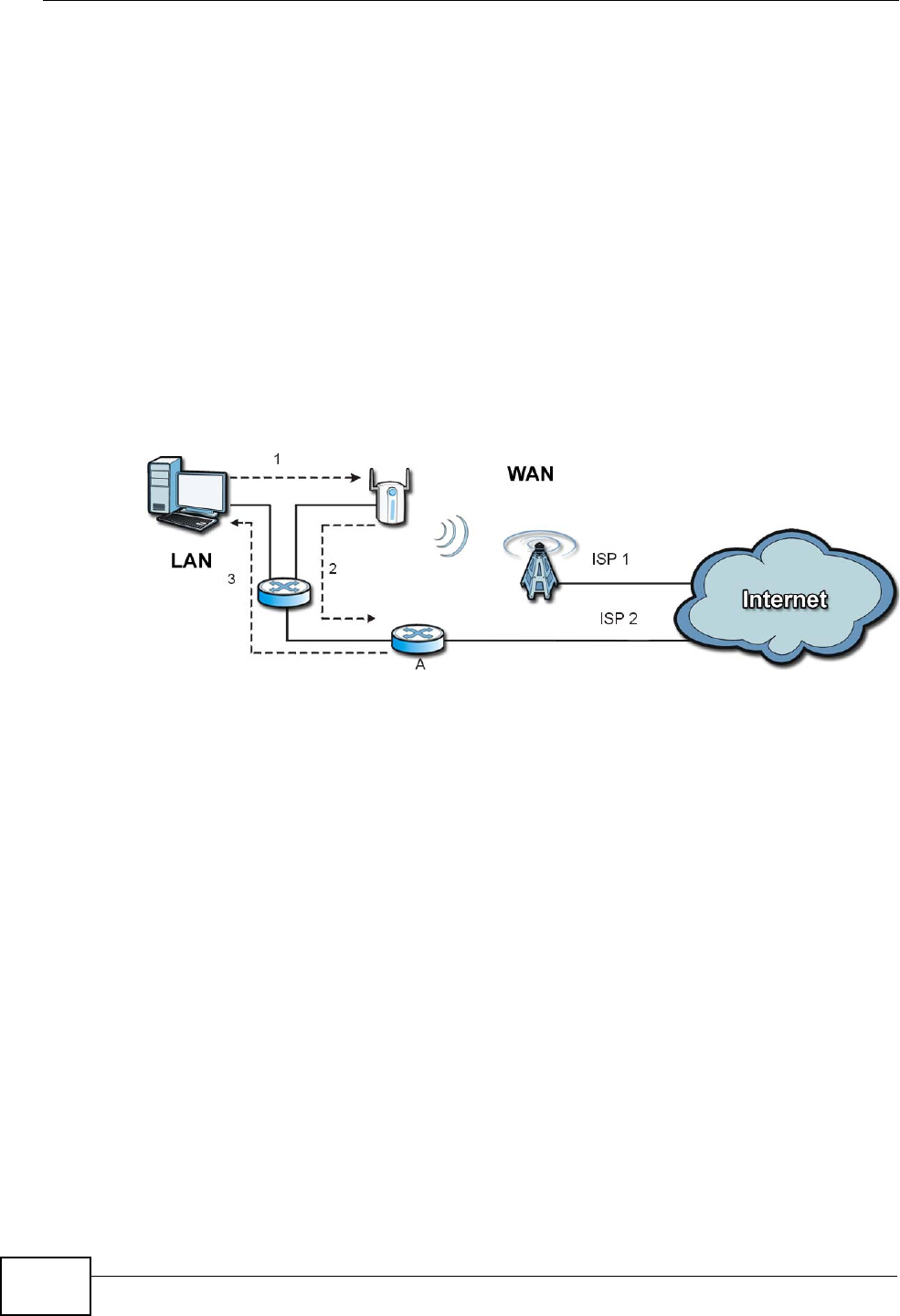
Chapter 15 The Firewall Screens
MAX-207HW2R User’s Guide
152
“triangle route” (also called asymmetrical route) problem may occur. The steps
below describe the “triangle route” problem.
1A computer on the LAN initiates a connection by sending out a SYN packet to a
receiving server on the WAN.
2The MAX-207HW2R reroutes the SYN packet through Gateway A on the LAN to the
WAN.
3The reply from the WAN goes directly to the computer on the LAN without going
through the MAX-207HW2R.
As a result, the MAX-207HW2R resets the connection, as the connection has not
been acknowledged.
Figure 68 “Triangle Route” Problem
15.4.3.1 Solving the “Triangle Route” Problem
If you have the MAX-207HW2R allow triangle route sessions, traffic from the WAN
can go directly to a LAN computer without passing through the MAX-207HW2R
and its firewall protection.
Another solution is to use IP alias. IP alias allows you to partition your network
into logical sections over the same Ethernet interface. Your MAX-207HW2R
supports up to three logical LAN interfaces with the MAX-207HW2R being the
gateway for each logical network.
It’s like having multiple LAN networks that actually use the same physical cables
and ports. By putting your LAN and Gateway A in different subnets, all returning
network traffic must pass through the MAX-207HW2R to your LAN. The following
steps describe such a scenario.
1A computer on the LAN initiates a connection by sending a SYN packet to a
receiving server on the WAN.
2The MAX-207HW2R reroutes the packet to Gateway A, which is in Subnet 2.
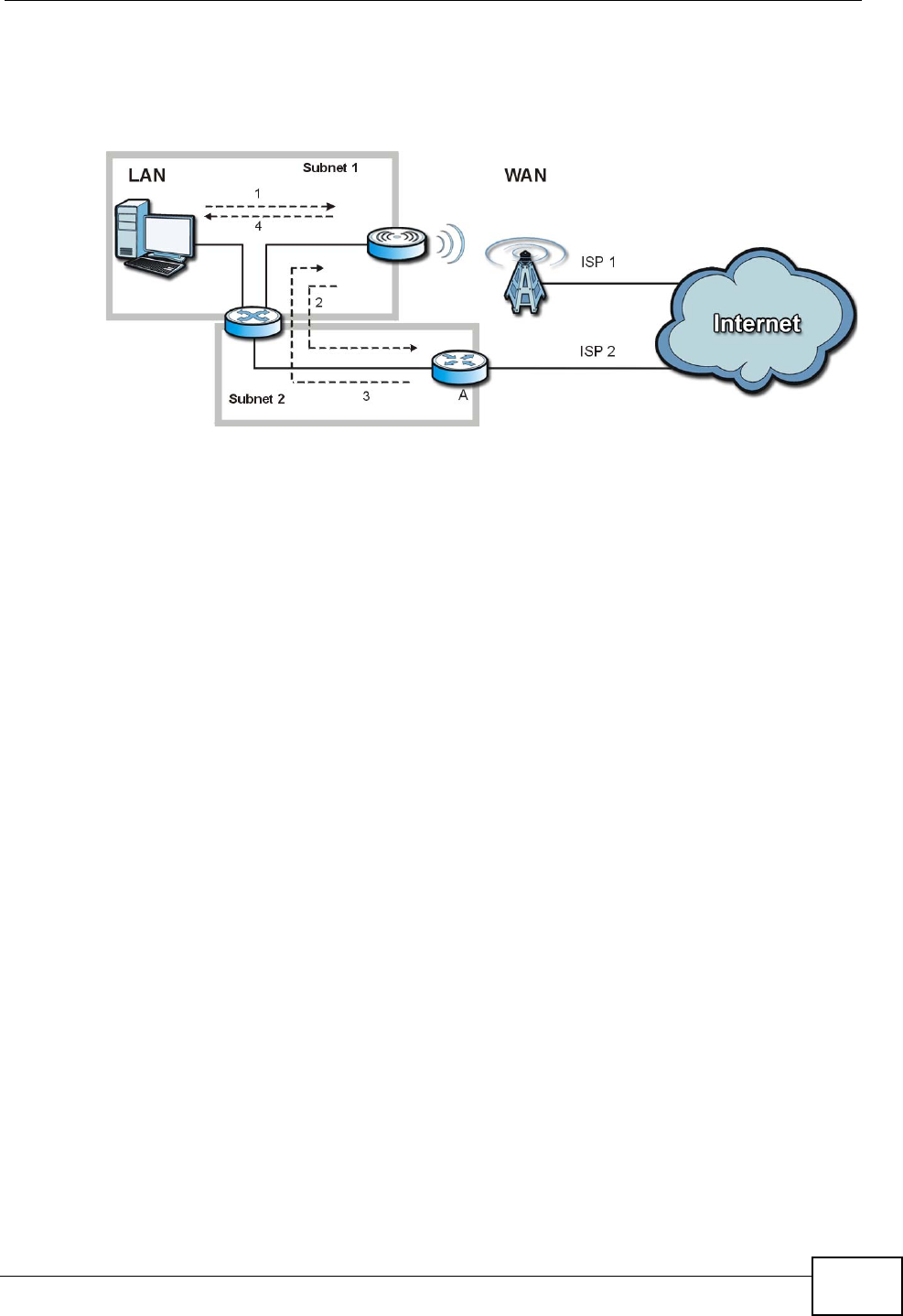
Chapter 15 The Firewall Screens
MAX-207HW2R User’s Guide 153
3The reply from the WAN goes to the MAX-207HW2R.
4The MAX-207HW2R then sends it to the computer on the LAN in Subnet 1.
Figure 69 IP Alias

Chapter 15 The Firewall Screens
MAX-207HW2R User’s Guide
154

MAX-207HW2R User’s Guide 155
CHAPTER 16
Content Filter
16.1 Overview
Use the TOOLS > Content Filter screens to create and enforce policies that
restrict access to the Internet based on content
Internet content filtering allows you to create and enforce Internet access policies
tailored to their needs. Content filtering is the ability to block certain web features
or specific URL keywords. The MAX-207HW2R can block web features such as
ActiveX controls, Java applets, cookies and disable web proxies. The MAX-
207HW2R also allows you to define time periods and days during which the MAX-
207HW2R performs content filtering.
16.1.1 What You Can Do in This Chapter
•The General screen (Section 16.2 on page 156) lets you set up a trusted IP
address, which web features are restricted, and which keywords are blocked
when content filtering is effective.
•The Schedule screen (Section 16.3 on page 158) lets you schedule content
filtering.
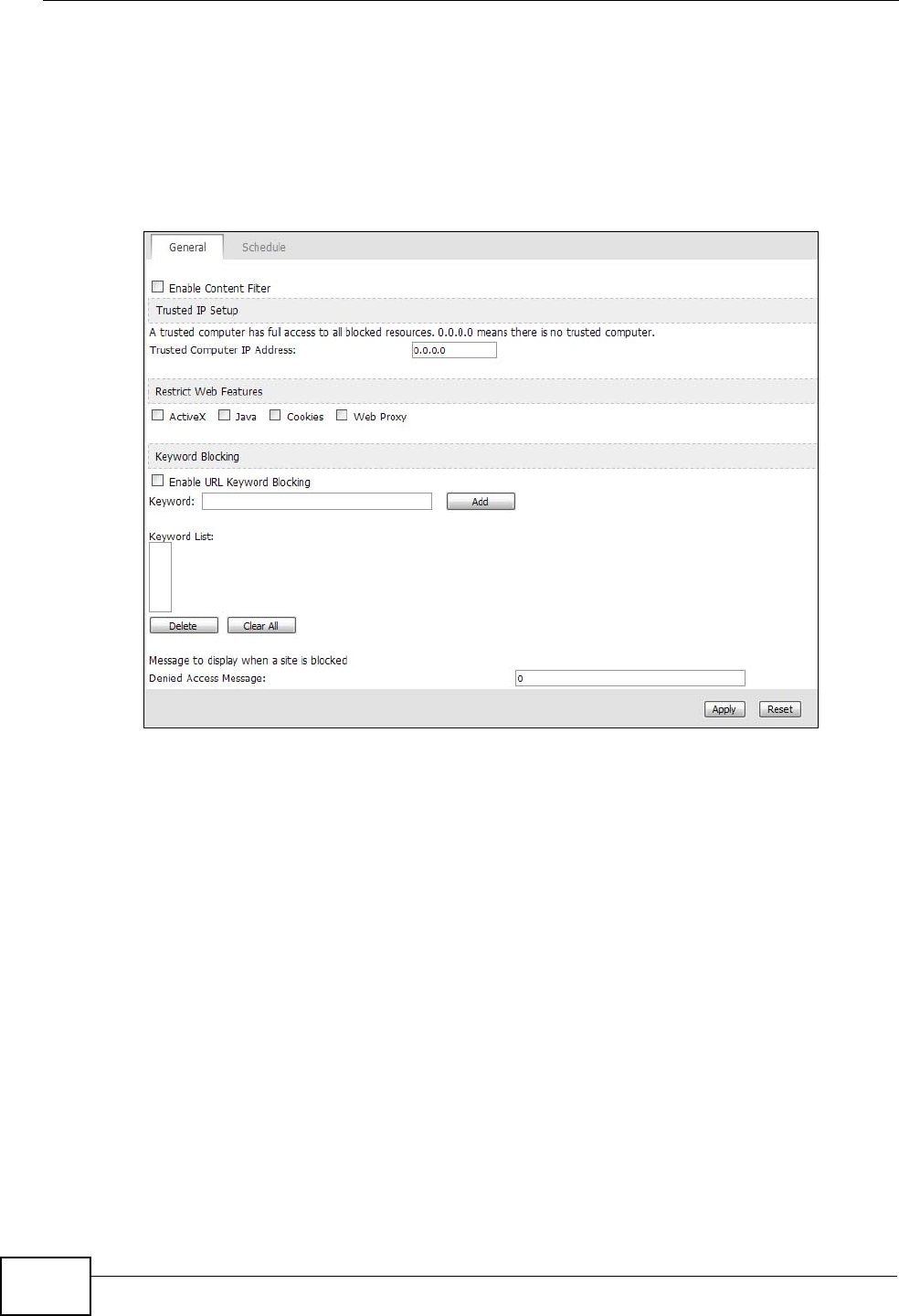
Chapter 16 Content Filter
MAX-207HW2R User’s Guide
156
16.2 Filter
Click TOOLS > Content Filter > General to set up a trusted IP address, which
web features are restricted, and which keywords are blocked when content
filtering is effective.
Figure 70 TOOLS > Content Filter > General

Chapter 16 Content Filter
MAX-207HW2R User’s Guide 157
The following table describes the labels in this screen.
Table 62 TOOLS > Content Filter > General
LABEL DESCRIPTION
Enable Content
Filter
Trusted IP Setup
Trusted
Computer IP
Address
You can allow a specific computer to access all Internet resources
without the restrictions you set in these screens. Enter the IP address of
the trusted computer.
Restrict Web
Features Select the web features you want to disable. If a user downloads a page
with a restricted feature, that part of the web page appears blank or
grayed out.
ActiveX - This is a tool for building dynamic and active Web pages and
distributed object applications. When you visit an ActiveX Web site,
ActiveX controls are downloaded to your browser, where they remain in
case you visit the site again.
Java - This is used to build downloadable Web components or Internet
and intranet business applications of all kinds.
Cookies - This is used by Web servers to track usage and to provide
service based on ID.
Web Proxy - This is a server that acts as an intermediary between a
user and the Internet to provide security, administrative control, and
caching service. When a proxy server is located on the WAN, it is
possible for LAN users to avoid content filtering restrictions.
Keyword Blocking
Enable URL
Keyword
Blocking
Select this if you want the MAX-207HW2R to block Web sites based on
words in the web site address. For example, if you block the keyword
bad, http://www.website.com/bad.html is blocked.
Keyword Type a keyword you want to block in this field. You can use up to 128
printable ASCII characters. There is no wildcard character, however.
Add Click this to add the specified Keyword to the Keyword List. You can
enter up to 128 keywords.
Keyword List This field displays the keywords that are blocked when Enable URL
Keyword Blocking is selected. To delete a keyword, select it, click
Delete, and click Apply.
Delete Click Delete to remove the selected keyword in the Keyword List. The
keyword disappears after you click Apply.
Clear All Click this button to remove all of the keywords in the Keyword List.
Denied Access
Message Enter the message that is displayed when the MAX-207HW2R’s content
filter feature blocks access to a web site.
Apply Click to save your changes.
Reset Click to restore your previously saved settings.
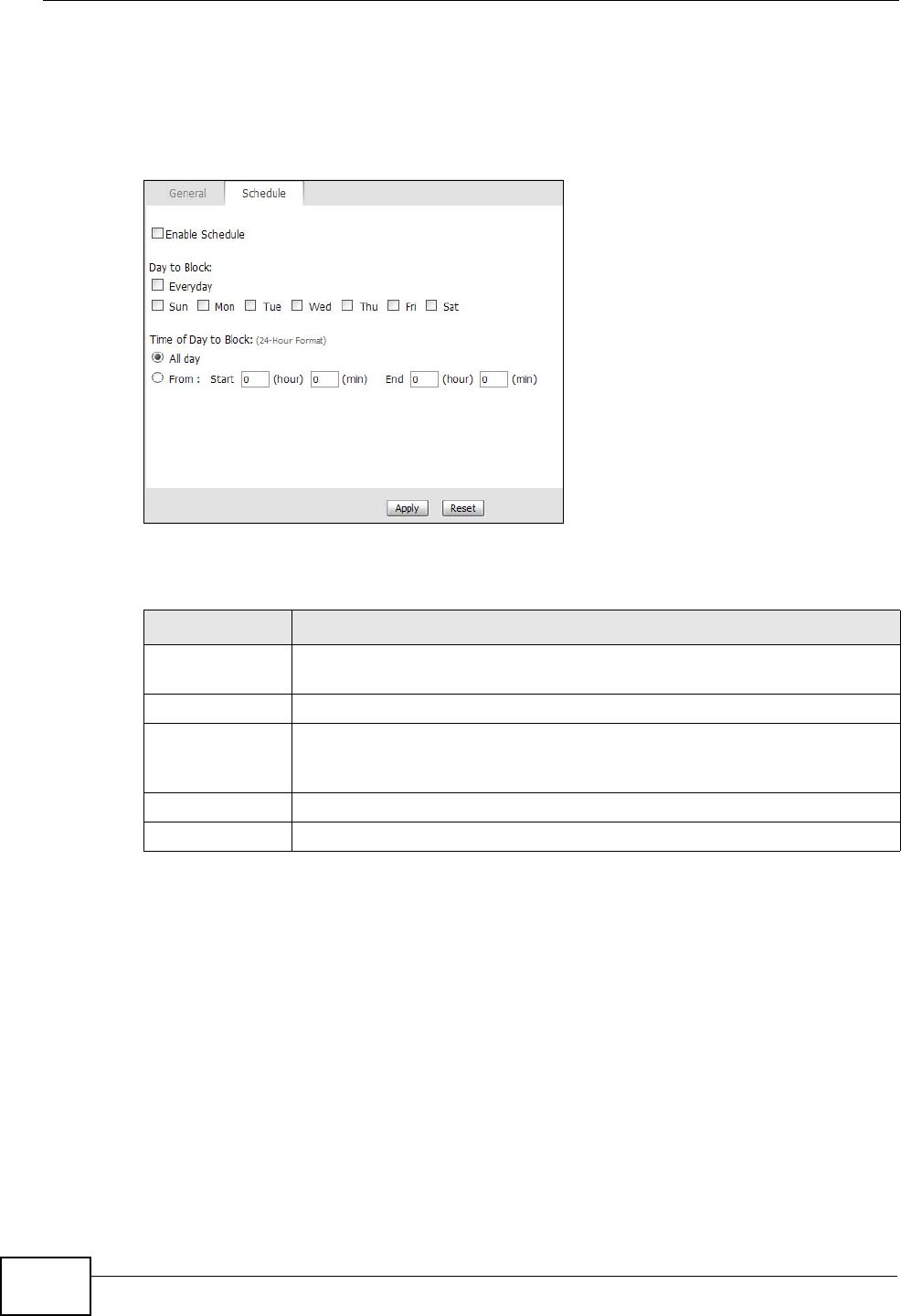
Chapter 16 Content Filter
MAX-207HW2R User’s Guide
158
16.3 Schedule
Click TOOLS > Content Filter > Schedule to schedule content filtering.
Figure 71 TOOLS > Content Filter > Schedule
The following table describes the labels in this screen.
Table 63 TOOLS > Content Filter > Schedule
LABEL DESCRIPTION
Enable
Schedule Select this if you want to enable the schedule.
Day to Block Select which days of the week you want content filtering to be effective.
Time of Day to
Block Select what time each day you want content filtering to be effective.
Enter times in 24-hour format; for example, 3:00pm should be entered
as 15:00.
Apply Click to save your changes.
Reset Click to restore your previously saved settings.
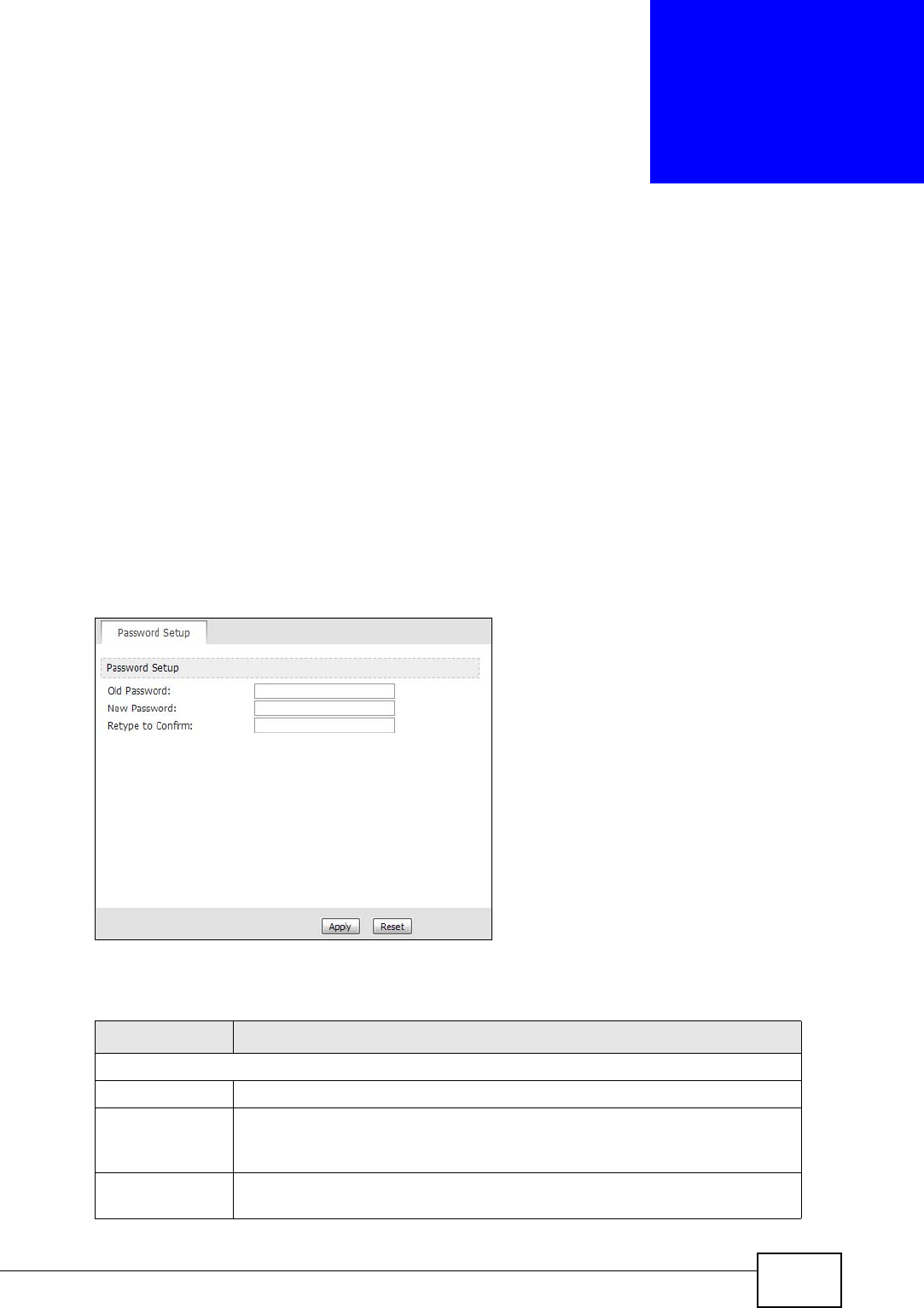
MAX-207HW2R User’s Guide 159
CHAPTER 17
The Password Setup Screen
17.1 Overview
The default administrator password is 1234. Use this screen to change it.
17.2 Password Setup
Click TOOLS > Password Setup to change the administrator password.
Figure 72 TOOLS > Password Setup
The following table describes the labels in this screen.
Table 64 TOOLS > Password Setup
LABEL DESCRIPTION
Password Setup
Old Password Enter the current password you use to access the MAX-207HW2R.
New Password Enter the new password for the MAX-207HW2R. You can use up to 30
characters. As you type the password, the screen displays an asterisk
(*) for each character you type.
Retype to
Confirm Enter the new password again.
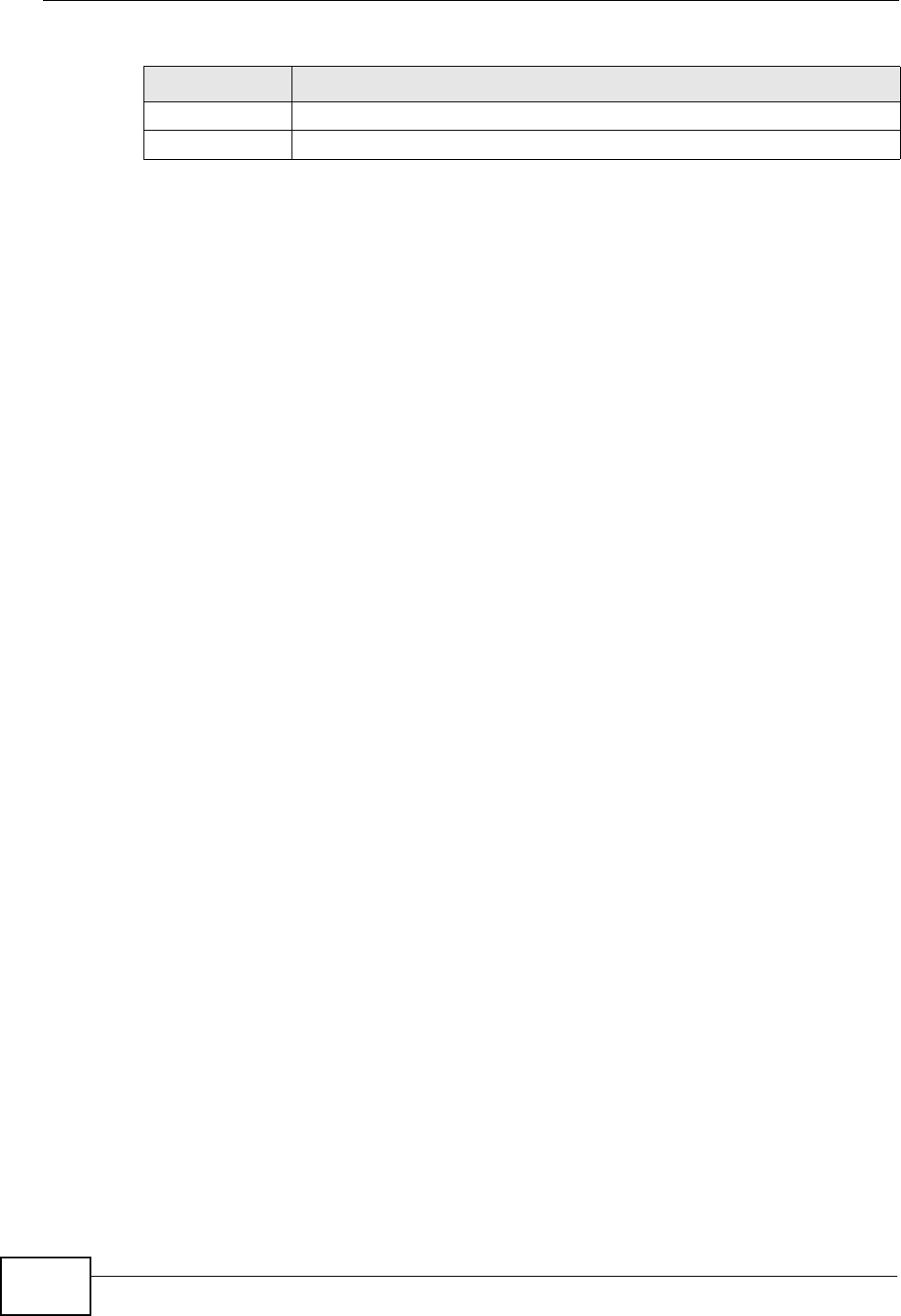
Chapter 17 The Password Setup Screen
MAX-207HW2R User’s Guide
160
Apply Click to save your changes.
Reset Click to restore your previously saved settings.
Table 64 TOOLS > Password Setup
LABEL DESCRIPTION
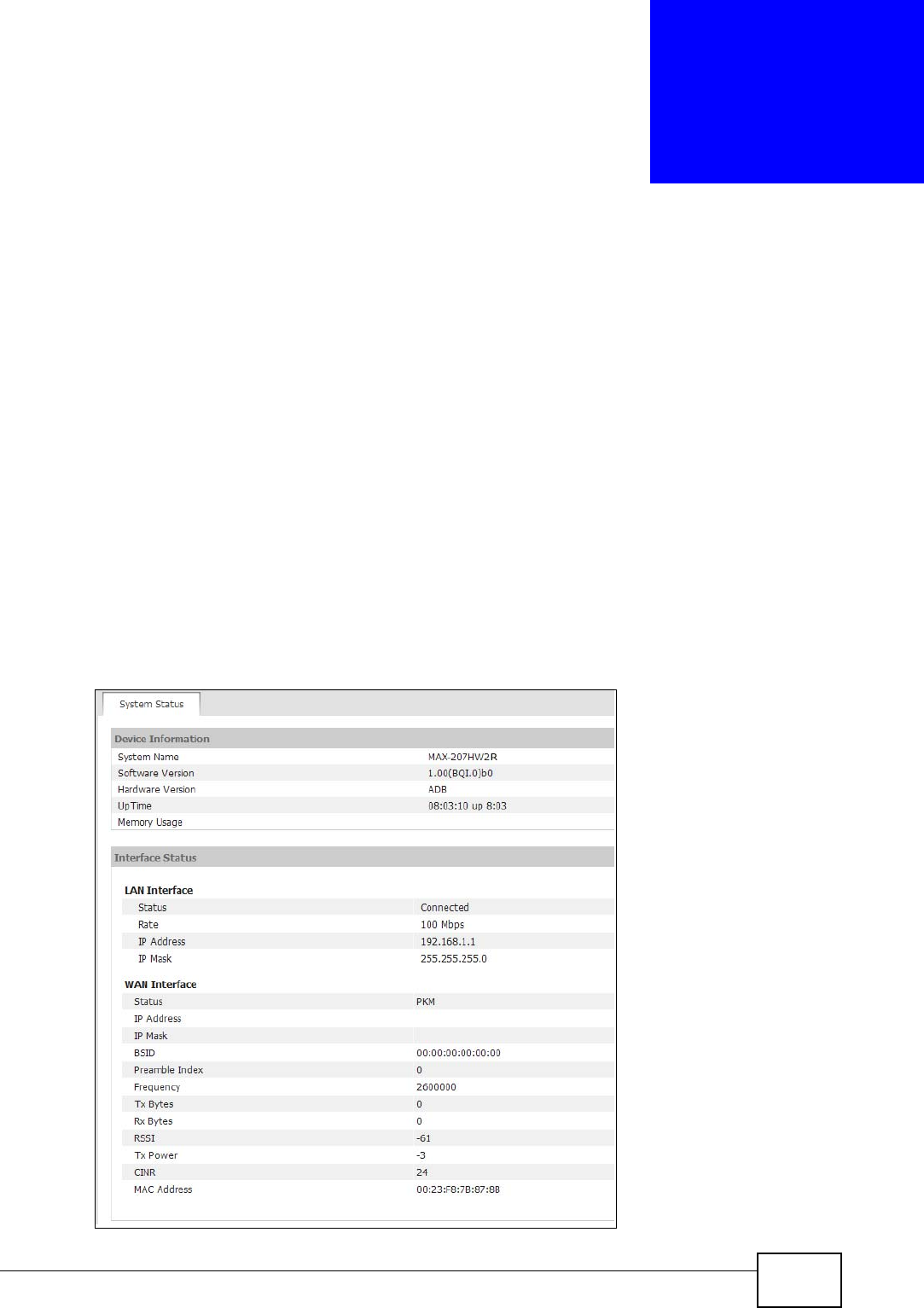
MAX-207HW2R User’s Guide 161
CHAPTER 18
The Status Screen
18.1 Overview
Use this screen to view a complete summary of your MAX-207HW2R connection
status.
18.2 Status Screen
Click the STATUS icon in the navigation bar to go to this screen, where you can
view the current status of the device, system resources, and interfaces (LAN and
WAN).
Figure 73 Status
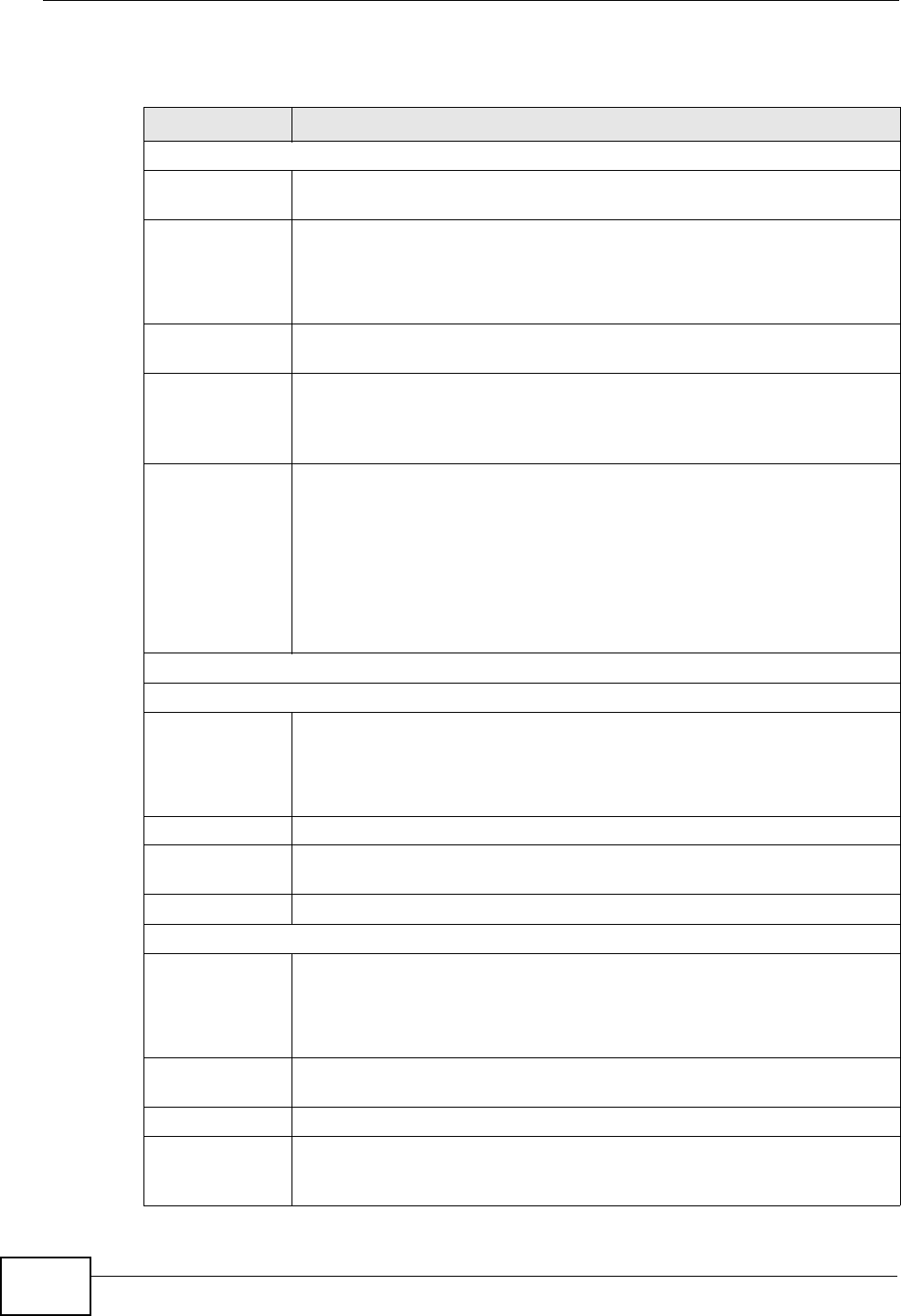
Chapter 18 The Status Screen
MAX-207HW2R User’s Guide
162
The following tables describe the labels in this screen.
Table 65 Status
LABEL DESCRIPTION
Device Information ()
System Name
() This field displays the MAX-207HW2R system name. It is used for
identification.
Firmware
Version () This field displays the current version of the firmware inside the device.
It also shows the date the firmware version was created.
You can change the firmware version by uploading new firmware in
ADVANCED > System Configuration > Firmware.
Hardware
Version This field displays the version of the physical device hardware.
Uptime This field displays how long the MAX-207HW2R has been running since
it last started up. The MAX-207HW2R starts up when you plug it in,
when you restart it (ADVANCED > System Configuration >
Restart), or when you reset it.
Memory Usage This field displays what percentage of the MAX-207HW2R’s memory is
currently used. The higher the memory usage, the more likely the MAX-
207HW2R is to slow down. Some memory is required just to start the
MAX-207HW2R and to run the web configurator. You can reduce the
memory usage by disabling some services (see CPU Usage); by
reducing the amount of memory allocated to NAT and firewall rules (you
may have to reduce the number of NAT rules or firewall rules to do so);
or by deleting rules in functions such as incoming call policies, speed
dial entries, and static routes.
Interface Status
LAN Interface
Status This field indicates whether or not the MAX-207HW2R is using the LAN
interface.
This field displays Connected when the MAX-207HW2R is using the
LAN interface. Otherwise, it displays DISCONNECTED.
Rate This field displays the LAN connection speed (in Mbps).
IP Address This field displays the current IP address of the MAX-207HW2R in the
LAN.
IP Mask This field displays the current subnet mask on the LAN.
WAN Interface
Status This field indicates whether or not the MAX-207HW2R is using the WAN
interface.
This field displays OPERATIONAL when the MAX-207HW2R is using
the WAN interface. Otherwise, it displays DISCONNECTED.
IP Address This field displays the current IP address of the MAX-207HW2R in the
LAN.
IP Mask This field displays the current subnet mask in the LAN.
BSID This field displays the identification number of the wireless base station
to which the MAX-207HW2R is connected. Every base station transmits
a unique BSID, which identifies it across the network.
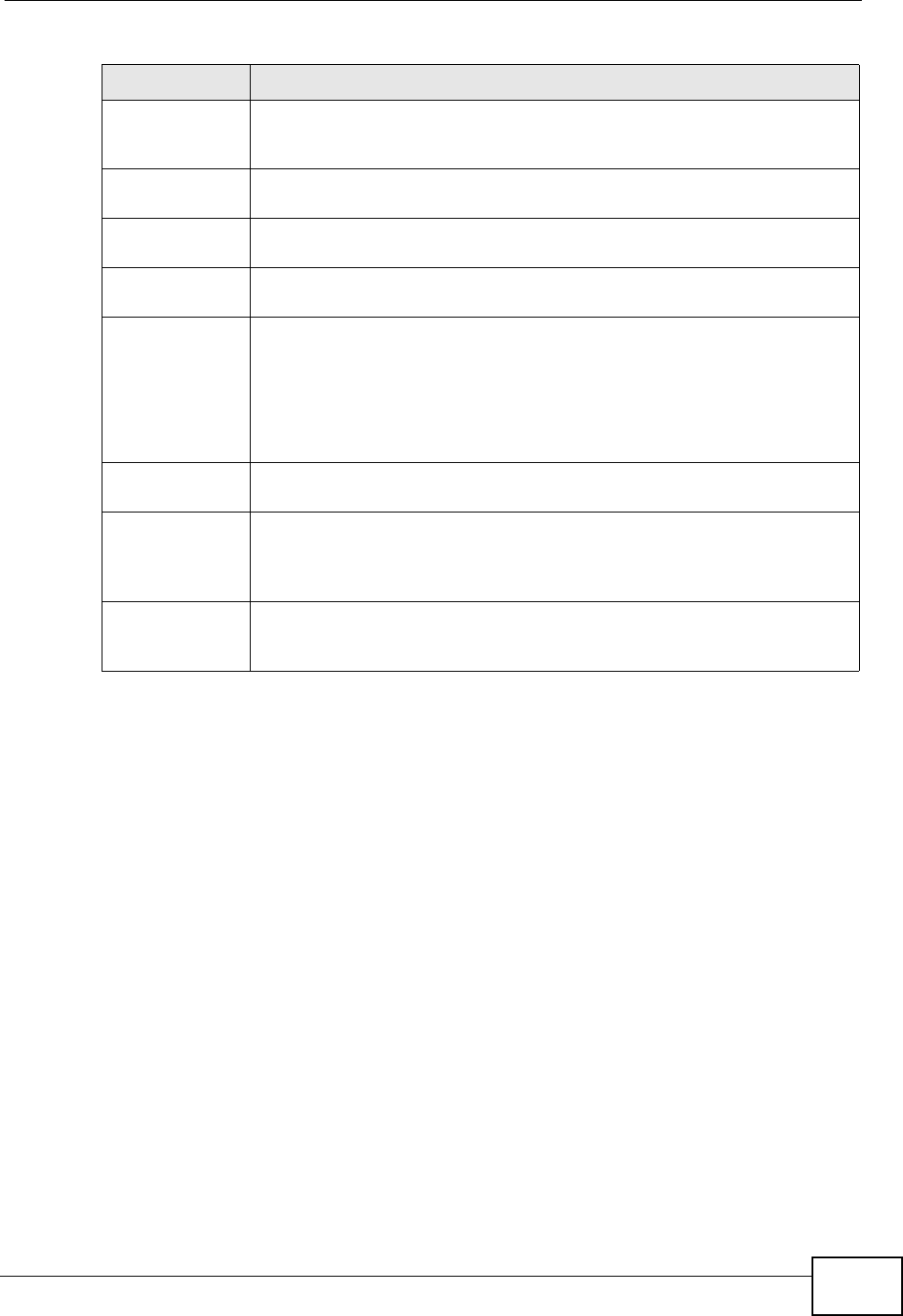
Chapter 18 The Status Screen
MAX-207HW2R User’s Guide 163
Preamble
Index The Preamble Index is the number of bytes used for initial
synchorinzation at the biginning of a downlink frame. See the IEEE
802.16e standard for more information.
Frequency This field displays the radio frequency of the MAX-207HW2R’s wireless
connection to a base station.
Tx Bytes This field shows the number of data packets uploaded from the MAX-
207HW2R to the base station each second.
Rx Bytes This field shows the number of data packets downloaded to the MAX-
207HW2R from the base station each second.
RSSI This field shows the Received Signal Strength Indication. This value is a
measurement of overall radio signal strength. A higher RSSI level
indicates a stronger signal, and a lower RSSI level indicates a weaker
signal.
A strong signal does not necessarily indicate a good signal: a strong
signal may have a low signal-to-noise ratio (SNR).
Tx Power This field shows the output transmission (Tx) level of the MAX-
207HW2R.
CINR This field shows the average Carrier to Interference plus Noise Ratio of
the current connection. This value is an indication of overall radio signal
quality. A higher value indicates a higher signal quality, and a lower
value indicates a lower signal quality.
MAC address This field displays the Media Access Control address of the MAX-
207HW2R. Every network device has a unique MAC address which
identifies it across the network.
Table 65 Status (continued)
LABEL DESCRIPTION

Chapter 18 The Status Screen
MAX-207HW2R User’s Guide
164

MAX-207HW2R User’s Guide 165
CHAPTER 19
Troubleshooting
This chapter offers some suggestions to solve problems you might encounter. The
potential problems are divided into the following categories:
•Power, Hardware Connections, and LEDs
•MAX-207HW2R Access and Login
•Internet Access
•Phone Calls and VoIP
•Reset the MAX-207HW2R to Its Factory Defaults
19.1 Power, Hardware Connections, and LEDs
The MAX-207HW2R does not turn on. None of the LEDs turn on.
1Make sure you are using the power adapter or cord included with the MAX-
207HW2R.
2Make sure the power adapter or cord is connected to the MAX-207HW2R and
plugged in to an appropriate power source. Make sure the power source is turned
on.
3Disconnect and re-connect the power adapter or cord to the MAX-207HW2R.
4If the problem continues, contact the vendor.
One of the LEDs does not behave as expected.
1Make sure you understand the normal behavior of the LED. See Section 1.2.1 on
page 21 for more information.

Chapter 19 Troubleshooting
MAX-207HW2R User’s Guide
166
2Check the hardware connections. See the Quick Start Guide.
3Inspect your cables for damage. Contact the vendor to replace any damaged
cables.
4Disconnect and re-connect the power adapter to the MAX-207HW2R.
5If the problem continues, contact the vendor.
19.2 MAX-207HW2R Access and Login
I forgot the IP address for the MAX-207HW2R.
1The default IP address is http://192.168.1.1.
2If you changed the IP address and have forgotten it, you might get the IP address
of the MAX-207HW2R by looking up the IP address of the default gateway for your
computer. To do this in most Windows computers, click Start > Run, enter cmd,
and then enter ipconfig. The IP address of the Default Gateway might be the IP
address of the MAX-207HW2R (it depends on the network), so enter this IP
address in your Internet browser.
3If this does not work, you have to reset the MAX-207HW2R to its factory defaults.
See Section 19.1 on page 165.
I forgot the password.
1The default password is 1234.
2If this does not work, you have to reset the MAX-207HW2R to its factory defaults.
See Section 9.4 on page 93.
I cannot see or access the Login screen in the web configurator.
1Make sure you are using the correct IP address.
• The default IP address is http://192.168.1.1.

Chapter 19 Troubleshooting
MAX-207HW2R User’s Guide 167
• If you changed the IP address (Section 3.2 on page 32), use the new IP
address.
• If you changed the IP address and have forgotten it, see the troubleshooting
suggestions for I forgot the IP address for the MAX-207HW2R.
2Check the hardware connections, and make sure the LEDs are behaving as
expected. See the Quick Start Guide and Section 1.2.1 on page 21.
3Make sure your Internet browser does not block pop-up windows and has
JavaScript and Java enabled. See Appendix C on page 215.
4If there is a DHCP server on your network, make sure your computer is using a
dynamic IP address. Your MAX-207HW2R is a DHCP server by default.
If there is no DHCP server on your network, make sure your computer’s IP
address is in the same subnet as the MAX-207HW2R. See Appendix D on page
225.
5Reset the MAX-207HW2R to its factory defaults, and try to access the MAX-
207HW2R with the default IP address. See Section 9.5 on page 95.
6If the problem continues, contact the network administrator or vendor, or try one
of the advanced suggestions.
Advanced Suggestions
• Try to access the MAX-207HW2R using another service, such as Telnet. If you
can access the MAX-207HW2R, check the remote management settings and
firewall rules to find out why the MAX-207HW2R does not respond to HTTP.
• If your computer is connected wirelessly, use a computer that is connected to a
LAN/ETHERNET port.
I can see the Login screen, but I cannot log in to the MAX-207HW2R.
1Make sure you have entered the user name and password correctly. The default
user name is admin, and the default password is 1234. These fields are case-
sensitive, so make sure [Caps Lock] is not on.
2You cannot log in to the web configurator while someone is using Telnet to access
the MAX-207HW2R. Log out of the MAX-207HW2R in the other session, or ask the
person who is logged in to log out.
3Disconnect and re-connect the power adapter or cord to the MAX-207HW2R.
4If this does not work, you have to reset the MAX-207HW2R to its factory defaults.
See Section 9.4 on page 93.

Chapter 19 Troubleshooting
MAX-207HW2R User’s Guide
168
I cannot Telnet to the MAX-207HW2R.
See the troubleshooting suggestions for I cannot see or access the Login screen in
the web configurator. Ignore the suggestions about your browser.
19.3 Internet Access
I cannot access the Internet.
1Check the hardware connections, and make sure the LEDs are behaving as
expected. See the Quick Start Guide and Section 1.2.1 on page 21.
2Make sure you entered your ISP account information correctly in the wizard. These
fields are case-sensitive, so make sure [Caps Lock] is not on.
3Check your security settings. In the web configurator, go to the Status screen.
Click the WiMAX Profile link in the Summary box and make sure that you are
using the correct security settings for your Internet account.
4Check your WiMAX settings. The MAX-207HW2R may have been set to search the
wrong frequencies for a wireless connection. In the web configurator, go to the
Status screen. Click the WiMAX Site Information link in the Summary box and
ensure that the values are correct. If the values are incorrect, enter the correct
frequency settings in the ADVANCED > WAN Configuration > WiMAX
Configuration screen. If you are unsure of the correct values, contact your
service provider.
5If you are trying to access the Internet wirelessly, make sure the wireless settings
in the wireless client are the same as the settings in the AP.
6Disconnect all the cables from your MAX-207HW2R, and follow the directions in
the Quick Start Guide again.
7If the problem continues, contact your ISP.
I cannot access the Internet any more. I had access to the Internet (with the MAX-
207HW2R), but my Internet connection is not available any more.

Chapter 19 Troubleshooting
MAX-207HW2R User’s Guide 169
1Check the hardware connections, and make sure the LEDs are behaving as
expected. See the Quick Start Guide and Section 1.2.1 on page 21.
2Disconnect and re-connect the power adapter to the MAX-207HW2R.
3If the problem continues, contact your ISP.
The Internet connection is slow or intermittent.
1The quality of the MAX-207HW2R’s wireless connection to the base station may be
poor. Poor signal reception may be improved by moving the MAX-207HW2R away
from thick walls and other obstructions, or to a higher floor in your building.
2There may be radio interference caused by nearby electrical devices such as
microwave ovens and radio transmitters. Move the MAX-207HW2R away or switch
the other devices off. Weather conditions may also affect signal quality.
3As well as having an external antenna connector, the MAX-210HW2 is equipped
with an internal directional antenna. If you know the location of the base station,
orient the front of the MAX-207HW2R (the side with the LEDs) towards the base
station. If you do not know the location of the base station, experiment by moving
the MAX-207HW2R while observing the Strength Indicator LEDs for an increase
in received signal strength. The MAX-200HW2 and MAX-230HW2 do not have
internal antennas.
4There might be a lot of traffic on the network. Look at the LEDs, and check Section
1.2.1 on page 21. If the MAX-207HW2R is sending or receiving a lot of
information, try closing some programs that use the Internet, especially peer-to-
peer applications.
5Disconnect and re-connect the power adapter to the MAX-207HW2R.
6If the problem continues, contact the network administrator or vendor, or try one
of the advanced suggestions.
The Internet connection disconnects.
1Check your WiMAX link and signal strength using the WiMAX Link and Strength
Indicator LEDs on the device.
2Contact your ISP if the problem persists.

Chapter 19 Troubleshooting
MAX-207HW2R User’s Guide
170
19.4 Phone Calls and VoIP
The telephone port won’t work or the telephone lacks a dial tone.
1Check the telephone connections and telephone wire.
2Make sure you have the VOICE > Service Configuration > SIP Settings screen
properly configured (Chapter 10 on page 97).
I can access the Internet, but cannot make VoIP calls.
1Make sure you have the VOICE > Service Configuration > SIP Settings screen
properly configured (Chapter 10 on page 97).
2The VoIP LED should come on. Make sure that your telephone is connected to the
VoIP port (see the Quick Start Guide for information on connecting telephone
cables to the these ports).
3You can also check the VoIP status in the Status screen.
4If the VoIP settings are correct, use speed dial to make peer-to-peer calls. If you
cannot make a call using speed dial, there may be something wrong with the SIP
server. Contact your VoIP service provider.
Problems With Multiple SIP Accounts
You can set up two SIP accounts on your MAX-207HW2R. By default your MAX-
207HW2R uses SIP account 1 for outgoing calls, and it uses SIP accounts 1 and 2
for incoming calls. With this setting, you always use SIP account 1 for your
outgoing calls and you cannot distinguish which SIP account the calls are coming
in through. If you want to control the use of different dialing plans for accounting
purposes or other reasons, you need to configure your phone port in order to
control which SIP account you are using when placing or receiving calls.

Chapter 19 Troubleshooting
MAX-207HW2R User’s Guide 171
19.5 Reset the MAX-207HW2R to Its Factory
Defaults
If you reset the MAX-207HW2R, you lose all of the changes you have made. The
MAX-207HW2R re-loads its default settings, and the password resets to 1234.
You have to make all of your changes again.
You will lose all of your changes when you push the Reset button.
To reset the MAX-207HW2R,
1Make sure the Power LED is on and not blinking.
2Press and hold the Reset button for five to ten seconds. Release the Reset button
when the Power LED begins to blink. The default settings have been restored.
If the MAX-207HW2R restarts automatically, wait for the MAX-207HW2R to finish
restarting, and log in to the web configurator. The password is “284wj/6”.
If the MAX-207HW2R does not restart automatically, disconnect and reconnect the
MAX-207HW2R’s power. Then, follow the directions above again.
19.5.1 Pop-up Windows, JavaScripts and Java Permissions
Please see Appendix C on page 215.

Chapter 19 Troubleshooting
MAX-207HW2R User’s Guide
172

MAX-207HW2R User’s Guide 173
CHAPTER 20
Product Specifications
This chapter gives details about your MAX-207HW2R’s hardware and firmware
features.
Table 66 Environmental and Hardware Specifications
FEATURE DESCRIPTION
Operating Temperature 0°C to 45°C
Storage Temperature -25°C to 55°C
Operating Humidity 10% ~ 90% (non-condensing)
Storage Humidity 10% to 95% (non-condensing)
Power Supply 12V DC, 2A
Power consumption 18W
Ethernet Interface Four auto-negotiating, auto-MDI/MDI-X NWay 10/100 Mbps
RJ-45 Ethernet ports
Telephony Interface Two analog ATA interfaces for standard telephones through
RJ-11 FXS (Foreign Exchange Subscriber) analog connector
Antennas Two internal omnidirectional 5dBi WiMAX antennas
Weight 400 g
Dimensions 165 mm (W) x 25 mm (D) x 260 mm (H)
Certification Safety:
UL 60950-1
EMI and EMS:
FCC & WiMAX Forum Wave II compliance
Table 67 Radio Specifications
FEATURE DESCRIPTION
Media Access Protocol IEEE 802.16e
WiMAX Bandwidth 2.5 GHz

Chapter 20 Product Specifications
MAX-207HW2R User’s Guide
174
Data Rate Download:
Maximum 20 Mbps
Average 6 Mbps
Upload:
Maximum 4 Mbps
Average 3 Mbps
Modulation QPSK (uplink and downlink)
16-QAM (uplink and downlink)
64-QAM (downlink only)
Output Power Typically 26 dBm with internal antennas
Duplex mode Time Division Duplex (TDD)
Security PKMv2
EAP
CCMP, 128-bit AES
Table 68 Firmware Specifications
FEATURE DESCRIPTION
Web-based Configuration
and Management Tool Also known as “the web configurator”, this is a firmware-
based management solution for the MAX-207HW2R. You
must connect using a compatible web browser in order to use
it.
High Speed Wireless
Internet Access The MAX-207HW2R is ideal for high-speed wireless Internet
browsing.
WiMAX (Worldwide Interoperability for Microwave Access) is a
wireless networking standard providing high-bandwidth,
wide-range secured wireless service. The MAX-207HW2R is a
WiMAX mobile station (MS) compatible with the IEEE 802.16e
standard.
Firewall The MAX-207HW2R is a stateful inspection firewall with DoS
(Denial of Service) protection. By default, when the firewall is
activated, all incoming traffic from the WAN to the LAN is
blocked unless it is initiated from the LAN. The MAX-
207HW2R’s firewall supports TCP/UDP inspection, DoS
detection and prevention, real time alerts, reports and logs.
Content Filtering The MAX-207HW2R can block access to web sites containing
specified keywords. You can define time periods and days
during which content filtering is enabled and include or
exclude a range of users on the LAN from content filtering.
Network Address
Translation (NAT) Network Address Translation (NAT) allows the translation of
an Internet protocol address used within one network (for
example a private IP address used in a local network) to a
different IP address known within another network (for
example a public IP address used on the Internet).
Table 67 Radio Specifications (continued)

Chapter 20 Product Specifications
MAX-207HW2R User’s Guide 175
Universal Plug and Play
(UPnP) Your device and other UPnP enabled devices can use the
standard TCP/IP protocol to dynamically join a network,
obtain an IP address and convey their capabilities to each
other.
Dynamic DNS Support With Dynamic DNS support, you can have a static hostname
alias for a dynamic IP address, allowing the host to be more
easily accessible from various locations on the Internet. You
must register for this service with a Dynamic DNS service
provider.
DHCP DHCP (Dynamic Host Configuration Protocol) allows the
individual clients (computers) to obtain the TCP/IP
configuration at start-up from a centralized DHCP server. Your
device has built-in DHCP server capability enabled by default.
It can assign IP addresses, an IP default gateway and DNS
servers to DHCP clients. Your device can also act as a
surrogate DHCP server (DHCP Relay) where it relays IP
address assignment from the actual real DHCP server to the
clients.
IP Alias IP alias allows you to partition a physical network into logical
networks over the same Ethernet interface. Your device
supports three logical LAN interfaces via its single physical
Ethernet interface with the your device itself as the gateway
for each LAN network.
Multiple SIP Accounts You can configure multiple voice (SIP) accounts.
SIP ALG Your device is a SIP Application Layer Gateway (ALG). It
allows VoIP calls to pass through NAT for devices behind it
(such as a SIP-based VoIP software application on a
computer).
Dynamic Jitter Buffer The built-in adaptive buffer helps to smooth out the
variations in delay (jitter) for voice traffic (up to 60 ms). This
helps ensure good voice quality for your conversations.
Voice Activity Detection/
Silence Suppression Voice Activity Detection (VAD) reduces the bandwidth that a
call uses by not transmitting when you are not speaking.
Comfort Noise Generation Your device generates background noise to fill moments of
silence when the other device in a call stops transmitting
because the other party is not speaking (as total silence
could easily be mistaken for a lost connection).
Echo Cancellation You device supports G.168 of at least 24 ms.
This an ITU-T standard for eliminating the echo caused by the
sound of your voice reverberating in the telephone receiver
while you talk.
Time and Date Get the current time and date from an external server when
you turn on your MAX-207HW2R. You can also set the time
manually.
Logging Use the MAX-207HW2R’s logging feature to view connection
history, surveillance logs, and error messages.
Codecs Enhanced Variable Rate Codec (EVRC), G.711 (PCM µ-law
and a-law), G.729a, and G.723.1
Table 68 Firmware Specifications (continued)
FEATURE DESCRIPTION
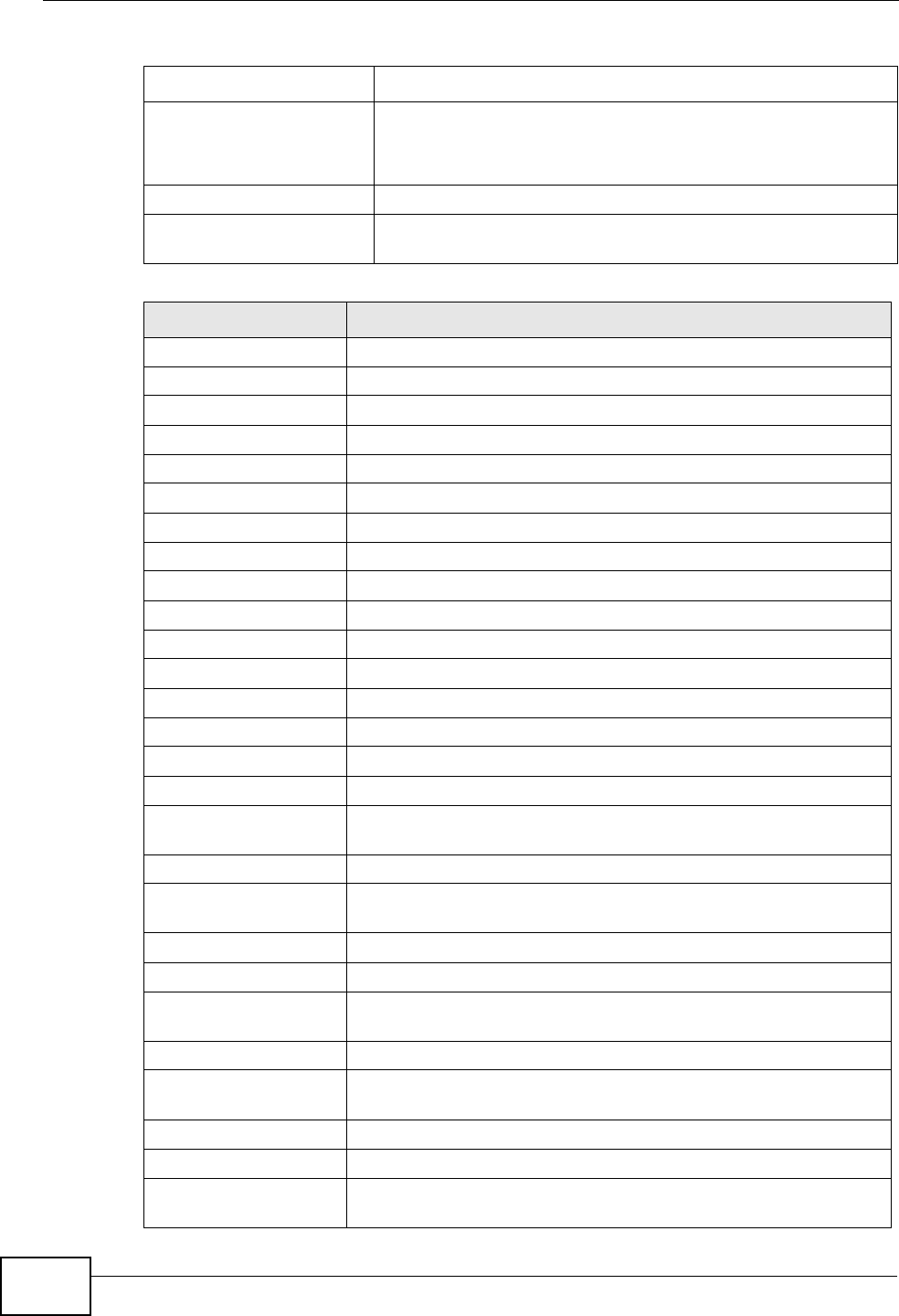
Chapter 20 Product Specifications
MAX-207HW2R User’s Guide
176
Fax Support T.38 FAX relay (FAX over UDP).
G.711 fax relay for fax calls and be able to renegotiate codec
to G.711 if a fax call is detected.
Ring Tones Supports different distinctive ring tones on each line.
Call Prioritization Prioritize VoIP traffic originating from the RJ-11 ports over
any other traffic.
Table 69 Standards Supported
STANDARD DESCRIPTION
RFC 768 User Datagram Protocol
RFC 791 Internet Protocol v4
RFC 792 Internet Control Message Protocol
RFC 792 Transmission Control Protocol
RFC 826 Address Resolution Protocol
RFC 854 Telnet Protocol
RFC 1349 Type of Service Protocol
RFC 1706 DNS NSAP Resource Records
RFC 1889 Real-time Transport Protocol (RTP)
RFC 1890 Real-time Transport Control Protocol (RTCP)
RFC 2030 Simple Network Time Protocol
RFC 2104 HMAC: Keyed-Hashing for Message Authentication
RFC 2131 Dynamic Host Configuration Protocol
RFC 2401 Security Architecture for the Internet Protocol
RFC 2409 Internet Key Exchange
RFC 2475 Architecture for Differentiated Services (Diffserv)
RFC 2617 Hypertext Transfer Protocol (HTTP) Authentication: Basic and
Digest Access Authentication
RFC 2782 A DNS RR for specifying the location of services (DNS SRV)
RFC 2833 Real-time Transport Protocol Payload for DTMF Digits, Telephony
Tones and Telephony Signals
RFC 2976 The SIP INFO Method
RFC 3261 Session Initiation Protocol (SIP version 2)
RFC 3262 Reliability of Provisional Responses in the Session Initiation
Protocol (SIP).
RFC 3263 Session Initiation Protocol (SIP): Locating SIP Servers
RFC 3264 An Offer/Answer Model with the Session Description Protocol
(SDP)
RFC 3265 Session Initiation Protocol (SIP)-Specific Event Notification
RFC 3323 A Privacy Mechanism for SIP
RFC 3325 Private Extensions to the Session Initiation Protocol (SIP) for
Asserted Identity within Trusted Networks
Table 68 Firmware Specifications (continued)
FEATURE DESCRIPTION

Chapter 20 Product Specifications
MAX-207HW2R User’s Guide 177
RFC 3550 RTP - A Real Time Protocol for Real-Time Applications
RFC 3581 An Extension to the Session Initiation Protocol (SIP) for
Symmetric Response Routing
RFC 3611 RTP Control Protocol Extended Reports (RTCP XR)-XR
RFC 3715 IP Sec/NAT Compatibility
RFC 3842 A Message Summary and Message Waiting Indication Event
Package for the Session Initiation Protocol (SIP)
IEEE 802.3 10BASE5 10 Mbit/s (1.25 MB/s)
IEEE 802.3u 100BASE-TX, 100BASE-T4, 100BASE-FX Fast Ethernet at 100
Mbit/s (12.5 MB/s) with auto-negotiation
Table 70 Voice Features
Call Park and
Pickup Call park and pickup lets you put a call on hold (park) and then
continue the call (pickup). The caller must still pay while the call is
parked.
When you park the call, you enter a number of your choice (up to
eight digits), which you must enter again when you pick up the call. If
you do not enter the correct number, you cannot pickup the call. This
means that only someone who knows the number you have chosen
can pick up the call.
You can have more than one call on hold at the same time, but you
must give each call a different number.
Call Return With call return, you can place a call to the last number that called
you (either answered or missed). The last incoming call can be
through either SIP or PSTN.
Country Code Phone standards and settings differ from one country to another, so
the settings on your MAX-207HW2R must be configured to match
those of the country you are in. The country code feature allows you
to do this by selecting the country from a list rather than changing
each setting manually. Configure the country code feature when you
move the MAX-207HW2R from one country to another.
Do not Disturb
(DnD) This feature allows you to set your phone not to ring when someone
calls you. You can set each phone independently using its keypad, or
configure global settings for all phones using the command line
interpreter.
Auto Dial You can set the MAX-207HW2R to automatically dial a specified
number immediately whenever you lift a phone off the hook. Use the
Web Configurator to set the specified number. Use the command line
interpreter to have the MAX-207HW2R wait a specified length of time
before dialing the number.
Phone config The phone configuration table allows you to customize the phone
keypad combinations you use to access certain features on the MAX-
207HW2R, such as call waiting, call return, call forward, etc. The
phone configuration table is configurable in command interpreter
mode.
Table 69 Standards Supported (continued)
STANDARD DESCRIPTION

Chapter 20 Product Specifications
MAX-207HW2R User’s Guide
178
Firmware update
enable / disable If your service provider uses this feature, you hear a recorded
message when you pick up the phone when new firmware is available
for your MAX-207HW2R. Enter *99# in your phone’s keypad to have
the MAX-207HW2R upgrade the firmware, or enter #99# to not
upgrade. If your service provider gave you different numbers to use,
enter them instead. If you enter the code to not upgrade, you can
make a call as normal. You will hear the recording again each time
you pick up the phone, until you upgrade.
Call waiting This feature allows you to hear an alert when you are already using
the phone and another person calls you. You can then either reject
the new incoming call, put your current call on hold and receive the
new incoming call, or end the current call and receive the new
incoming call.
Call forwarding With this feature, you can set the MAX-207HW2R to forward calls to a
specified number, either unconditionally (always), when your number
is busy, or when you do not answer. You can also forward incoming
calls from one specified number to another.
Caller ID The MAX-207HW2R supports caller ID, which allows you to see the
originating number of an incoming call (on a phone with a suitable
display).
REN A Ringer Equivalence Number (REN) is used to determine the number
of devices (like telephones or fax machines) that may be connected
to the telephone line. Your device has a REN of three, so it can
support three devices per telephone port.
QoS (Quality of
Service) Quality of Service (QoS) mechanisms help to provide better service
on a per-flow basis. Your device supports Type of Service (ToS)
tagging and Differentiated Services (DiffServ) tagging. This allows
the device to tag voice frames so they can be prioritized over the
network.
SIP ALG Your device is a SIP Application Layer Gateway (ALG). It allows VoIP
calls to pass through NAT for devices behind it (such as a SIP-based
VoIP software application on a computer).
Other Voice
Features SIP version 2 (Session Initiating Protocol RFC 3261)
SDP (Session Description Protocol RFC 2327)
RTP (RFC 1889)
RTCP (RFC 1890)
Voice codecs (coder/decoders) G.711, G.726, G.729
Fax and data modem discrimination
DTMF Detection and Generation
DTMF: In-band and Out-band traffic (RFC 2833),(PCM), (SIP INFO)
Point-to-point call establishment between two IADs
Quick dialing through predefined phone book, which maps the phone
dialing number and destination URL.
Flexible Dial Plan (RFC3525 section 7.1.14)
Table 70 Voice Features

Chapter 20 Product Specifications
MAX-207HW2R User’s Guide 179
Note: To take full advantage of the supplementary phone services available through
the MAX-207HW2R's phone port, you may need to subscribe to the services
from your voice account service provider.
Not all features are supported by all service providers. Consult your service
provider for more information.
Table 71 Star (*) and Pound (#) Code Support
*0 Wireless Operator Services
*2 Customer Care Access
*66 Repeat Dialing
*67 Plus the 10 digit phone number to block Caller ID on a single call
basis
*69 Return last call received
*70 Followed by the 10 digit phone number to cancel Call Waiting on a
single call basis
*72 Activate Call Forwarding (*72 followed by the 10 digit phone number
that is requesting call forwarding service)
*720 Activate Call Forwarding (*720 followed by the 10 digit phone number
that is requesting deactivation of call forwarding service)
*73 Plus the forward to phone number to activate Call Forwarding No
Answer (no VM service plan)
*730 Deactivate Call Forwarding No Answer
*740 Plus the forward to phone number to activate Call Forwarding Busy
(no VM service plan)
*911/911 Emergency phone number (same as dialing 911)
*411/411 Wireless Information Services

Chapter 20 Product Specifications
MAX-207HW2R User’s Guide
180
20.1 Wall-Mounting
This section shows you how to mount your MAX-207HW2R on a wall using the
ZyXEL Wall-Mounting kit (not included).
20.1.1 The Wall-Mounting Kit
The wall-mounting kit contains the following parts:
1Two Mortar Plugs (M4*L30 mm)
2Two Screws (M4*L30 mm)
3Wall-Mounting Chassis
If any parts are missing, contact your vendor.
20.1.2 Instructions
To mount the MAX-207HW2R on a wall:
1Select a position free of obstructions on a sturdy wall.
2Drill two holes in the wall exactly 70 mm apart. The holes should be 6 mm wide
and at least 30 mm deep.
Be careful to avoid damaging pipes or cables located inside the
wall when drilling holes for the screws.
12 3
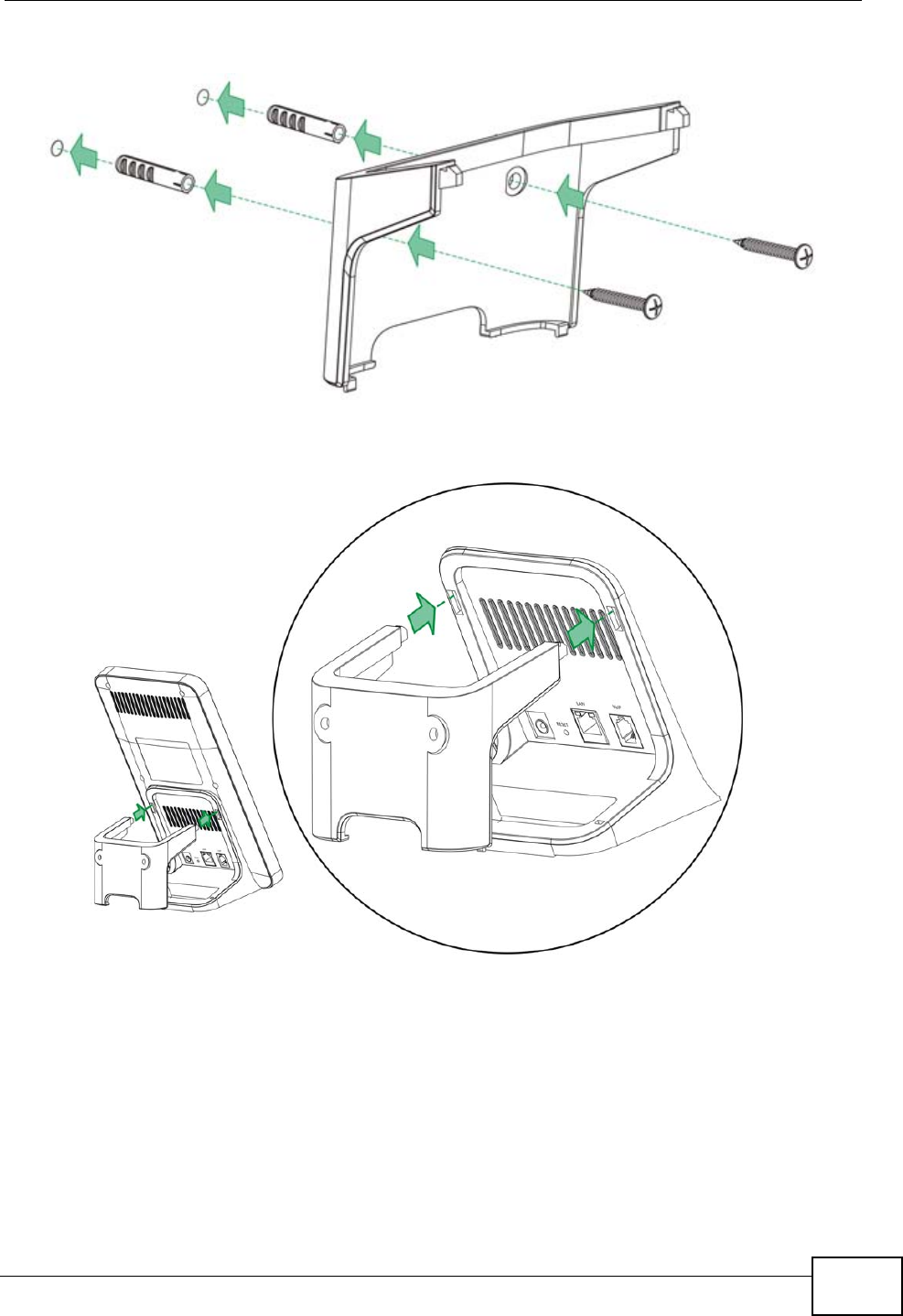
Chapter 20 Product Specifications
MAX-207HW2R User’s Guide 181
3Attach the wall mounting chassis with the plugs and screws as shown below:
4Connect the MAX-207HW2R to the wall mounting chassis by snapping the chassis’
two upper chassis hooks into the matching holes on the MAX-207HW2R:
Do not pinch or server the cable connections between the wall-
mounting chassis the MAX-207HW2R.
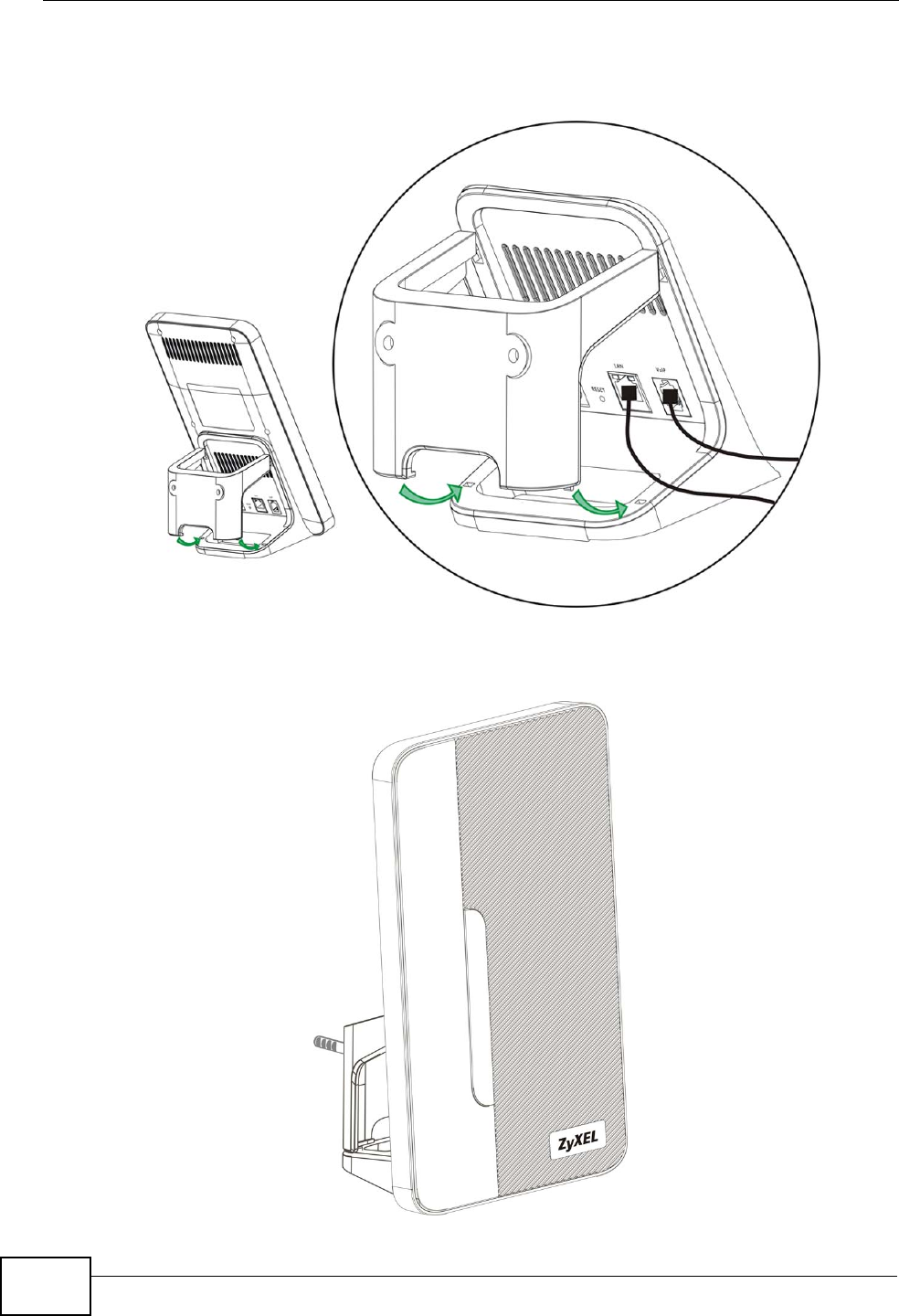
Chapter 20 Product Specifications
MAX-207HW2R User’s Guide
182
5Snap the lower chassis hooks into the matching holes on the MAX-207HW2R. The
cable connections should come out either the left or right gaps between the wall-
mounting chassis and the MAX-207HW2R
6Once you have snapped the wall-mounting chassis in place, the MAX-207HW2R is
securely fastened to the wall.

MAX-207HW2R User’s Guide 183
APPENDIX A
WiMAX Security
Wireless security is vital to protect your wireless communications. Without it,
information transmitted over the wireless network would be accessible to any
networking device within range.
User Authentication and Data Encryption
The WiMAX (IEEE 802.16) standard employs user authentication and encryption to
ensure secured communication at all times.
User authentication is the process of confirming a user’s identity and level of
authorization. Data encryption is the process of encoding information so that it
cannot be read by anyone who does not know the code.
WiMAX uses PKMv2 (Privacy Key Management version 2) for authentication, and
CCMP (Counter Mode with Cipher Block Chaining Message Authentication Protocol)
for data encryption.
WiMAX supports EAP (Extensible Authentication Protocol, RFC 2486) which allows
additional authentication methods to be deployed with no changes to the base
station or the mobile or subscriber stations.
PKMv2
PKMv2 is a procedure that allows authentication of a mobile or subscriber station
and negotiation of a public key to encrypt traffic between the MS/SS and the base
station. PKMv2 uses standard EAP methods such as Transport Layer Security
(EAP-TLS) or Tunneled TLS (EAP-TTLS) for secure communication.
In cryptography, a ‘key’ is a piece of information, typically a string of random
numbers and letters, that can be used to ‘lock’ (encrypt) or ‘unlock’ (decrypt) a
message. Public key encryption uses key pairs, which consist of a public (freely
available) key and a private (secret) key. The public key is used for encryption and
the private key is used for decryption. You can decrypt a message only if you have
the private key. Public key certificates (or ‘digital IDs’) allow users to verify each
other’s identity.

Appendix A WiMAX Security
MAX-207HW2R User’s Guide
184
RADIUS
RADIUS is based on a client-server model that supports authentication,
authorization and accounting. The base station is the client and the server is the
RADIUS server. The RADIUS server handles the following tasks:
• Authentication
Determines the identity of the users.
• Authorization
Determines the network services available to authenticated users once they are
connected to the network.
•Accounting
Keeps track of the client’s network activity.
RADIUS is a simple package exchange in which your base station acts as a
message relay between the MS/SS and the network RADIUS server.
Types of RADIUS Messages
The following types of RADIUS messages are exchanged between the base station
and the RADIUS server for user authentication:
• Access-Request
Sent by an base station requesting authentication.
• Access-Reject
Sent by a RADIUS server rejecting access.
• Access-Accept
Sent by a RADIUS server allowing access.
• Access-Challenge
Sent by a RADIUS server requesting more information in order to allow access.
The base station sends a proper response from the user and then sends another
Access-Request message.
The following types of RADIUS messages are exchanged between the base station
and the RADIUS server for user accounting:
•Accounting-Request
Sent by the base station requesting accounting.
• Accounting-Response
Sent by the RADIUS server to indicate that it has started or stopped accounting.
In order to ensure network security, the access point and the RADIUS server use a
shared secret key, which is a password they both know. The key is not sent over

Appendix A WiMAX Security
MAX-207HW2R User’s Guide 185
the network. In addition to the shared key, password information exchanged is
also encrypted to protect the network from unauthorized access.
Diameter
Diameter (RFC 3588) is a type of AAA server that provides several improvements
over RADIUS in efficiency, security, and support for roaming.
Security Association
The set of information about user authentication and data encryption between two
computers is known as a security association (SA). In a WiMAX network, the
process of security association has three stages.
• Authorization request and reply
The MS/SS presents its public certificate to the base station. The base station
verifies the certificate and sends an authentication key (AK) to the MS/SS.
• Key request and reply
The MS/SS requests a transport encryption key (TEK) which the base station
generates and encrypts using the authentication key.
• Encrypted traffic
The MS/SS decrypts the TEK (using the authentication key). Both stations can
now securely encrypt and decrypt the data flow.
CCMP
All traffic in a WiMAX network is encrypted using CCMP (Counter Mode with Cipher
Block Chaining Message Authentication Protocol). CCMP is based on the 128-bit
Advanced Encryption Standard (AES) algorithm.
‘Counter mode’ refers to the encryption of each block of plain text with an
arbitrary number, known as the counter. This number changes each time a block
of plain text is encrypted. Counter mode avoids the security weakness of repeated
identical blocks of encrypted text that makes encrypted data vulnerable to
pattern-spotting.
‘Cipher Block Chaining Message Authentication’ (also known as CBC-MAC) ensures
message integrity by encrypting each block of plain text in such a way that its
encryption is dependent on the block before it. This series of ‘chained’ blocks
creates a message authentication code (MAC or CMAC) that ensures the encrypted
data has not been tampered with.

Appendix A WiMAX Security
MAX-207HW2R User’s Guide
186
Authentication
The MAX-207HW2R supports EAP-TTLS authentication.
EAP-TTLS (Tunneled Transport Layer Service)
EAP-TTLS is an extension of the EAP-TLS authentication that uses certificates for
only the server-side authentications to establish a secure connection (with EAP-
TLS digital certifications are needed by both the server and the wireless clients for
mutual authentication). Client authentication is then done by sending username
and password through the secure connection, thus client identity is protected. For
client authentication, EAP-TTLS supports EAP methods and legacy authentication
methods such as PAP, CHAP, MS-CHAP and MS-CHAP v2.

MAX-207HW2R User’s Guide 187
APPENDIX B
Setting Up Your Computer’s IP
Address
Note: Your specific ZyXEL device may not support all of the operating systems
described in this appendix. See the product specifications for more information
about which operating systems are supported.
This appendix shows you how to configure the IP settings on your computer in
order for it to be able to communicate with the other devices on your network.
Windows Vista/XP/2000, Mac OS 9/OS X, and all versions of UNIX/LINUX include
the software components you need to use TCP/IP on your computer.
If you manually assign IP information instead of using a dynamic IP, make sure
that your network’s computers have IP addresses that place them in the same
subnet.
In this appendix, you can set up an IP address for:
•Windows XP/NT/2000 on page 188
•Windows Vista on page 191
•Mac OS X: 10.3 and 10.4 on page 195
•Mac OS X: 10.5 on page 199
•Linux: Ubuntu 8 (GNOME) on page 202
•Linux: openSUSE 10.3 (KDE) on page 208
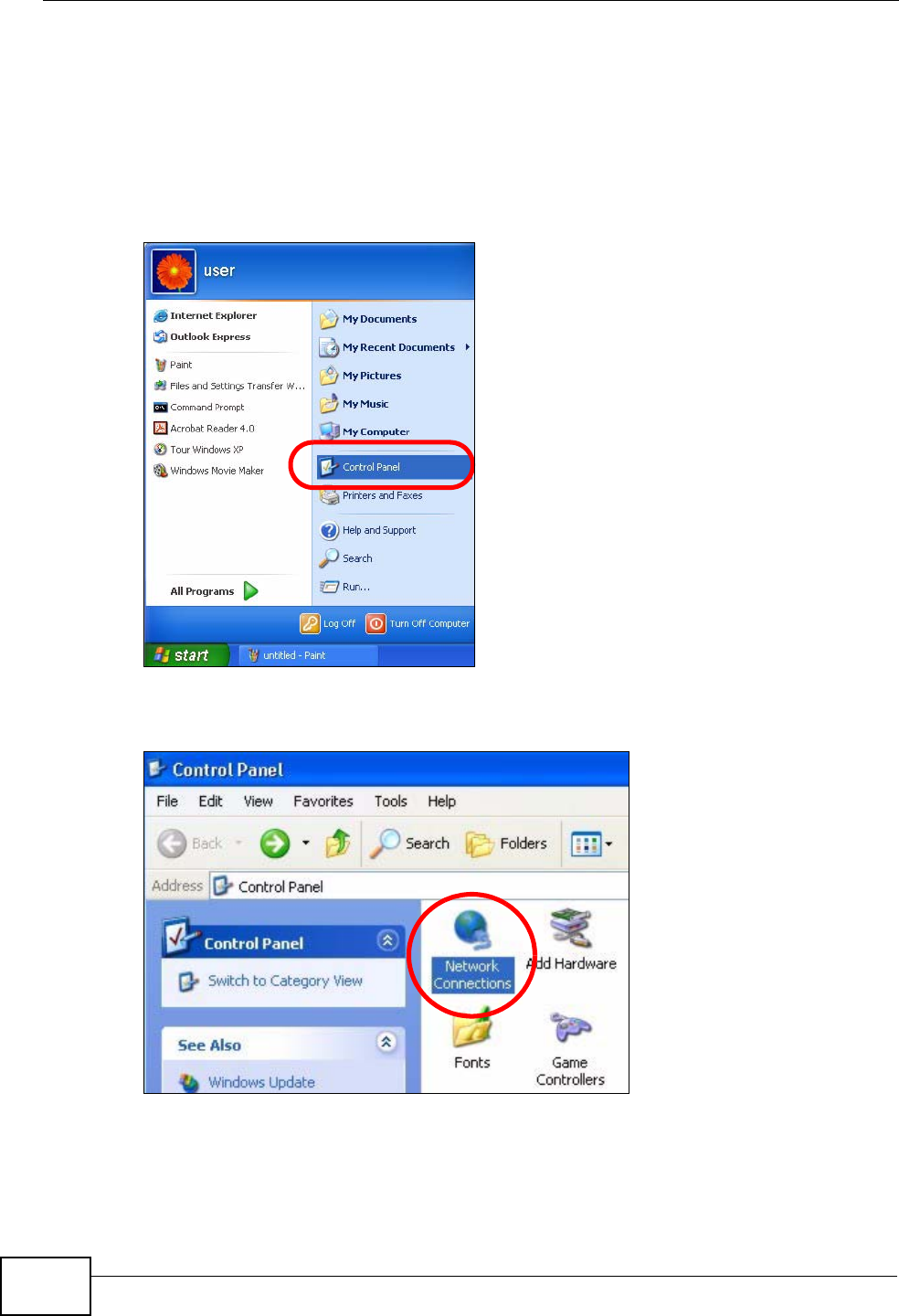
Appendix B Setting Up Your Computer’s IP Address
MAX-207HW2R User’s Guide
188
Windows XP/NT/2000
The following example uses the default Windows XP display theme but can also
apply to Windows 2000 and Windows NT.
1Click Start > Control Panel.
Figure 74 Windows XP: Start Menu
2In the Control Panel, click the Network Connections icon.
Figure 75 Windows XP: Control Panel
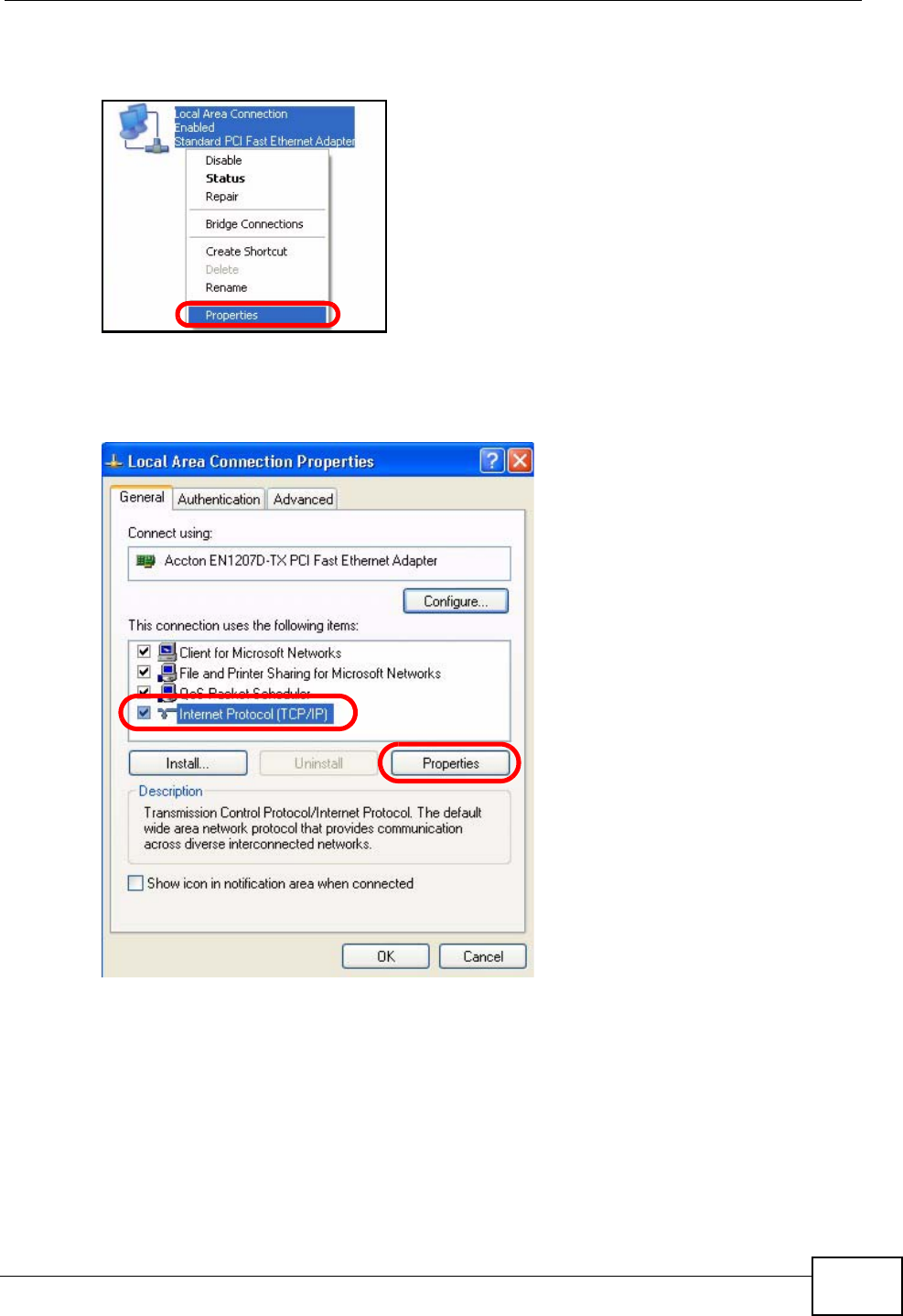
Appendix B Setting Up Your Computer’s IP Address
MAX-207HW2R User’s Guide 189
3Right-click Local Area Connection and then select Properties.
Figure 76 Windows XP: Control Panel > Network Connections > Properties
4On the General tab, select Internet Protocol (TCP/IP) and then click
Properties.
Figure 77 Windows XP: Local Area Connection Properties
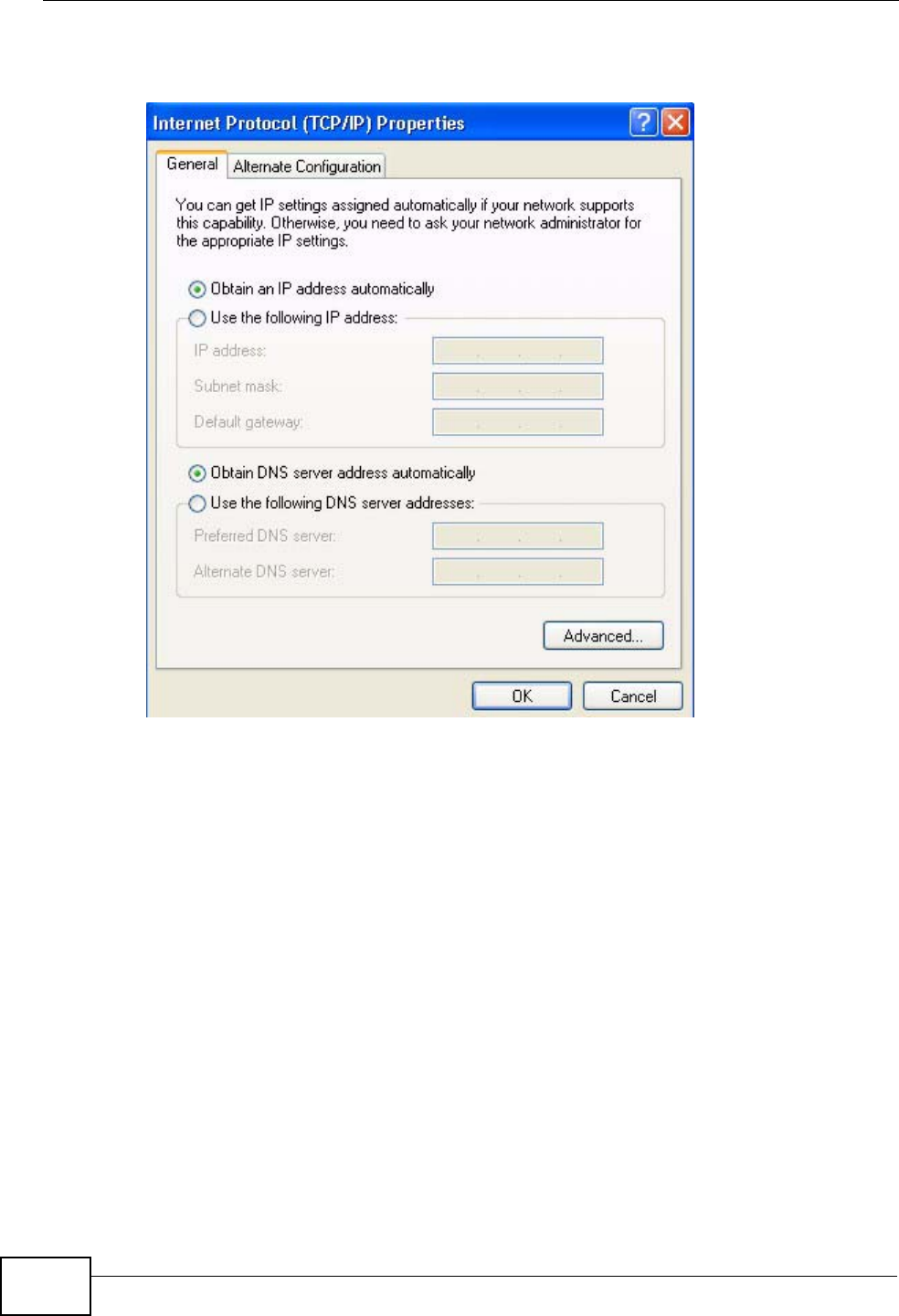
Appendix B Setting Up Your Computer’s IP Address
MAX-207HW2R User’s Guide
190
5The Internet Protocol TCP/IP Properties window opens.
Figure 78 Windows XP: Internet Protocol (TCP/IP) Properties
6Select Obtain an IP address automatically if your network administrator or ISP
assigns your IP address dynamically.
Select Use the following IP Address and fill in the IP address, Subnet mask,
and Default gateway fields if you have a static IP address that was assigned to
you by your network administrator or ISP. You may also have to enter a Preferred
DNS server and an Alternate DNS server, if that information was provided.
7Click OK to close the Internet Protocol (TCP/IP) Properties window.
Click OK to close the Local Area Connection Properties window.Verifying Settings
1Click Start > All Programs > Accessories > Command Prompt.
2In the Command Prompt window, type "ipconfig" and then press [ENTER].
You can also go to Start > Control Panel > Network Connections, right-click a
network connection, click Status and then click the Support tab to view your IP
address and connection information.
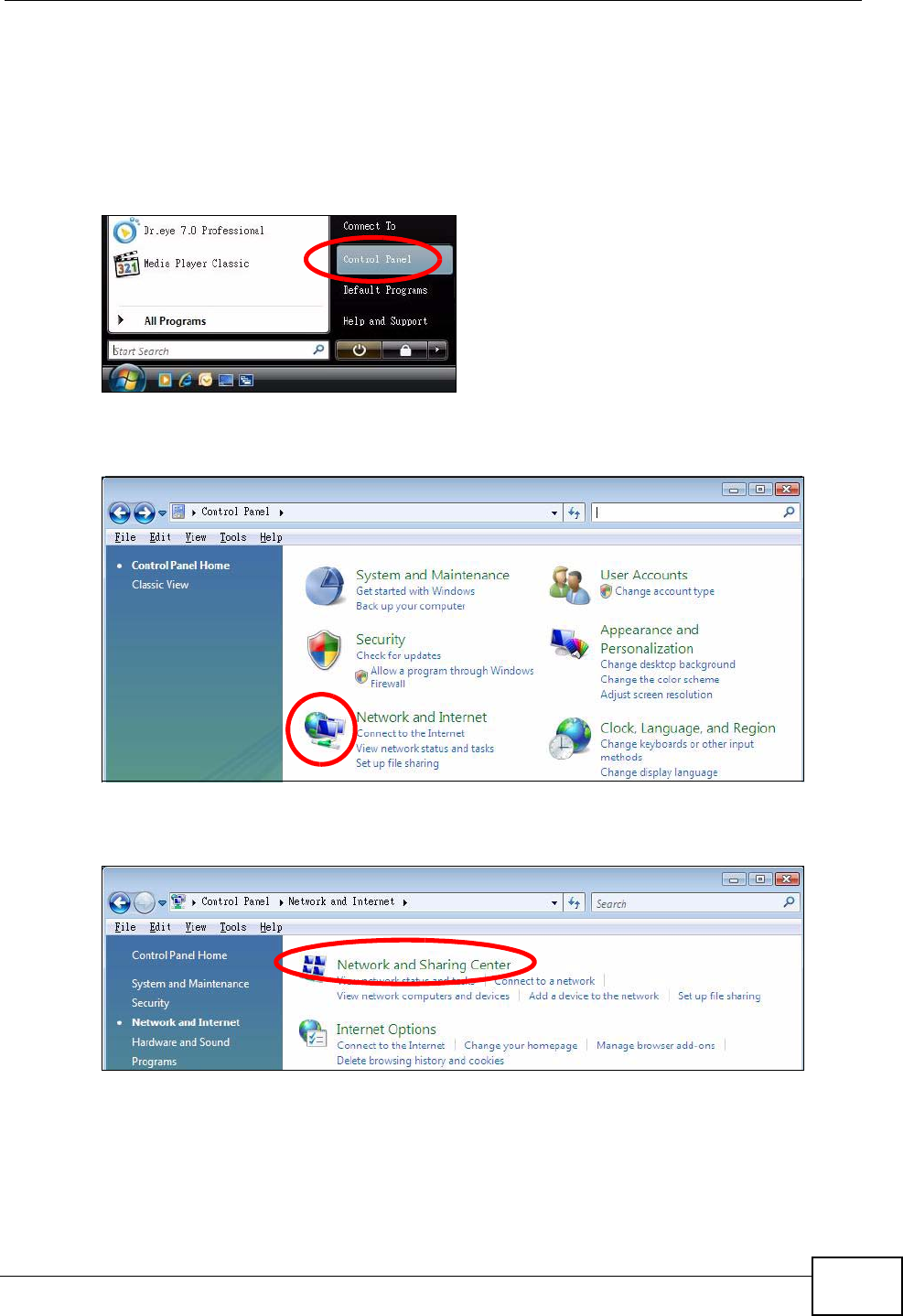
Appendix B Setting Up Your Computer’s IP Address
MAX-207HW2R User’s Guide 191
Windows Vista
This section shows screens from Windows Vista Professional.
1Click Start > Control Panel.
Figure 79 Windows Vista: Start Menu
2In the Control Panel, click the Network and Internet icon.
Figure 80 Windows Vista: Control Panel
3Click the Network and Sharing Center icon.
Figure 81 Windows Vista: Network And Internet
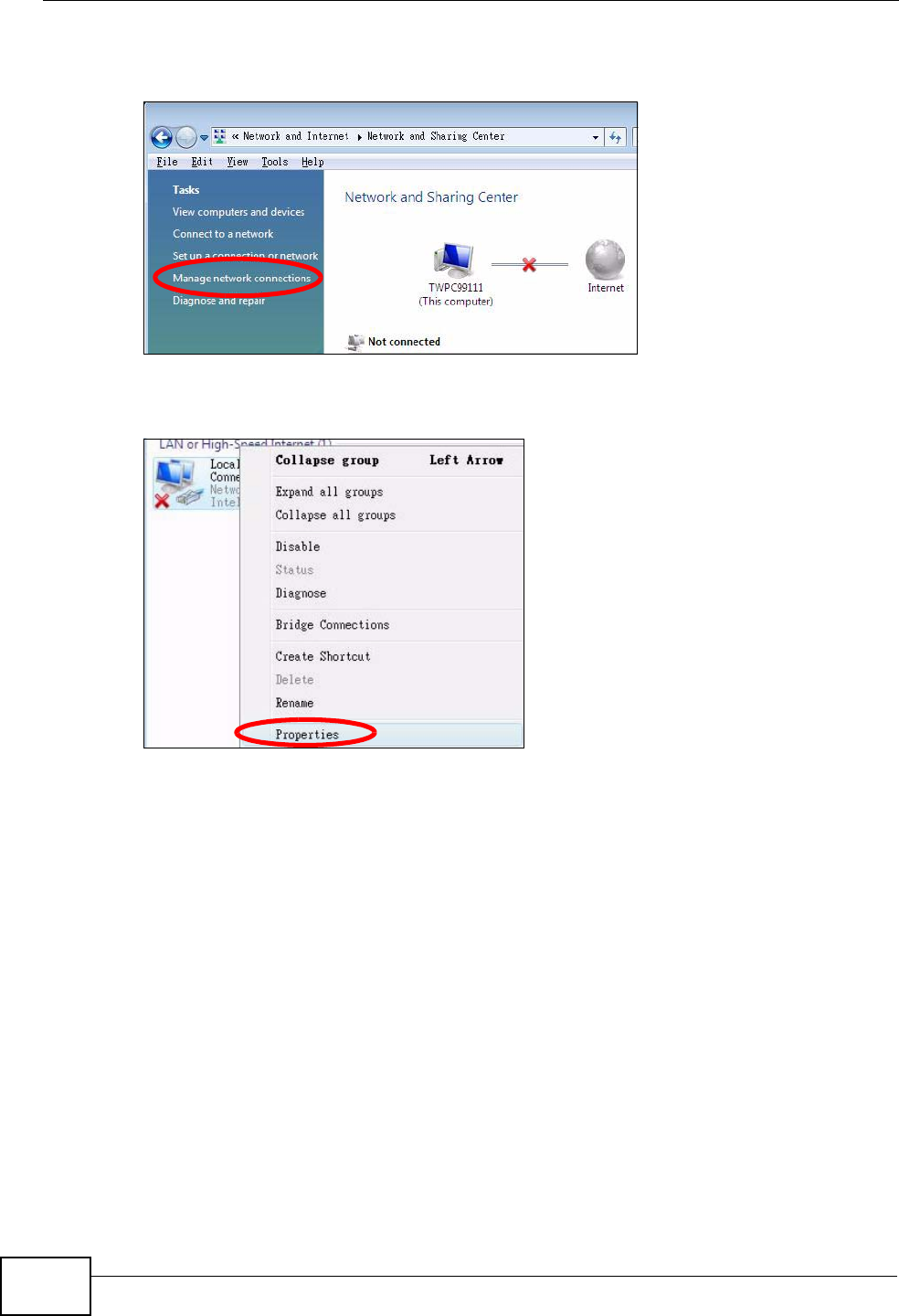
Appendix B Setting Up Your Computer’s IP Address
MAX-207HW2R User’s Guide
192
4Click Manage network connections.
Figure 82 Windows Vista: Network and Sharing Center
5Right-click Local Area Connection and then select Properties.
Figure 83 Windows Vista: Network and Sharing Center
Note: During this procedure, click Continue whenever Windows displays a screen
saying that it needs your permission to continue.
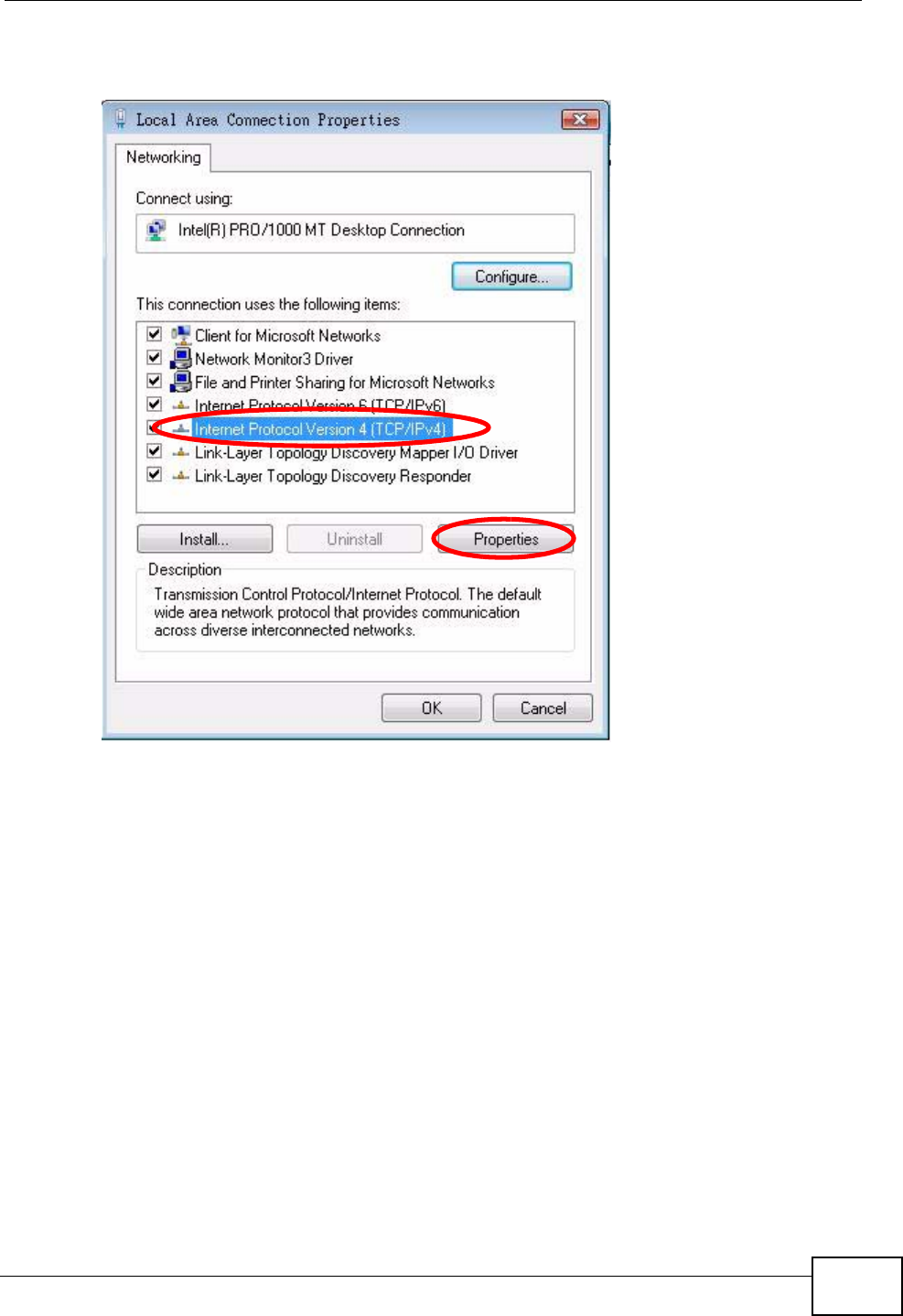
Appendix B Setting Up Your Computer’s IP Address
MAX-207HW2R User’s Guide 193
6Select Internet Protocol Version 4 (TCP/IPv4) and then select Properties.
Figure 84 Windows Vista: Local Area Connection Properties
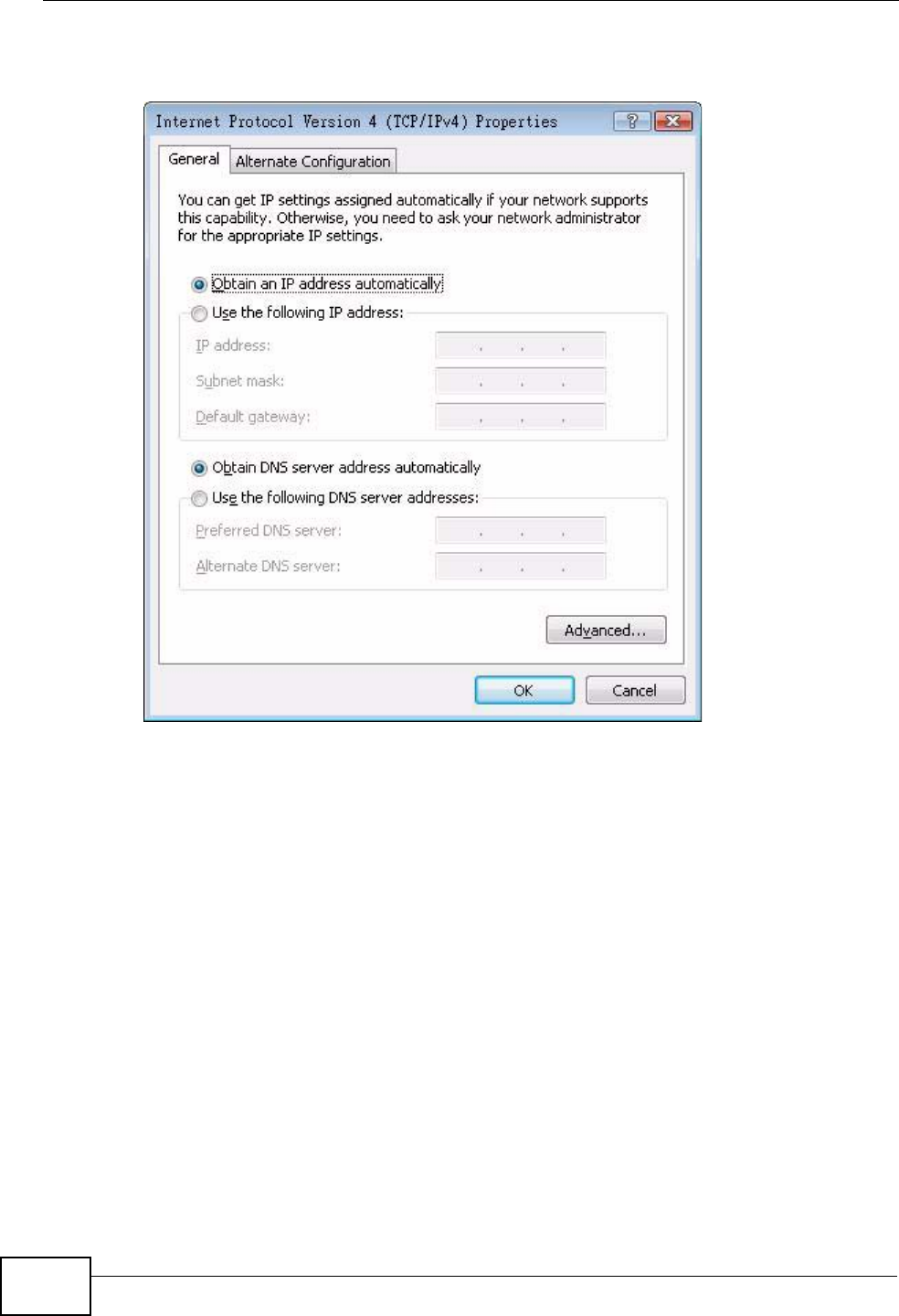
Appendix B Setting Up Your Computer’s IP Address
MAX-207HW2R User’s Guide
194
7The Internet Protocol Version 4 (TCP/IPv4) Properties window opens.
Figure 85 Windows Vista: Internet Protocol Version 4 (TCP/IPv4) Properties
8Select Obtain an IP address automatically if your network administrator or ISP
assigns your IP address dynamically.
Select Use the following IP Address and fill in the IP address, Subnet mask,
and Default gateway fields if you have a static IP address that was assigned to
you by your network administrator or ISP. You may also have to enter a Preferred
DNS server and an Alternate DNS server, if that information was
provided.Click Advanced.
9Click OK to close the Internet Protocol (TCP/IP) Properties window.
Click OK to close the Local Area Connection Properties window.Verifying Settings
1Click Start > All Programs > Accessories > Command Prompt.
2In the Command Prompt window, type "ipconfig" and then press [ENTER].
You can also go to Start > Control Panel > Network Connections, right-click a
network connection, click Status and then click the Support tab to view your IP
address and connection information.
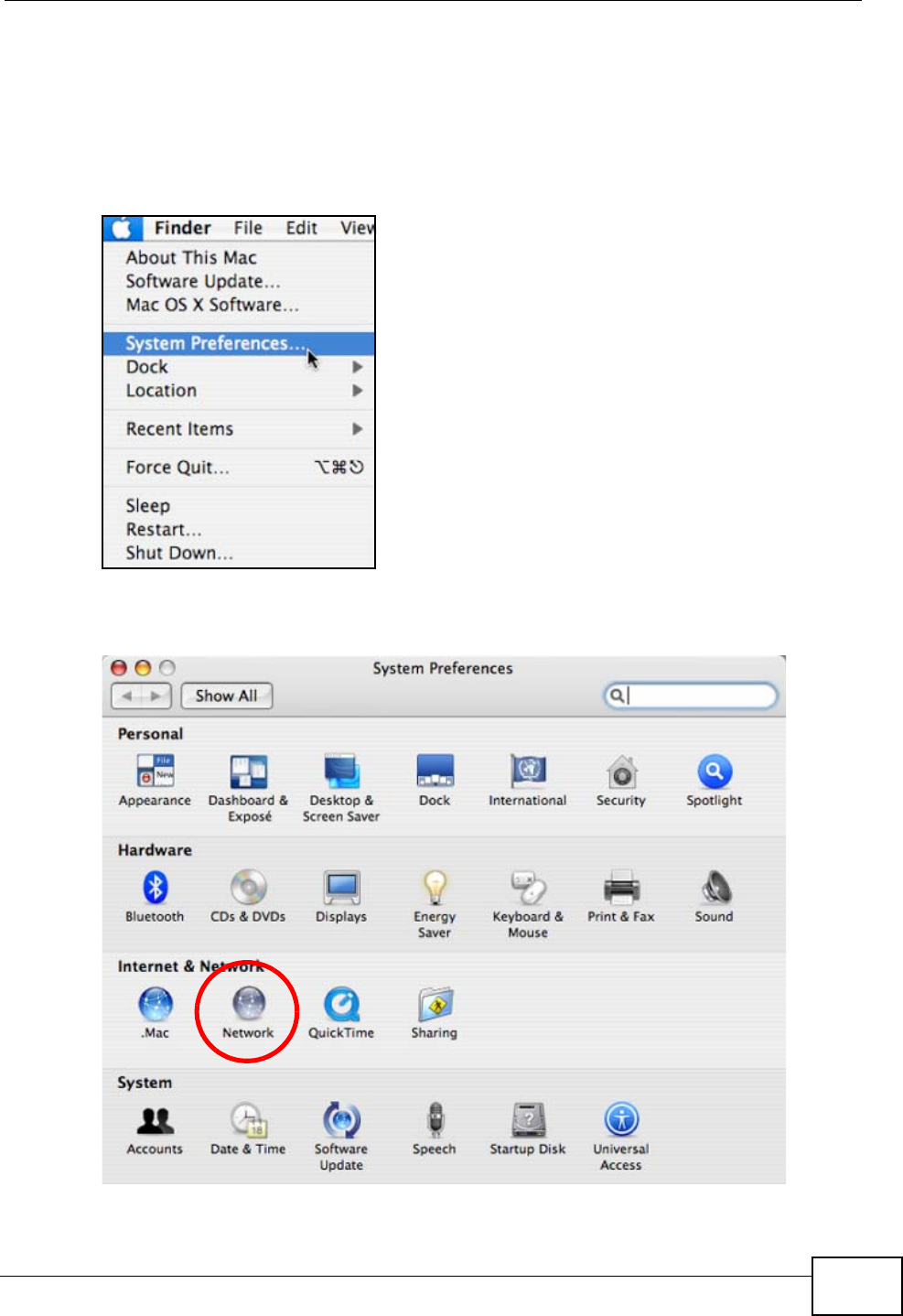
Appendix B Setting Up Your Computer’s IP Address
MAX-207HW2R User’s Guide 195
Mac OS X: 10.3 and 10.4
The screens in this section are from Mac OS X 10.4 but can also apply to 10.3.
1Click Apple > System Preferences.
Figure 86 Mac OS X 10.4: Apple Menu
2In the System Preferences window, click the Network icon.
Figure 87 Mac OS X 10.4: System Preferences
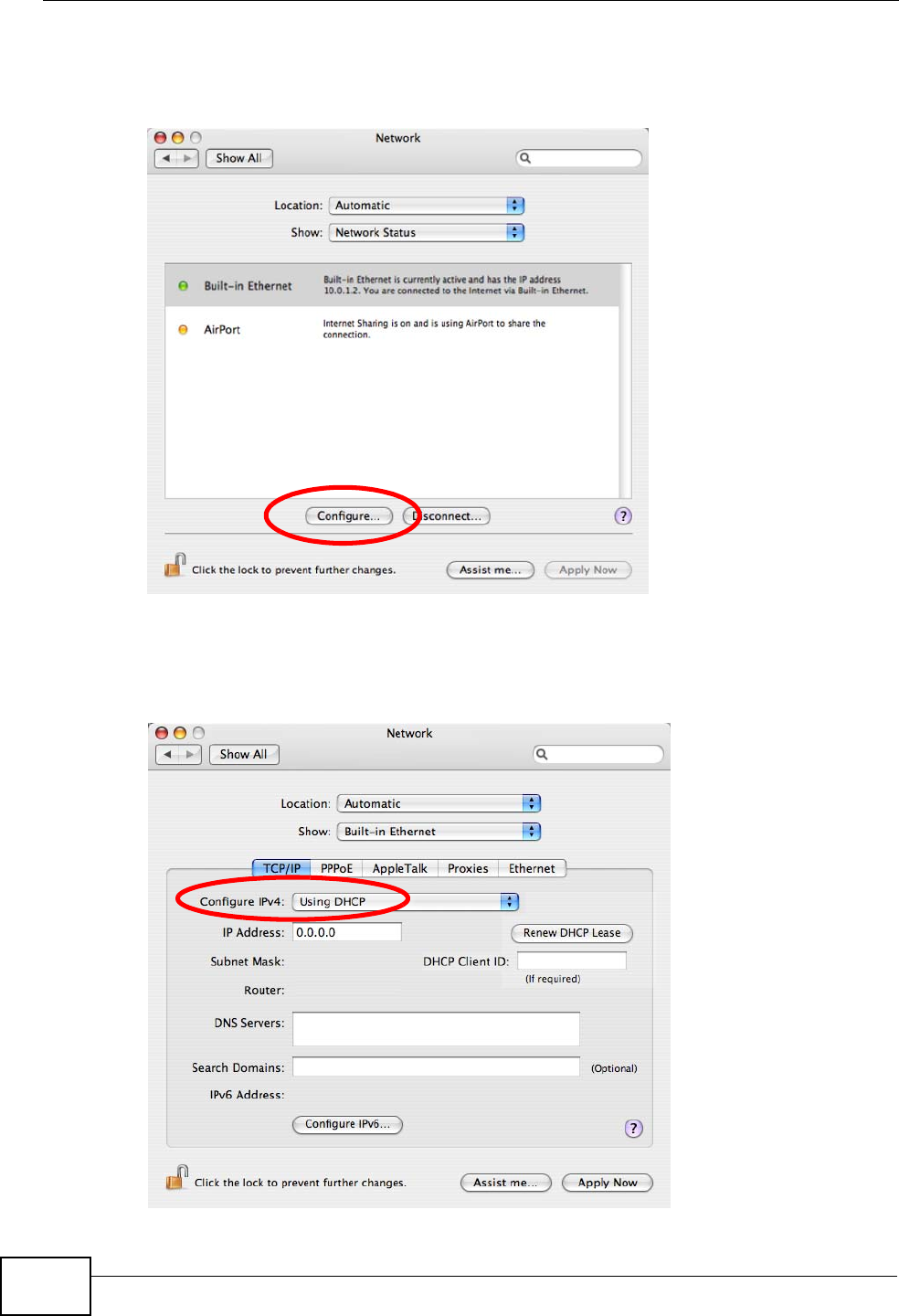
Appendix B Setting Up Your Computer’s IP Address
MAX-207HW2R User’s Guide
196
3When the Network preferences pane opens, select Built-in Ethernet from the
network connection type list, and then click Configure.
Figure 88 Mac OS X 10.4: Network Preferences
4For dynamically assigned settings, select Using DHCP from the Configure IPv4
list in the TCP/IP tab.
Figure 89 Mac OS X 10.4: Network Preferences > TCP/IP Tab.

Appendix B Setting Up Your Computer’s IP Address
MAX-207HW2R User’s Guide 197
5For statically assigned settings, do the following:
•From the Configure IPv4 list, select Manually.
•In the IP Address field, type your IP address.
•In the Subnet Mask field, type your subnet mask.
•In the Router field, type the IP address of your device.
Figure 90 Mac OS X 10.4: Network Preferences > Ethernet
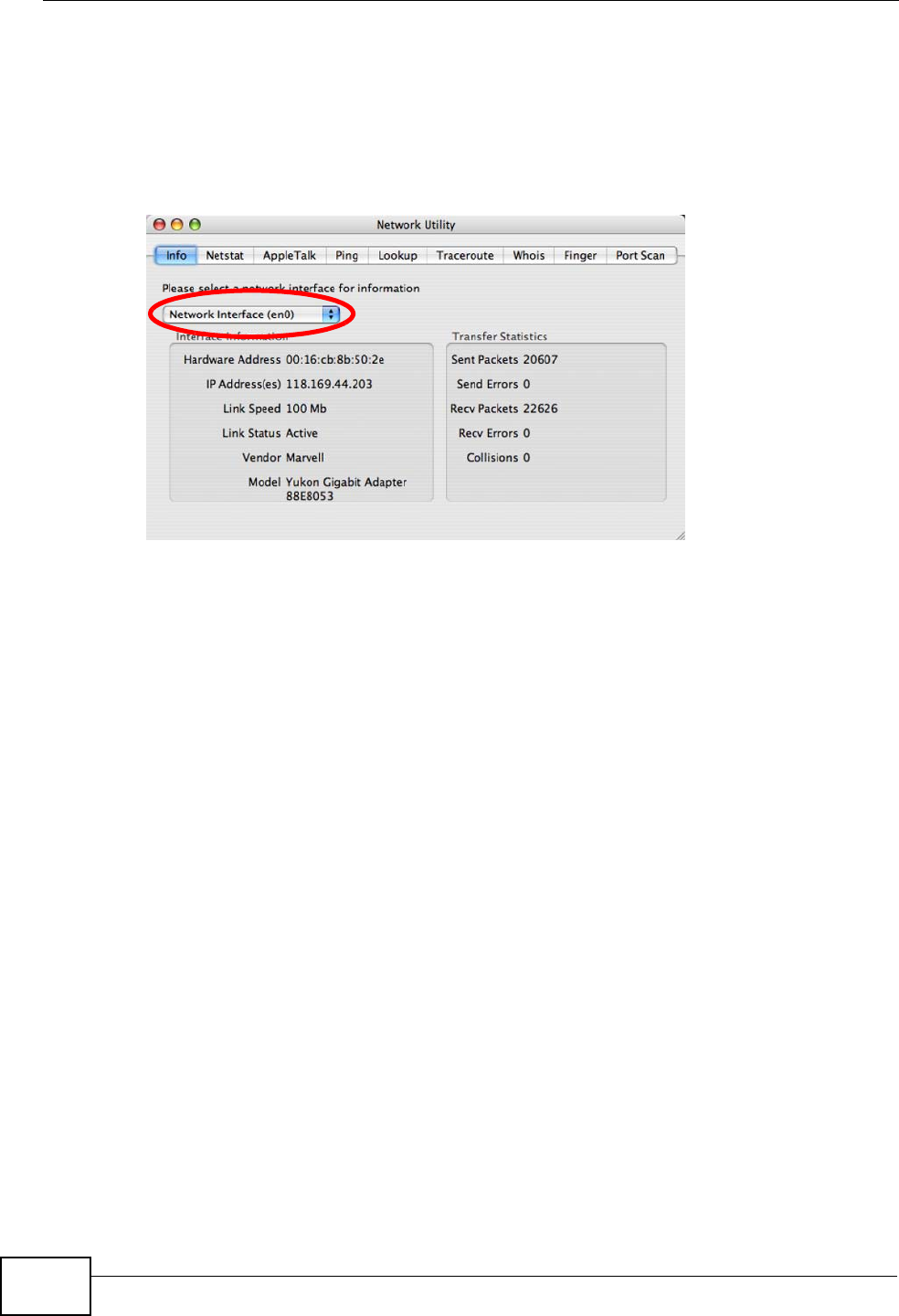
Appendix B Setting Up Your Computer’s IP Address
MAX-207HW2R User’s Guide
198
Click Apply Now and close the window.Verifying Settings
Check your TCP/IP properties by clicking Applications > Utilities > Network
Utilities, and then selecting the appropriate Network Interface from the Info
tab.
Figure 91 Mac OS X 10.4: Network Utility
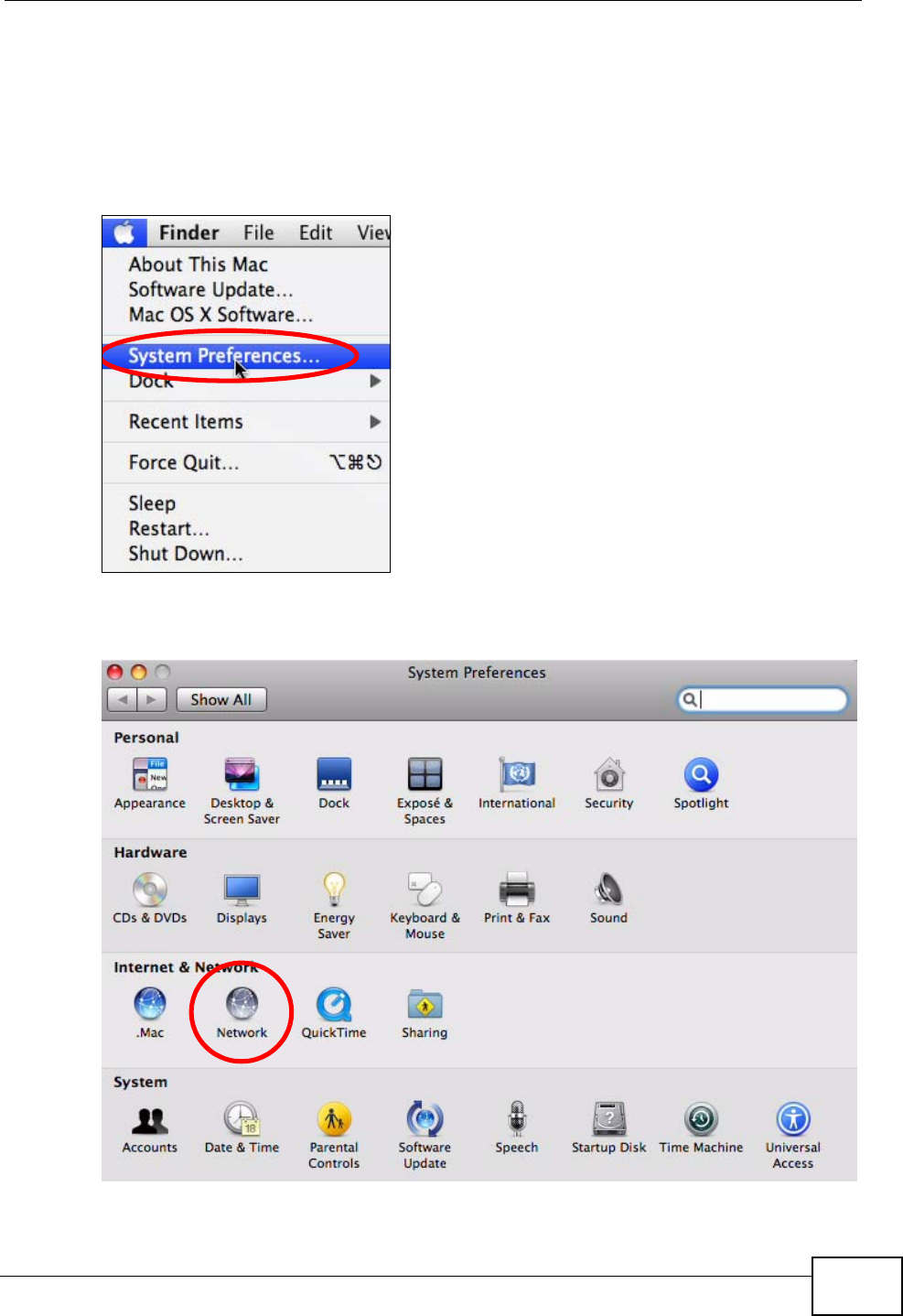
Appendix B Setting Up Your Computer’s IP Address
MAX-207HW2R User’s Guide 199
Mac OS X: 10.5
The screens in this section are from Mac OS X 10.5.
1Click Apple > System Preferences.
Figure 92 Mac OS X 10.5: Apple Menu
2In System Preferences, click the Network icon.
Figure 93 Mac OS X 10.5: Systems Preferences
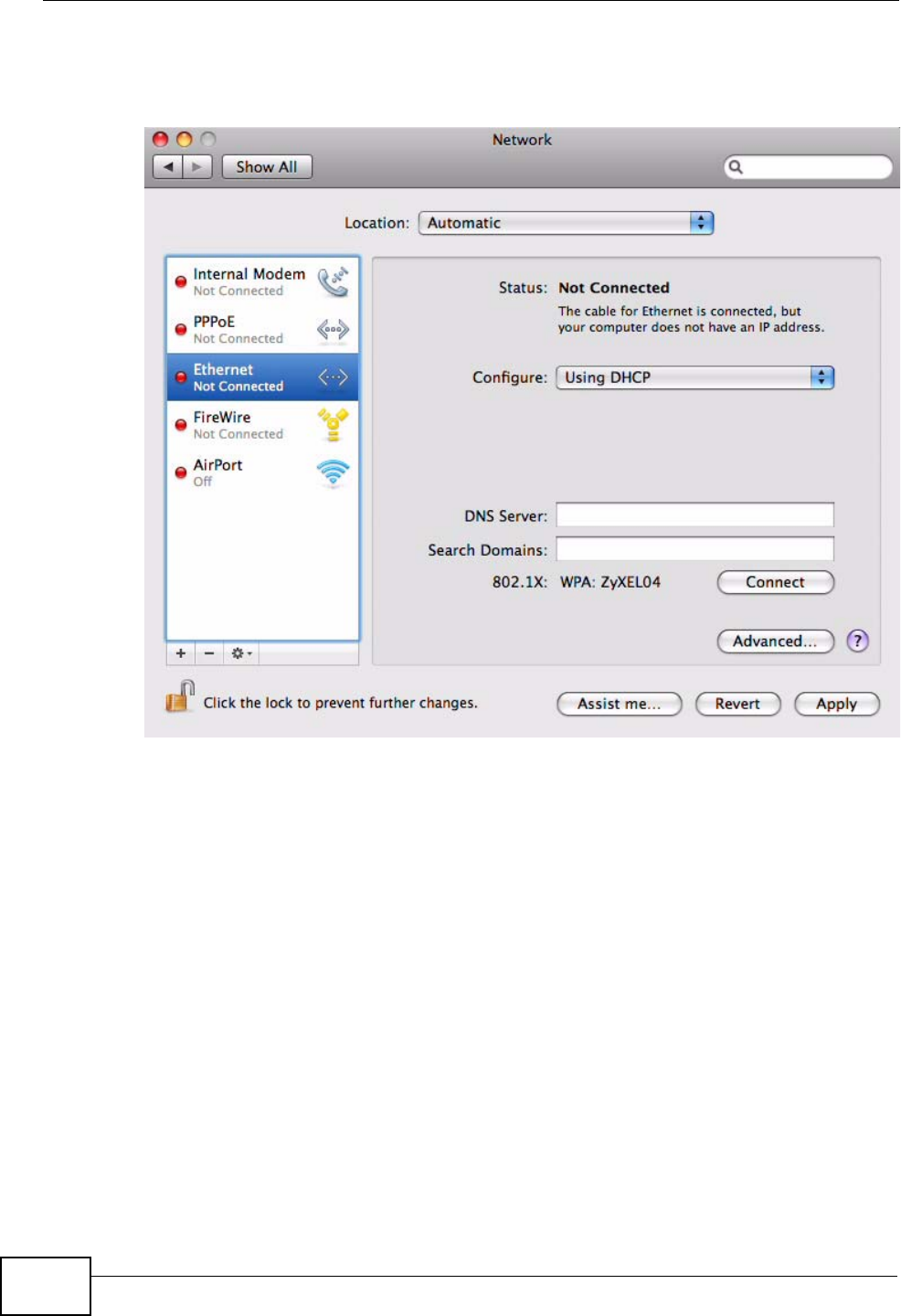
Appendix B Setting Up Your Computer’s IP Address
MAX-207HW2R User’s Guide
200
3When the Network preferences pane opens, select Ethernet from the list of
available connection types.
Figure 94 Mac OS X 10.5: Network Preferences > Ethernet
4From the Configure list, select Using DHCP for dynamically assigned settings.
5For statically assigned settings, do the following:
•From the Configure list, select Manually.
•In the IP Address field, enter your IP address.
•In the Subnet Mask field, enter your subnet mask.
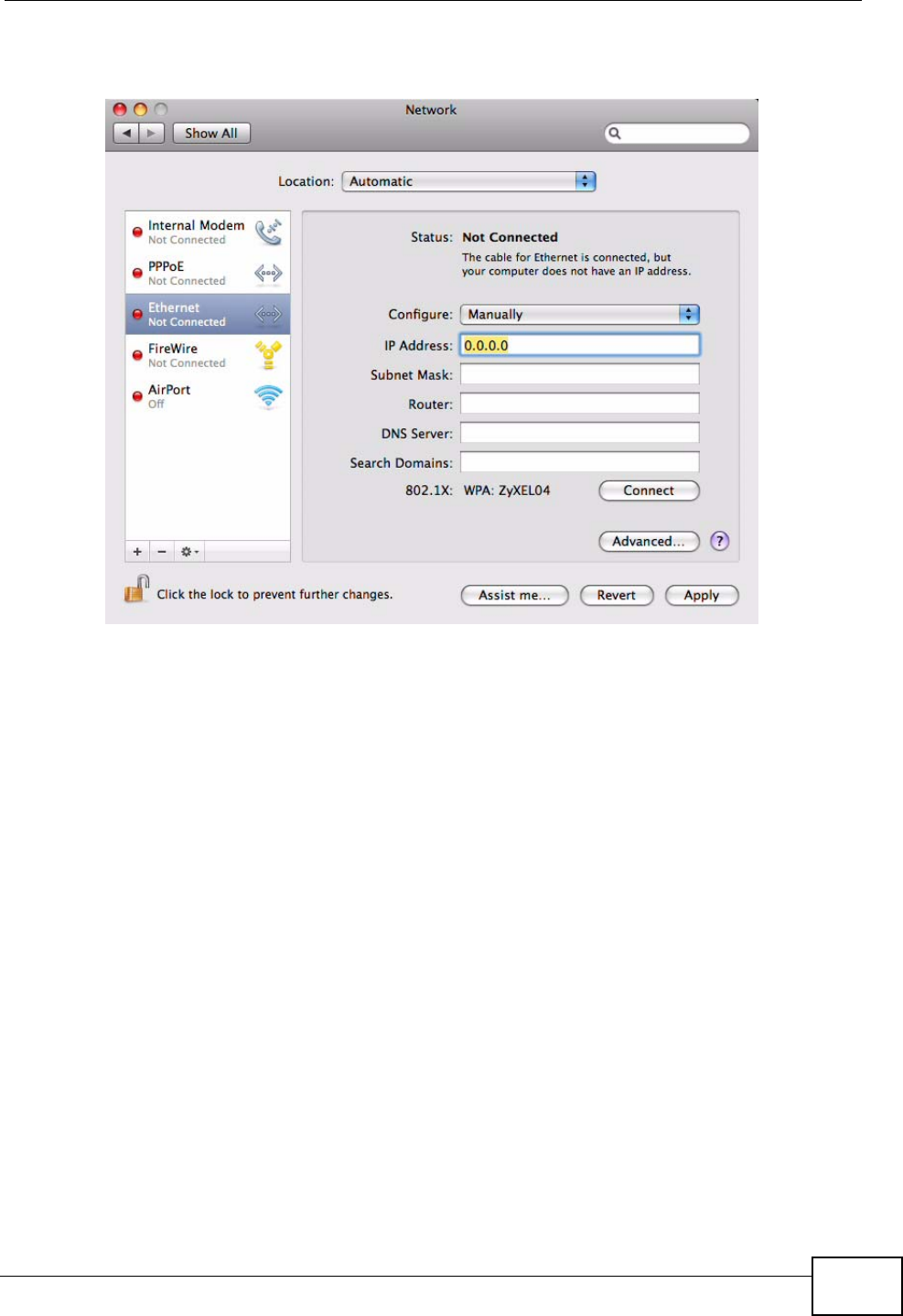
Appendix B Setting Up Your Computer’s IP Address
MAX-207HW2R User’s Guide 201
•In the Router field, enter the IP address of your MAX-207HW2R.
Figure 95 Mac OS X 10.5: Network Preferences > Ethernet
6Click Apply and close the window.
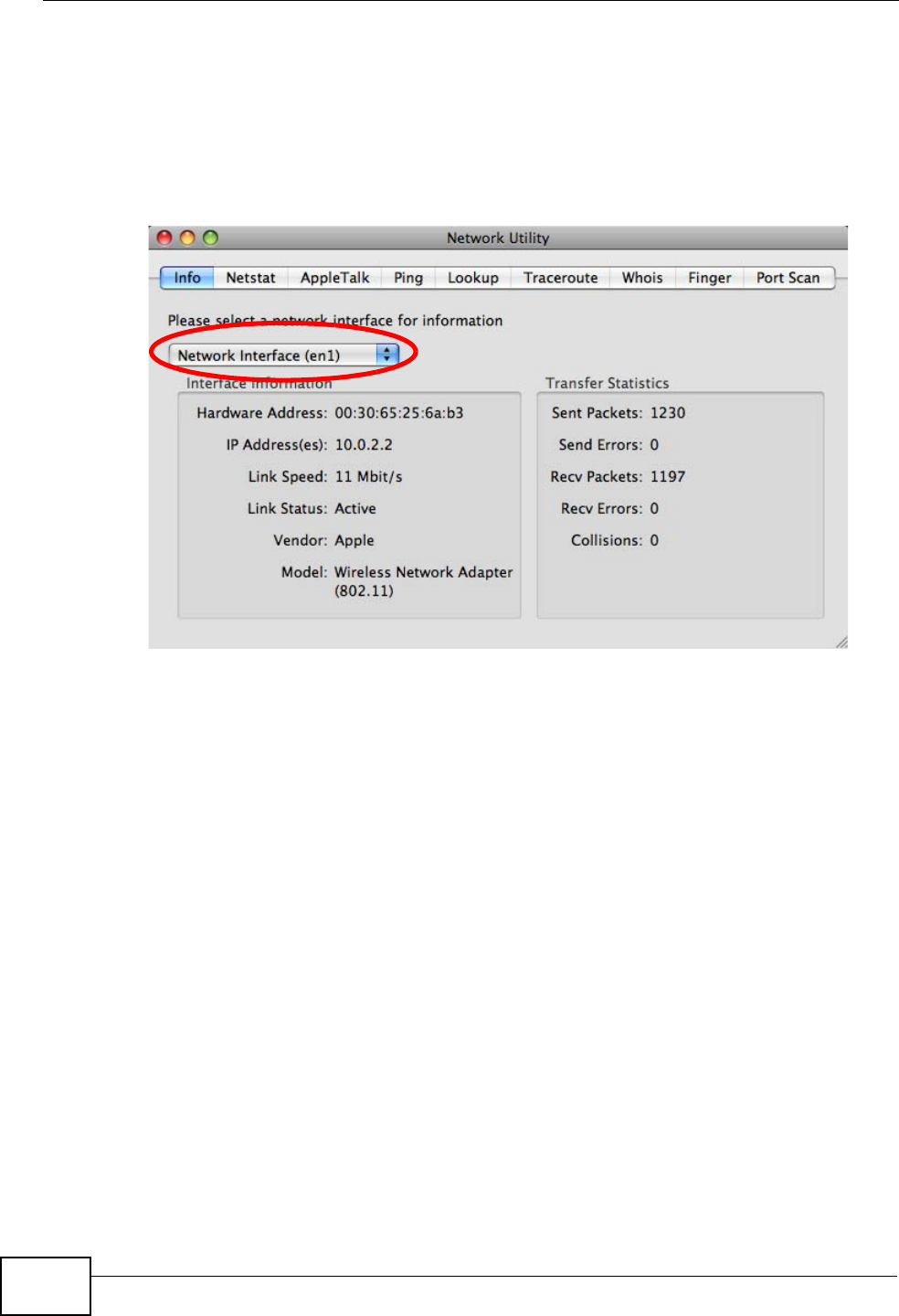
Appendix B Setting Up Your Computer’s IP Address
MAX-207HW2R User’s Guide
202
Verifying Settings
Check your TCP/IP properties by clicking Applications > Utilities > Network
Utilities, and then selecting the appropriate Network interface from the Info
tab.
Figure 96 Mac OS X 10.5: Network Utility
Linux: Ubuntu 8 (GNOME)
This section shows you how to configure your computer’s TCP/IP settings in the
GNU Object Model Environment (GNOME) using the Ubuntu 8 Linux distribution.
The procedure, screens and file locations may vary depending on your specific
distribution, release version, and individual configuration. The following screens
use the default Ubuntu 8 installation.
Note: Make sure you are logged in as the root administrator.
Follow the steps below to configure your computer IP address in GNOME:
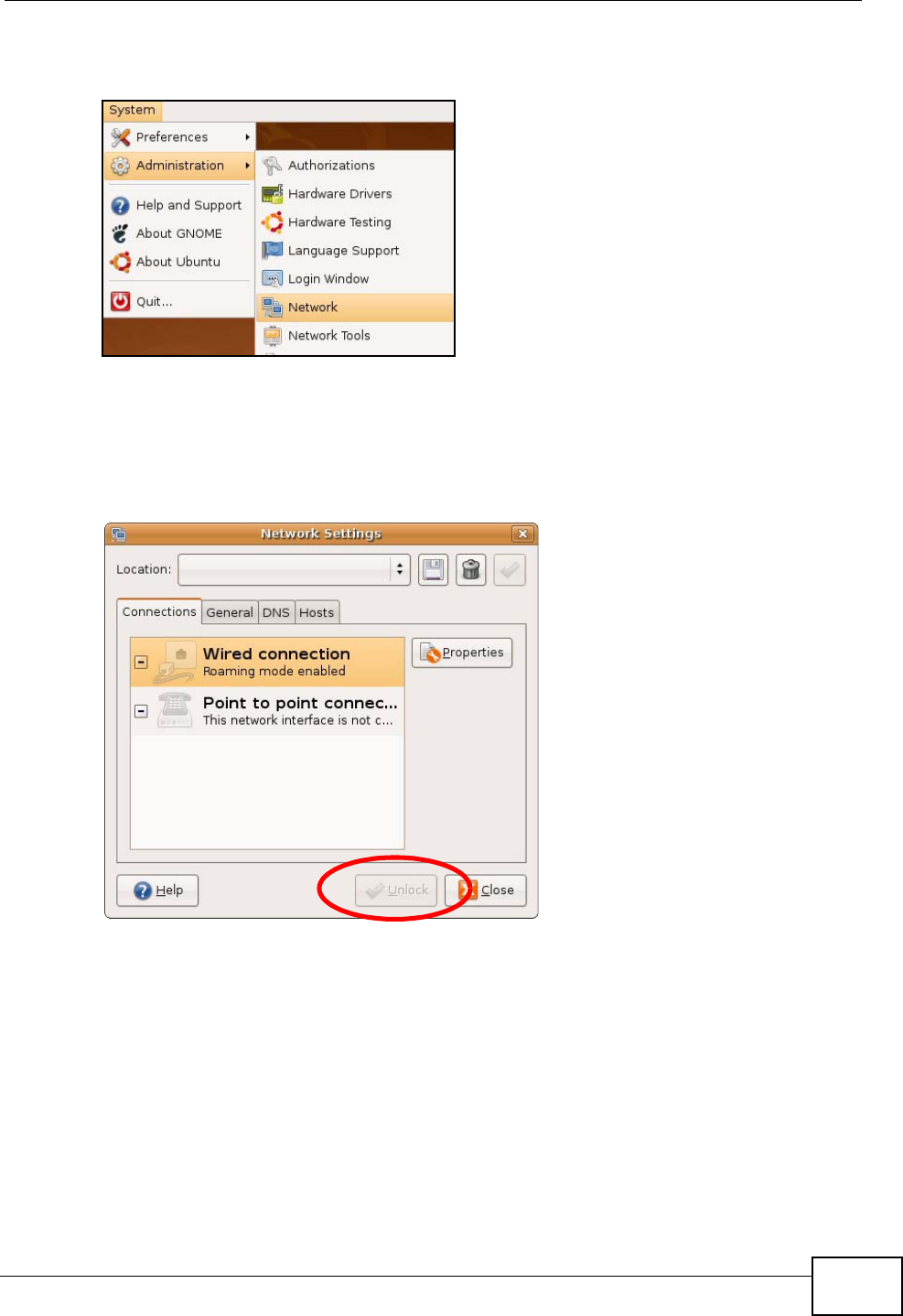
Appendix B Setting Up Your Computer’s IP Address
MAX-207HW2R User’s Guide 203
1Click System > Administration > Network.
Figure 97 Ubuntu 8: System > Administration Menu
2When the Network Settings window opens, click Unlock to open the
Authenticate window. (By default, the Unlock button is greyed out until clicked.)
You cannot make changes to your configuration unless you first enter your admin
password.
Figure 98 Ubuntu 8: Network Settings > Connections
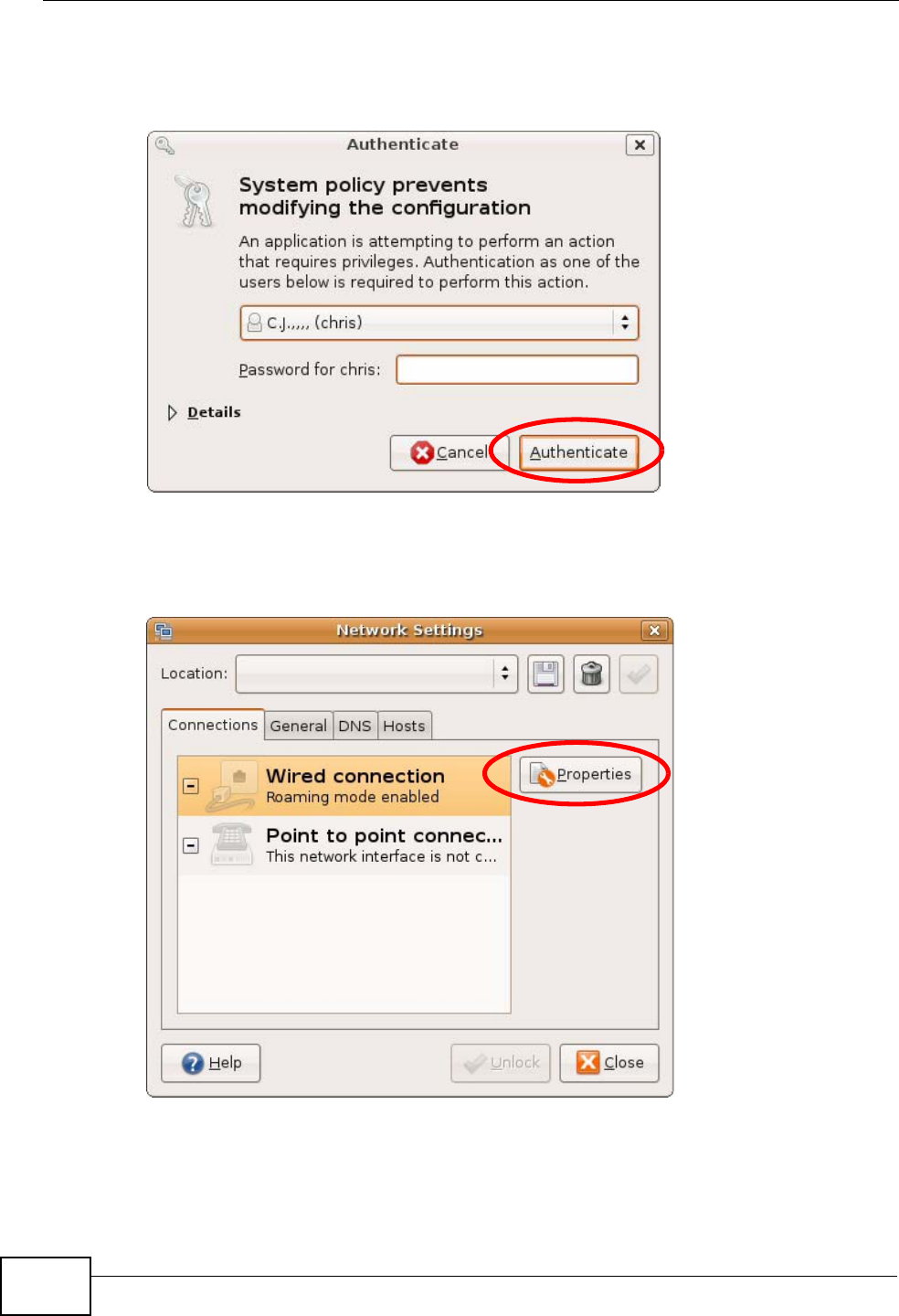
Appendix B Setting Up Your Computer’s IP Address
MAX-207HW2R User’s Guide
204
3In the Authenticate window, enter your admin account name and password then
click the Authenticate button.
Figure 99 Ubuntu 8: Administrator Account Authentication
4In the Network Settings window, select the connection that you want to
configure, then click Properties.
Figure 100 Ubuntu 8: Network Settings > Connections
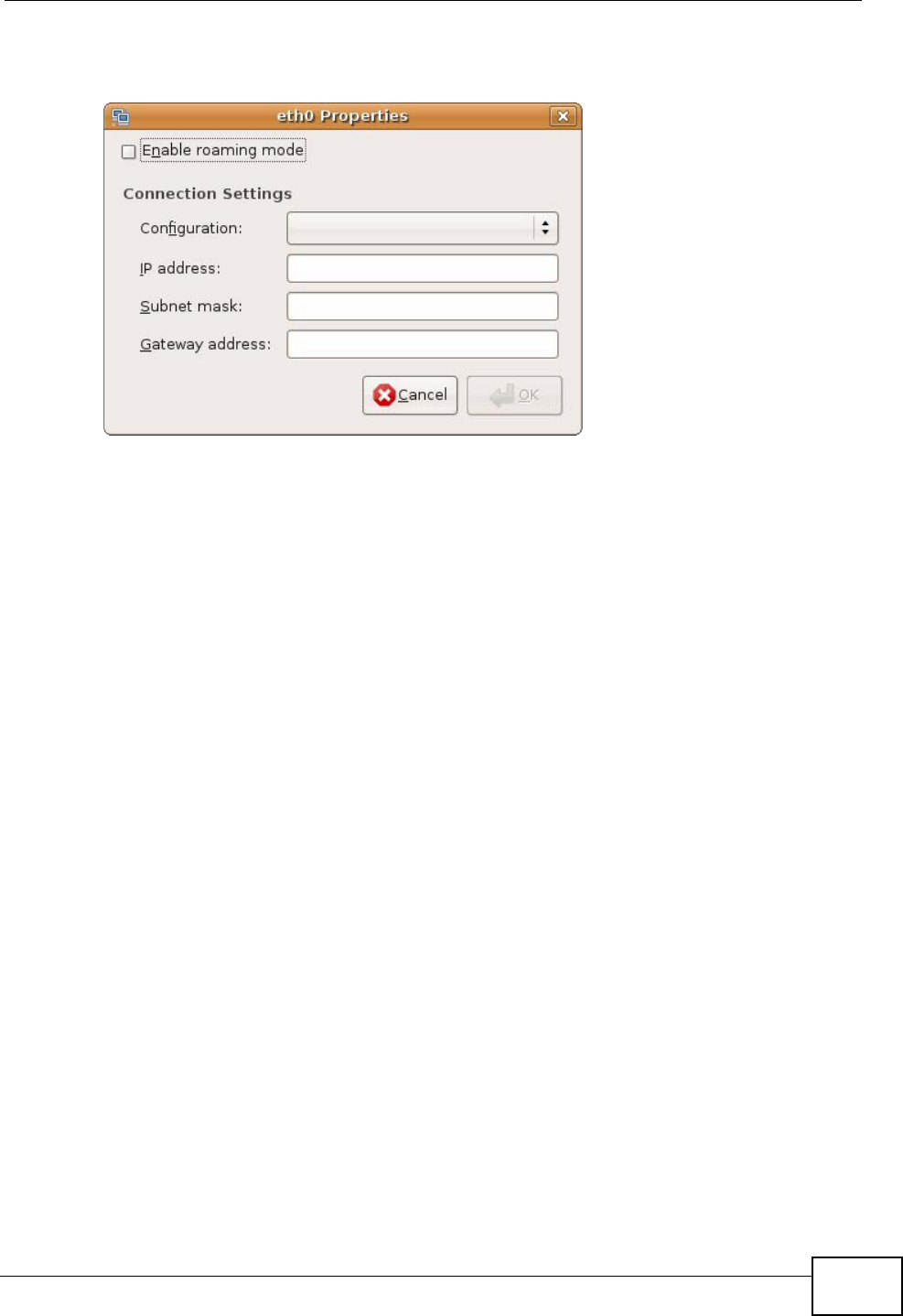
Appendix B Setting Up Your Computer’s IP Address
MAX-207HW2R User’s Guide 205
5The Properties dialog box opens.
Figure 101 Ubuntu 8: Network Settings > Properties
•In the Configuration list, select Automatic Configuration (DHCP) if you
have a dynamic IP address.
•In the Configuration list, select Static IP address if you have a static IP
address. Fill in the IP address, Subnet mask, and Gateway address fields.
6Click OK to save the changes and close the Properties dialog box and return to
the Network Settings screen.
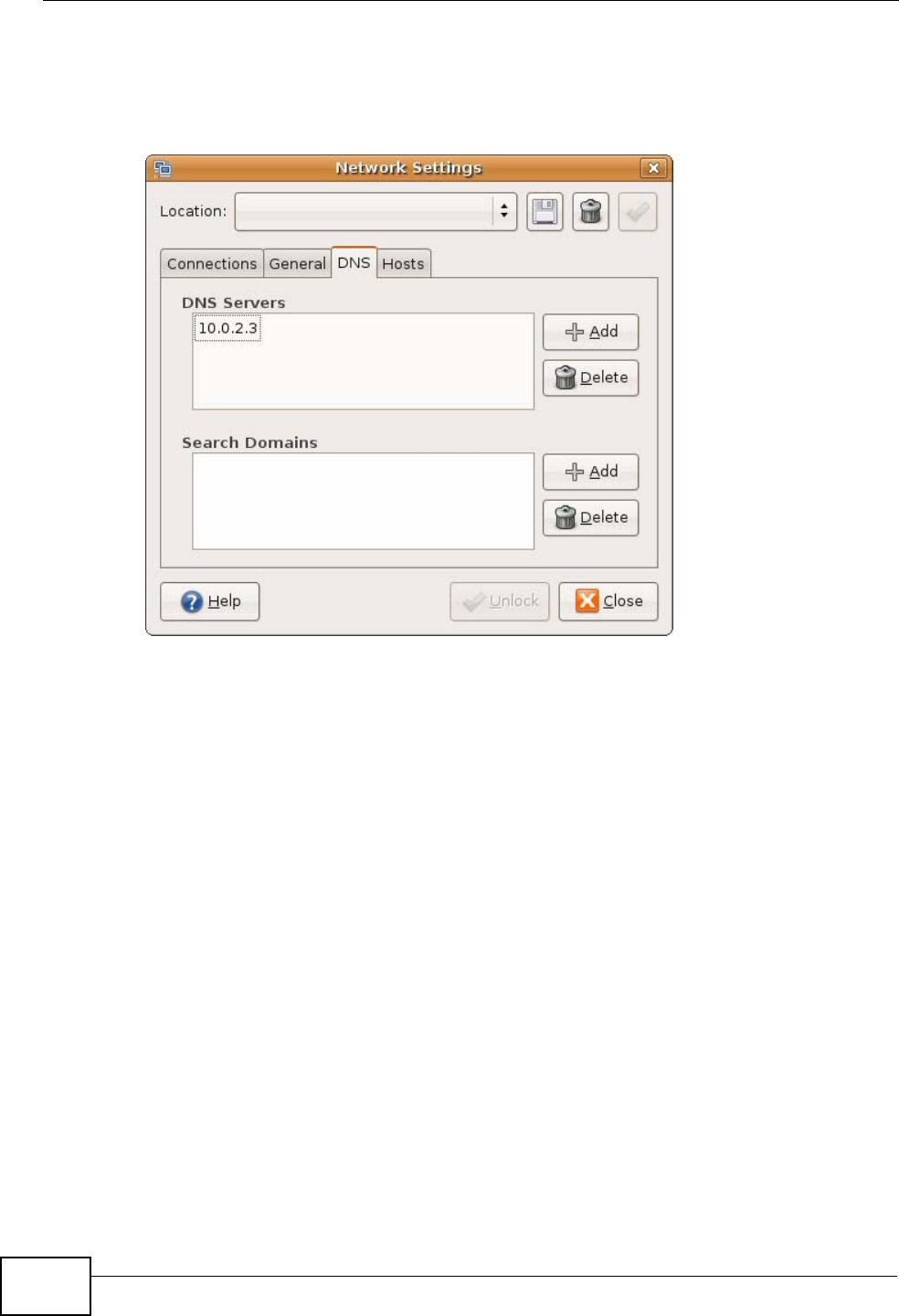
Appendix B Setting Up Your Computer’s IP Address
MAX-207HW2R User’s Guide
206
7If you know your DNS server IP address(es), click the DNS tab in the Network
Settings window and then enter the DNS server information in the fields
provided.
Figure 102 Ubuntu 8: Network Settings > DNS
8Click the Close button to apply the changes.
Verifying Settings
Check your TCP/IP properties by clicking System > Administration > Network
Tools, and then selecting the appropriate Network device from the Devices
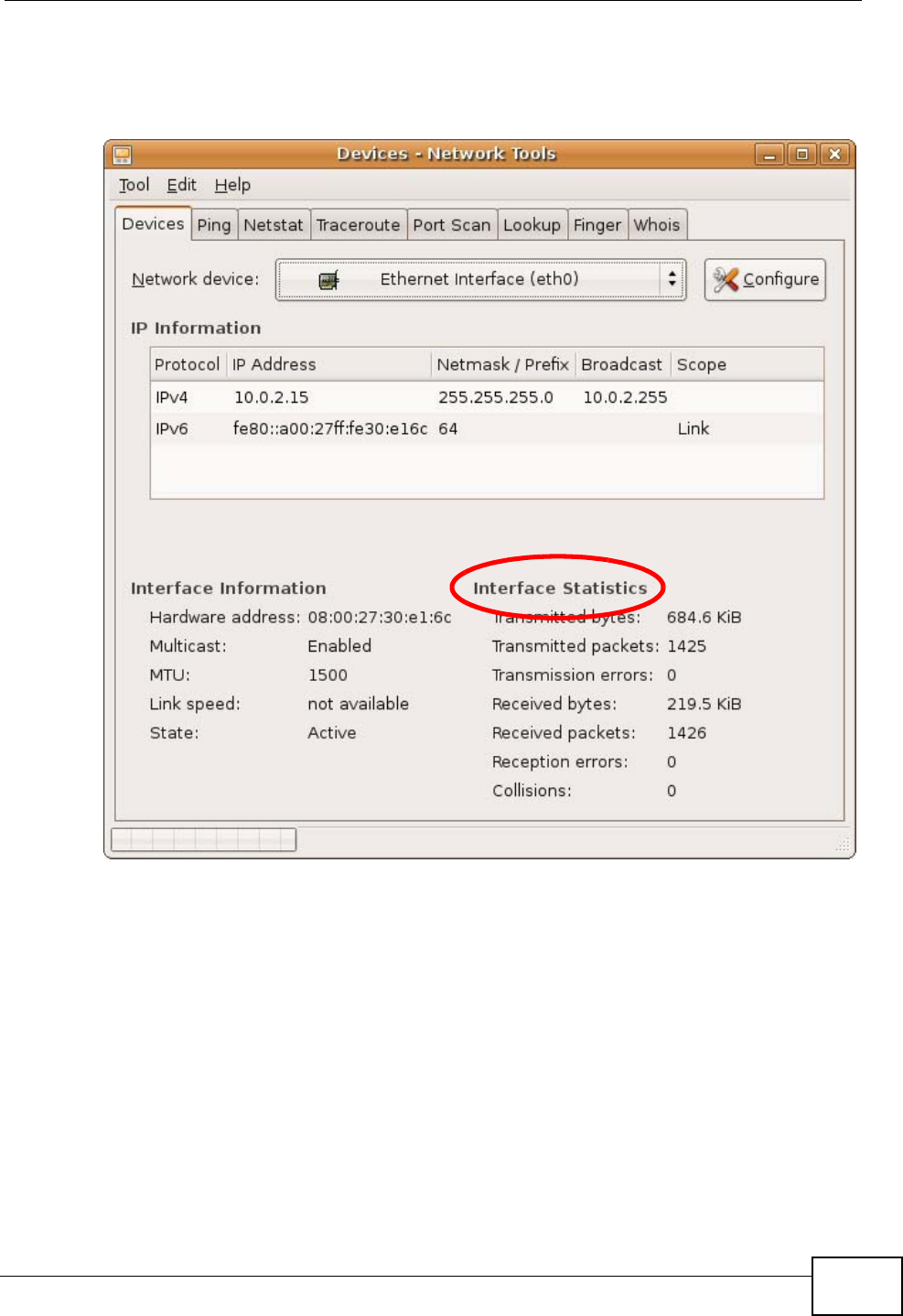
Appendix B Setting Up Your Computer’s IP Address
MAX-207HW2R User’s Guide 207
tab. The Interface Statistics column shows data if your connection is working
properly.
Figure 103 Ubuntu 8: Network Tools
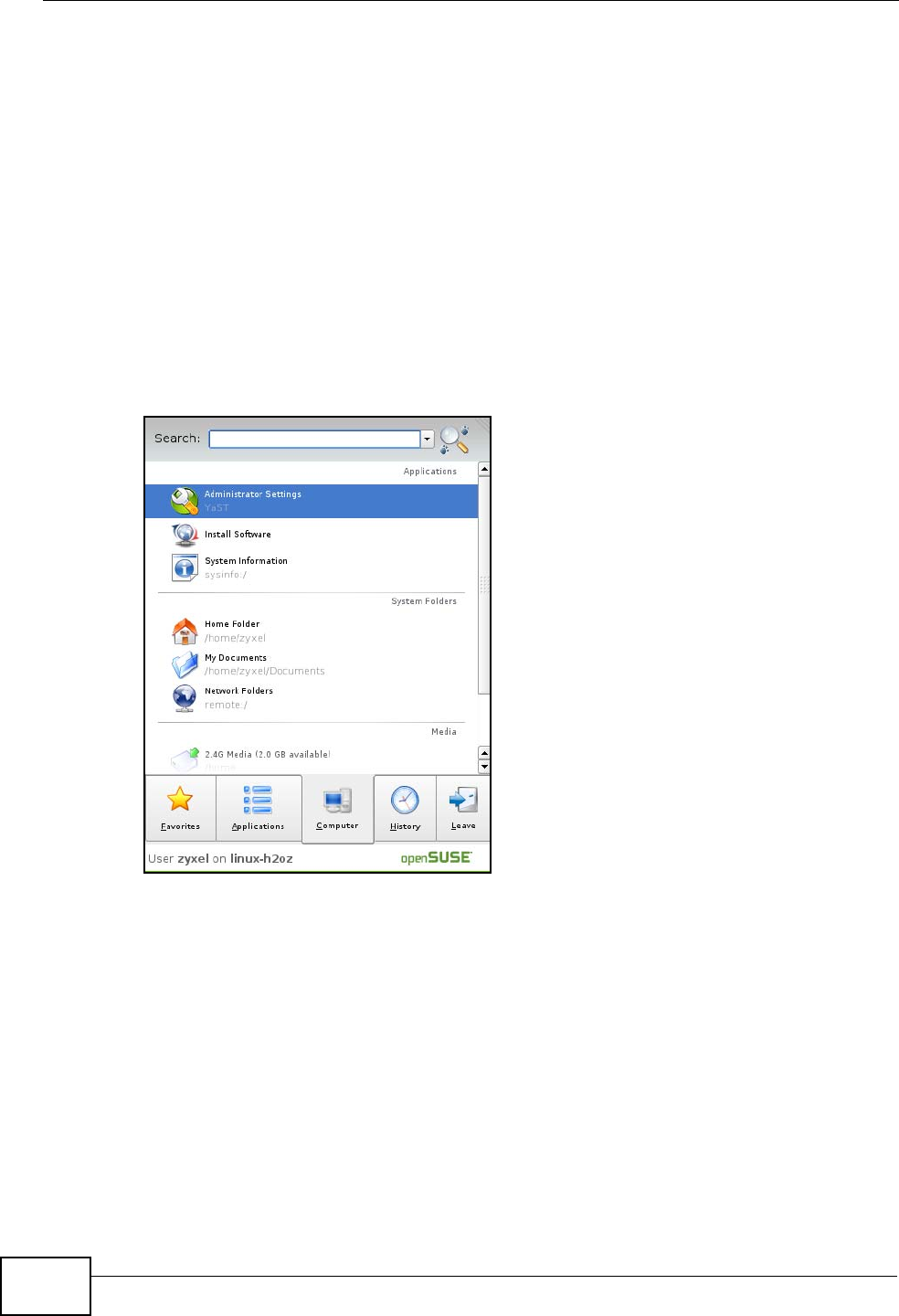
Appendix B Setting Up Your Computer’s IP Address
MAX-207HW2R User’s Guide
208
Linux: openSUSE 10.3 (KDE)
This section shows you how to configure your computer’s TCP/IP settings in the K
Desktop Environment (KDE) using the openSUSE 10.3 Linux distribution. The
procedure, screens and file locations may vary depending on your specific
distribution, release version, and individual configuration. The following screens
use the default openSUSE 10.3 installation.
Note: Make sure you are logged in as the root administrator.
Follow the steps below to configure your computer IP address in the KDE:
1Click K Menu > Computer > Administrator Settings (YaST).
Figure 104 openSUSE 10.3: K Menu > Computer Menu
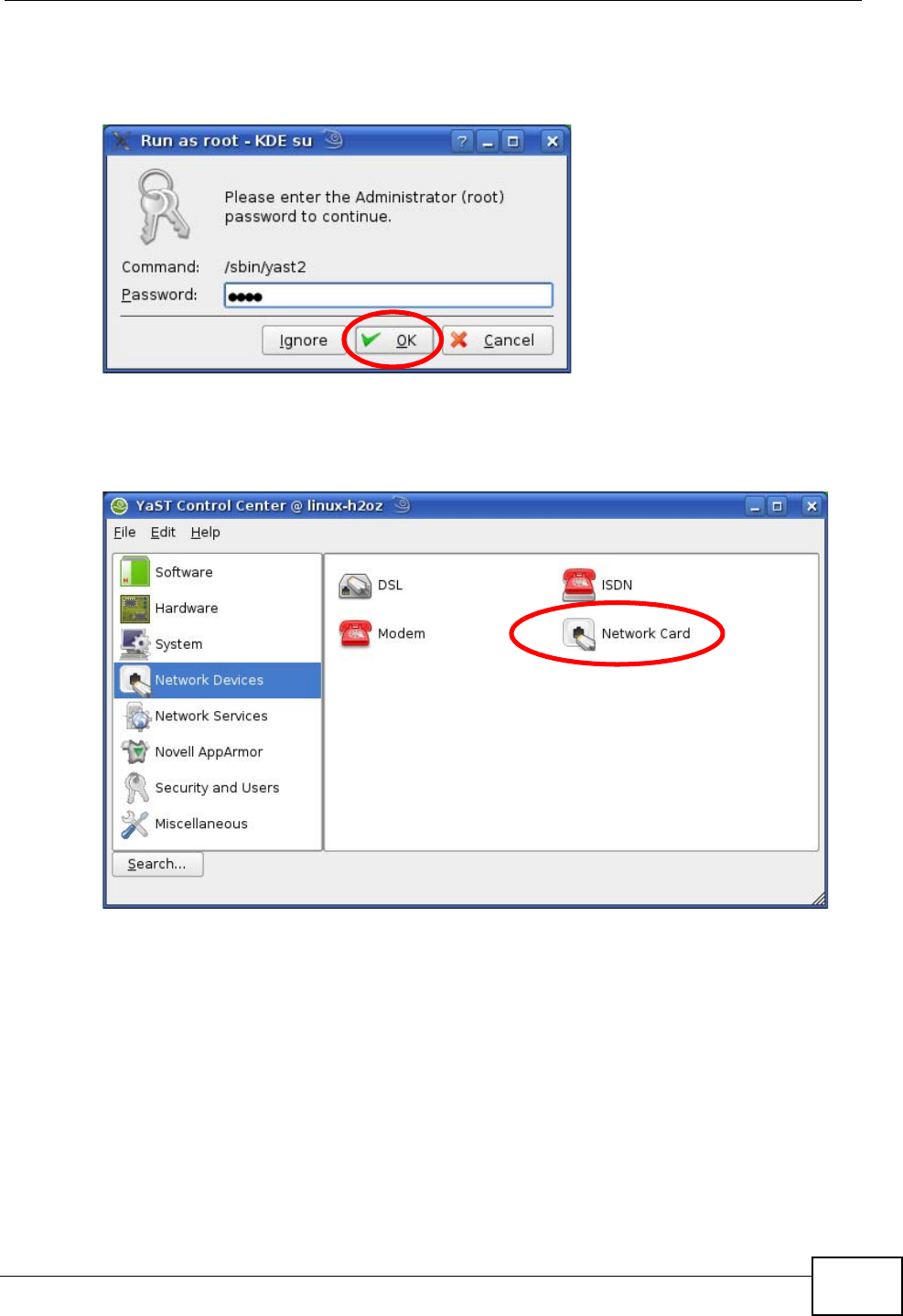
Appendix B Setting Up Your Computer’s IP Address
MAX-207HW2R User’s Guide 209
2When the Run as Root - KDE su dialog opens, enter the admin password and
click OK.
Figure 105 openSUSE 10.3: K Menu > Computer Menu
3When the YaST Control Center window opens, select Network Devices and
then click the Network Card icon.
Figure 106 openSUSE 10.3: YaST Control Center
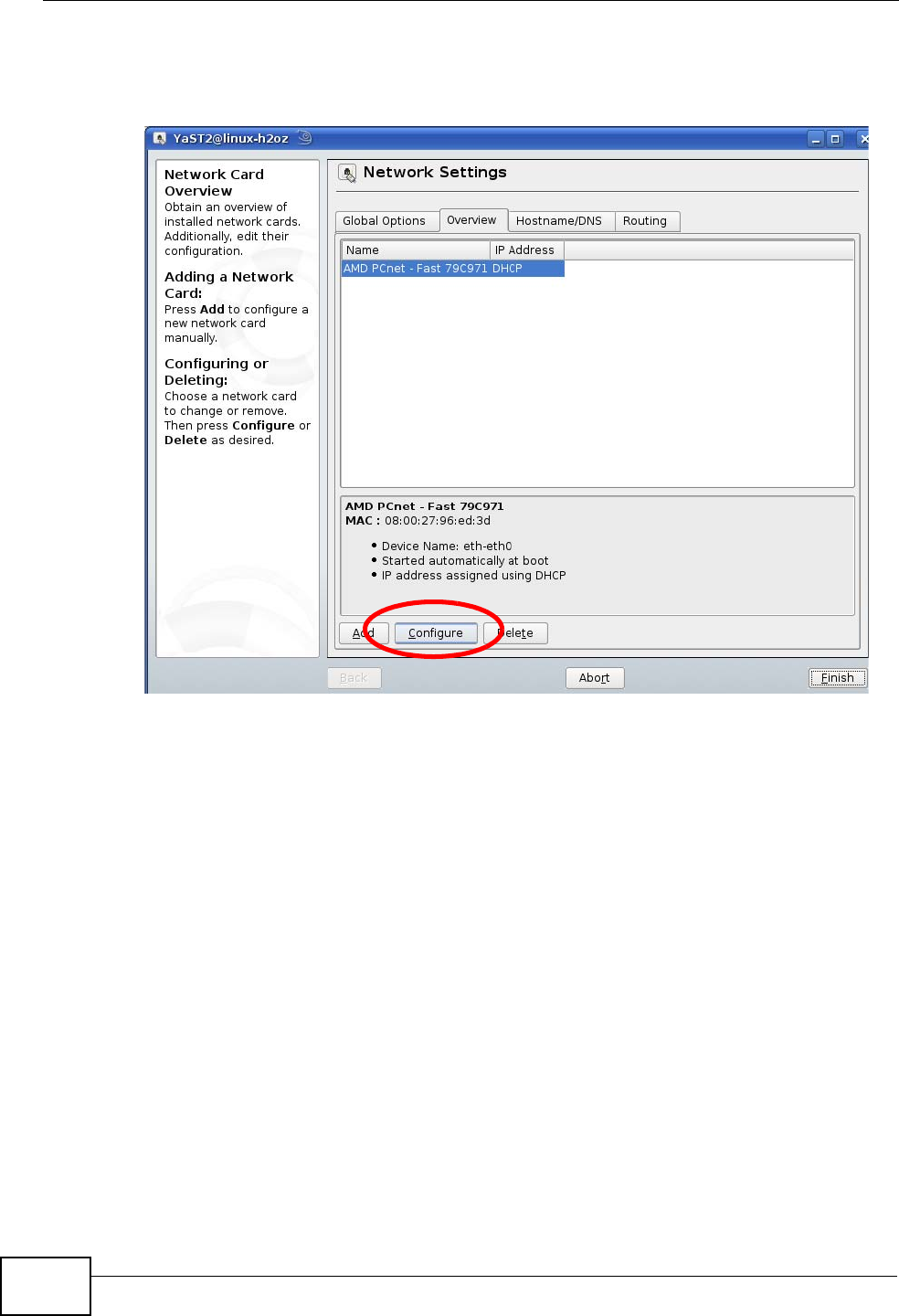
Appendix B Setting Up Your Computer’s IP Address
MAX-207HW2R User’s Guide
210
4When the Network Settings window opens, click the Overview tab, select the
appropriate connection Name from the list, and then click the Configure button.
Figure 107 openSUSE 10.3: Network Settings
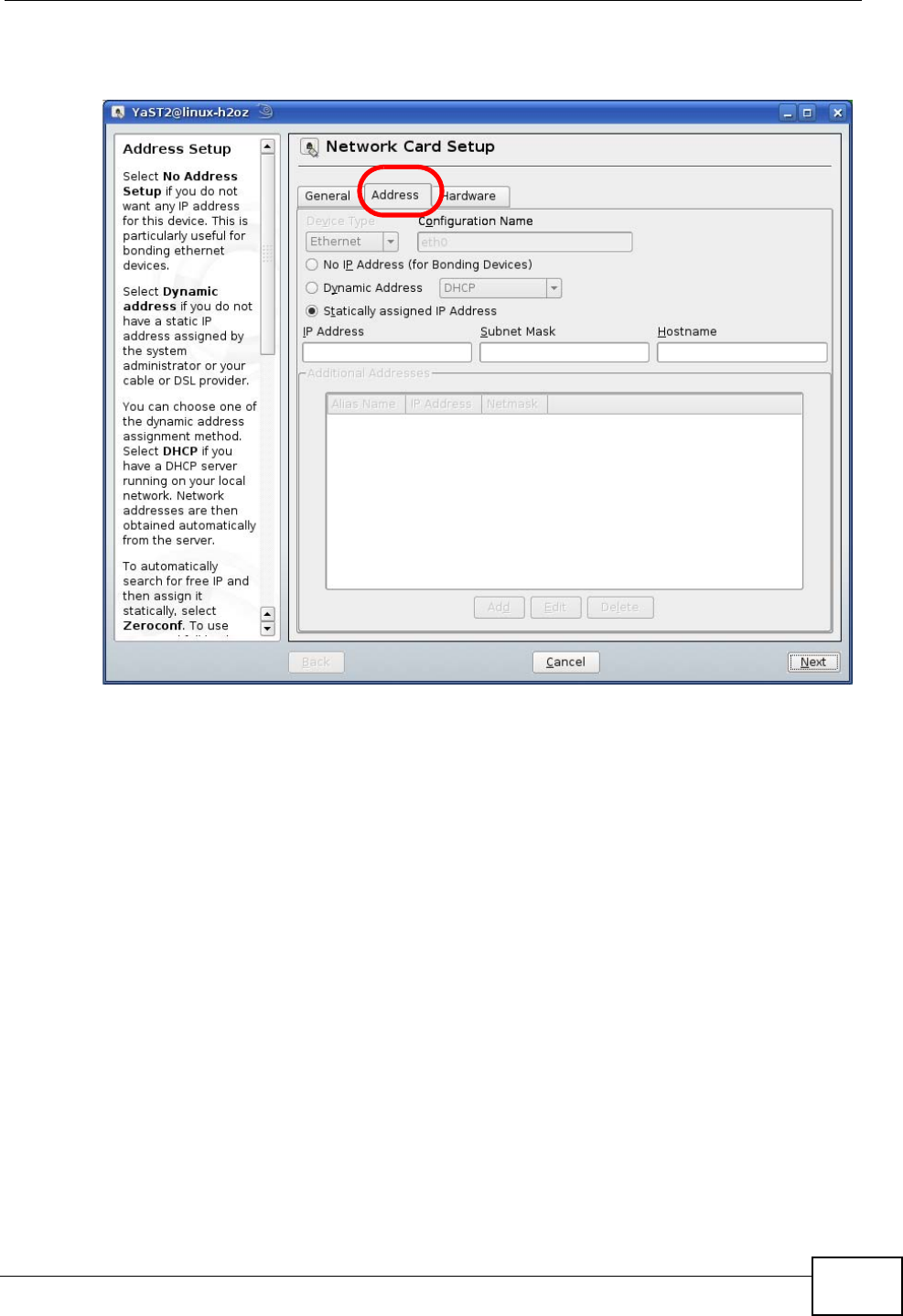
Appendix B Setting Up Your Computer’s IP Address
MAX-207HW2R User’s Guide 211
5When the Network Card Setup window opens, click the Address tab
Figure 108 openSUSE 10.3: Network Card Setup
6Select Dynamic Address (DHCP) if you have a dynamic IP address.
Select Statically assigned IP Address if you have a static IP address. Fill in the
IP address, Subnet mask, and Hostname fields.
7Click Next to save the changes and close the Network Card Setup window.
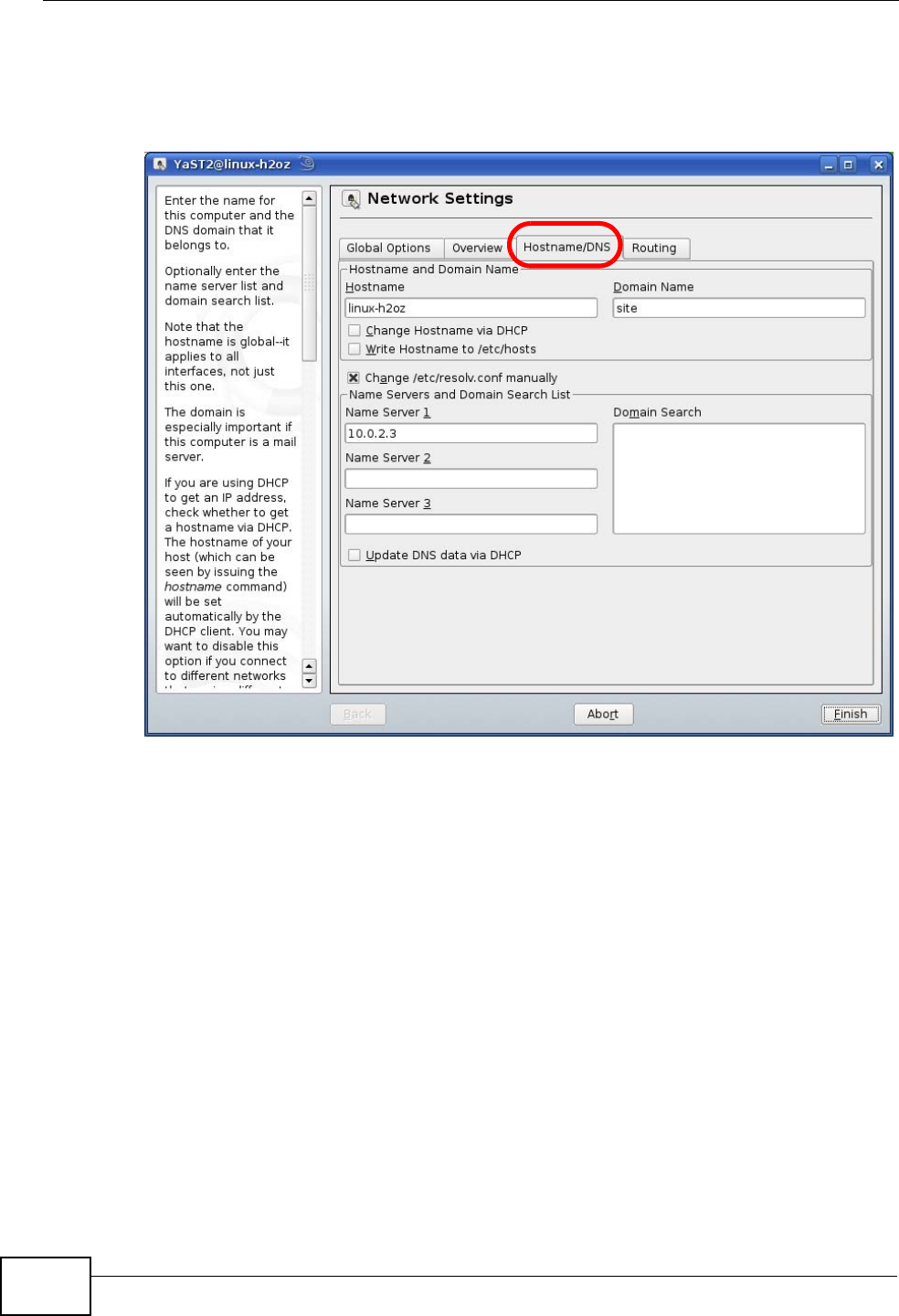
Appendix B Setting Up Your Computer’s IP Address
MAX-207HW2R User’s Guide
212
8If you know your DNS server IP address(es), click the Hostname/DNS tab in
Network Settings and then enter the DNS server information in the fields
provided.
Figure 109 openSUSE 10.3: Network Settings
9Click Finish to save your settings and close the window.
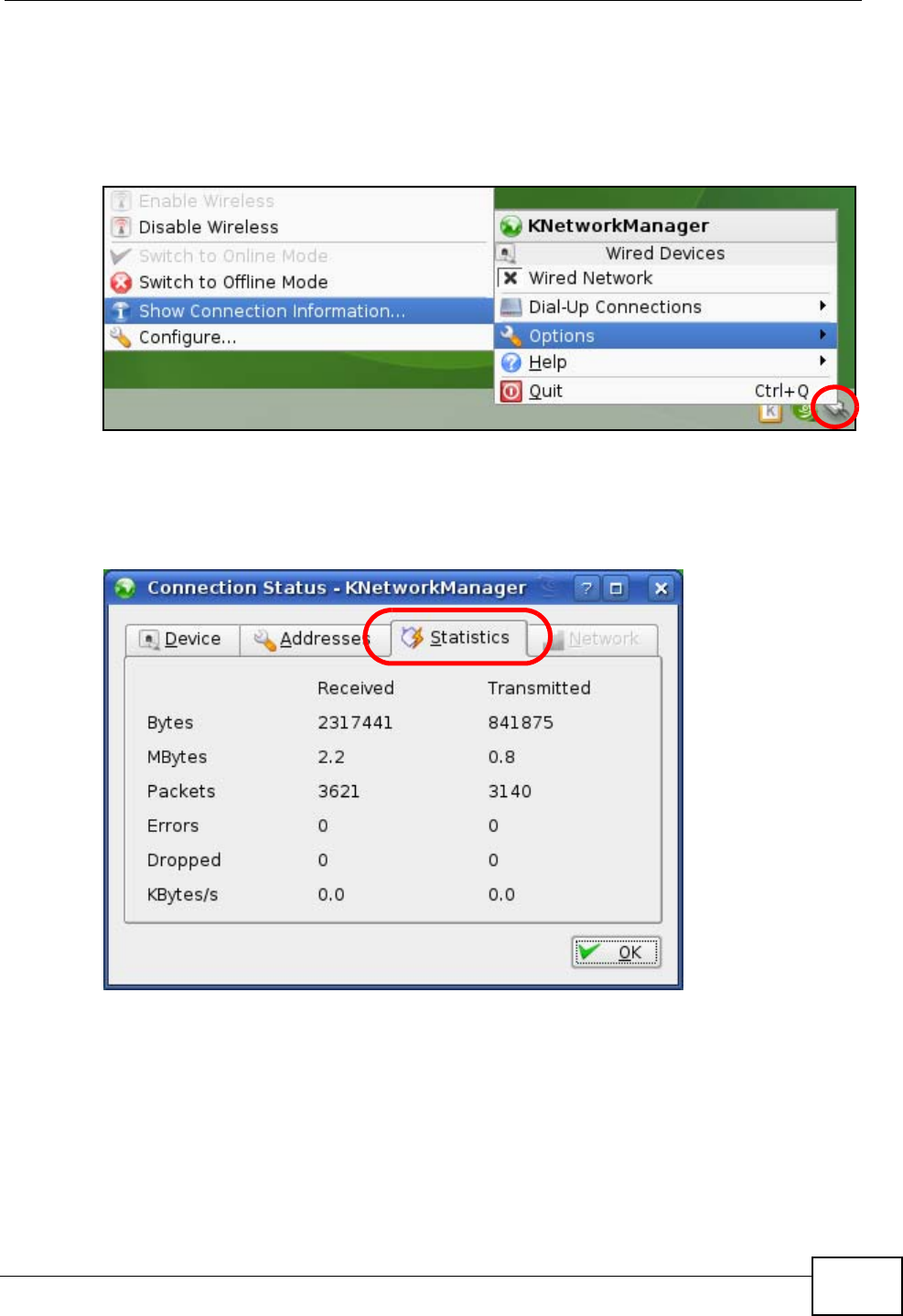
Appendix B Setting Up Your Computer’s IP Address
MAX-207HW2R User’s Guide 213
Verifying Settings
Click the KNetwork Manager icon on the Task bar to check your TCP/IP
properties. From the Options sub-menu, select Show Connection Information.
Figure 110 openSUSE 10.3: KNetwork Manager
When the Connection Status - KNetwork Manager window opens, click the
Statistics tab to see if your connection is working properly.
Figure 111 openSUSE: Connection Status - KNetwork Manager

Appendix B Setting Up Your Computer’s IP Address
MAX-207HW2R User’s Guide
214
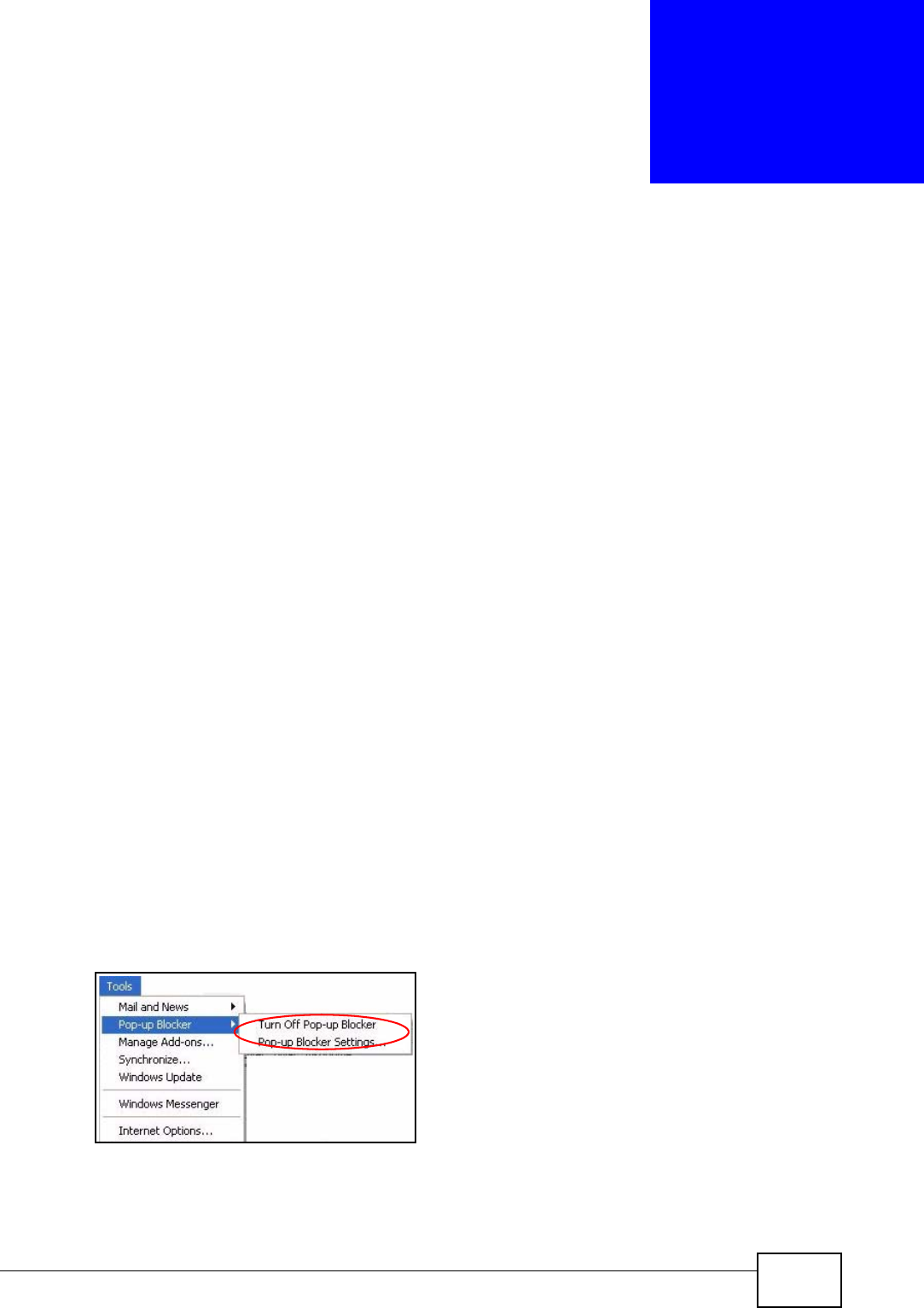
MAX-207HW2R User’s Guide 215
APPENDIX C
Pop-up Windows, JavaScripts
and Java Permissions
In order to use the web configurator you need to allow:
• Web browser pop-up windows from your device.
• JavaScripts (enabled by default).
• Java permissions (enabled by default).
Note: Internet Explorer 6 screens are used here. Screens for other Internet Explorer
versions may vary.
Internet Explorer Pop-up Blockers
You may have to disable pop-up blocking to log into your device.
Either disable pop-up blocking (enabled by default in Windows XP SP (Service
Pack) 2) or allow pop-up blocking and create an exception for your device’s IP
address.
Disable Pop-up Blockers
1In Internet Explorer, select Tools, Pop-up Blocker and then select Turn Off
Pop-up Blocker.
Figure 112 Pop-up Blocker
You can also check if pop-up blocking is disabled in the Pop-up Blocker section in
the Privacy tab.
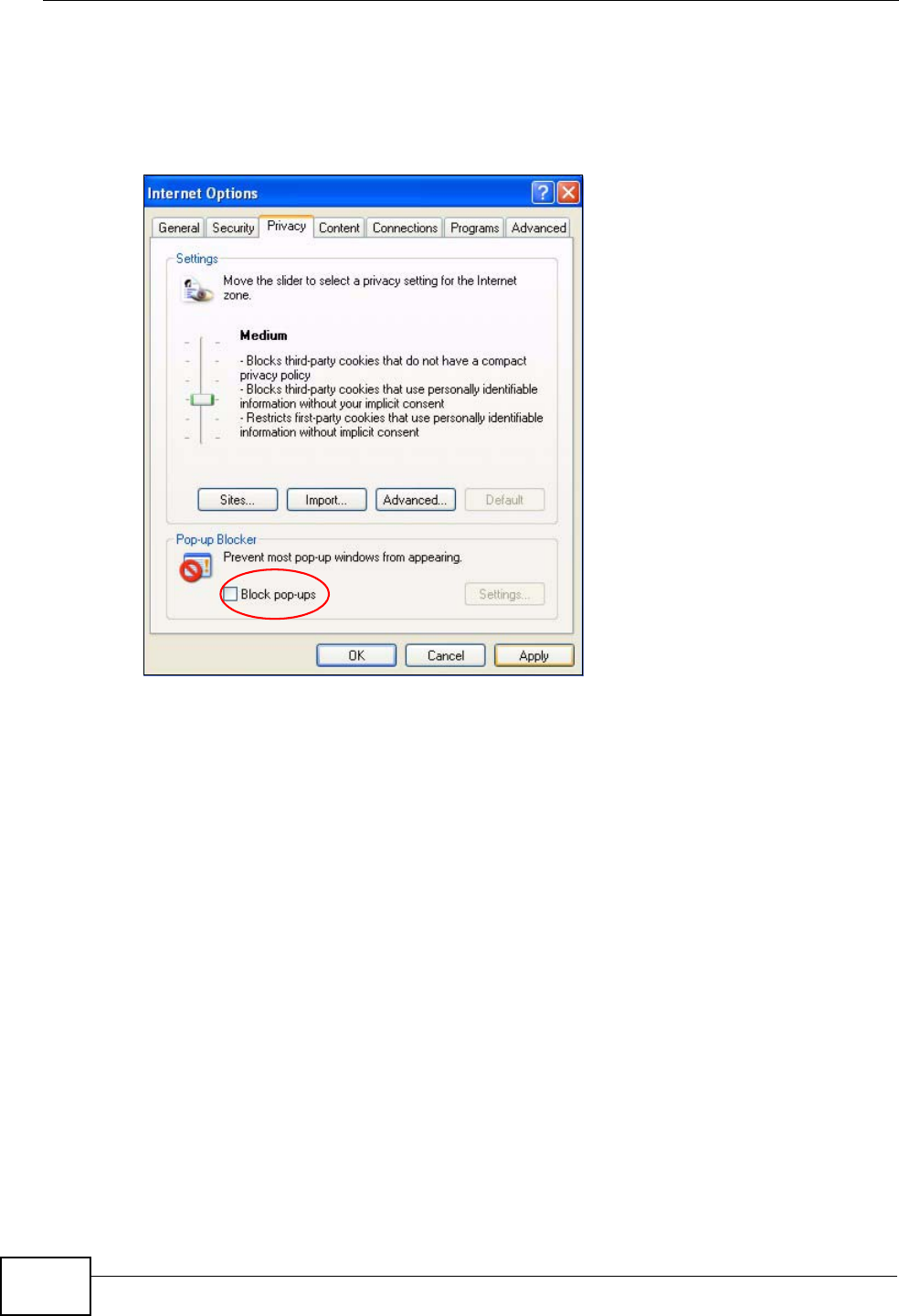
Appendix C Pop-up Windows, JavaScripts and Java Permissions
MAX-207HW2R User’s Guide
216
1In Internet Explorer, select Tools, Internet Options, Privacy.
2Clear the Block pop-ups check box in the Pop-up Blocker section of the screen.
This disables any web pop-up blockers you may have enabled.
Figure 113 Internet Options: Privacy
3Click Apply to save this setting.
Enable Pop-up Blockers with Exceptions
Alternatively, if you only want to allow pop-up windows from your device, see the
following steps.
1In Internet Explorer, select Tools, Internet Options and then the Privacy tab.
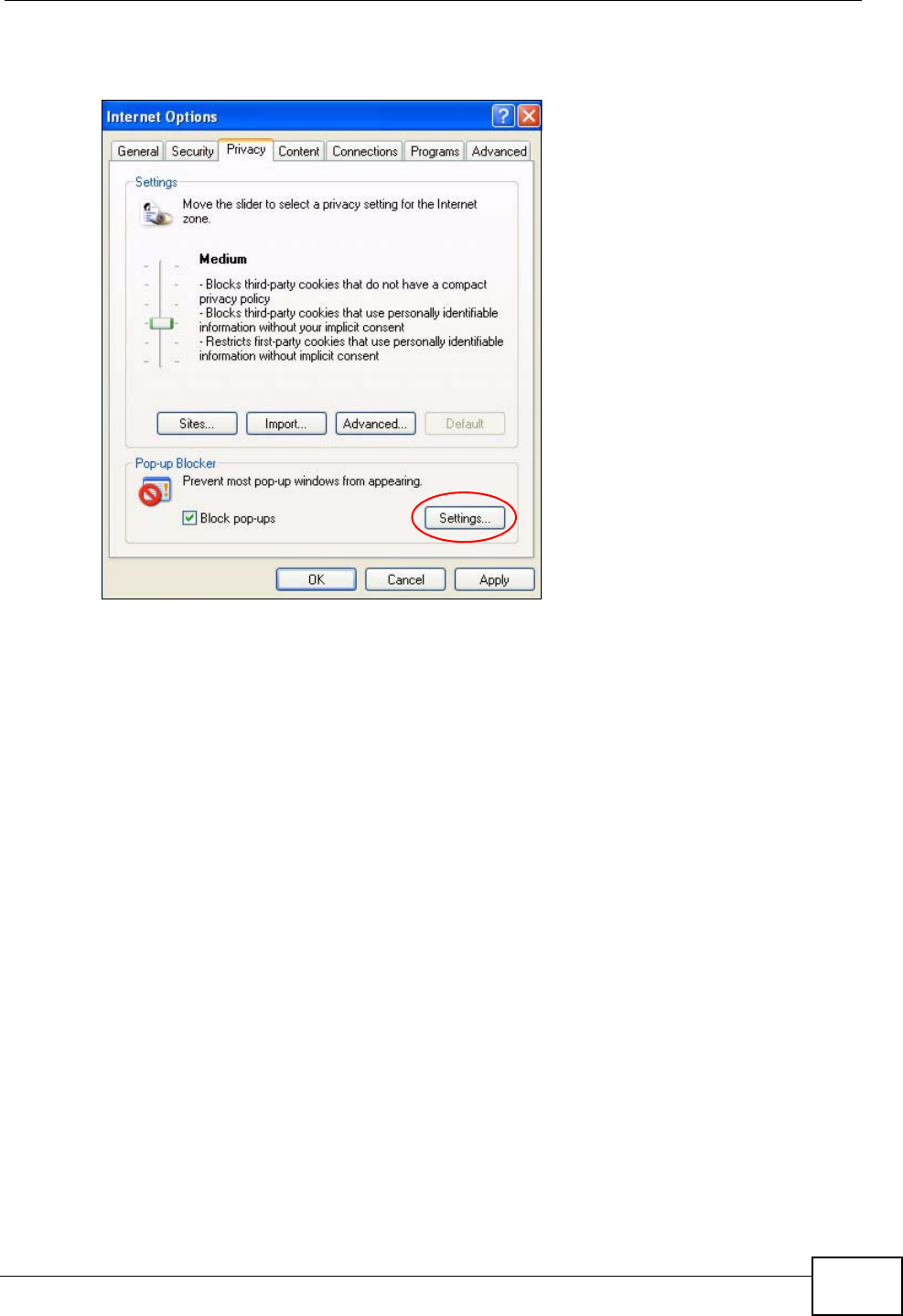
Appendix C Pop-up Windows, JavaScripts and Java Permissions
MAX-207HW2R User’s Guide 217
2Select Settings…to open the Pop-up Blocker Settings screen.
Figure 114 Internet Options: Privacy
3Type the IP address of your device (the web page that you do not want to have
blocked) with the prefix “http://”. For example, http://192.168.167.1.
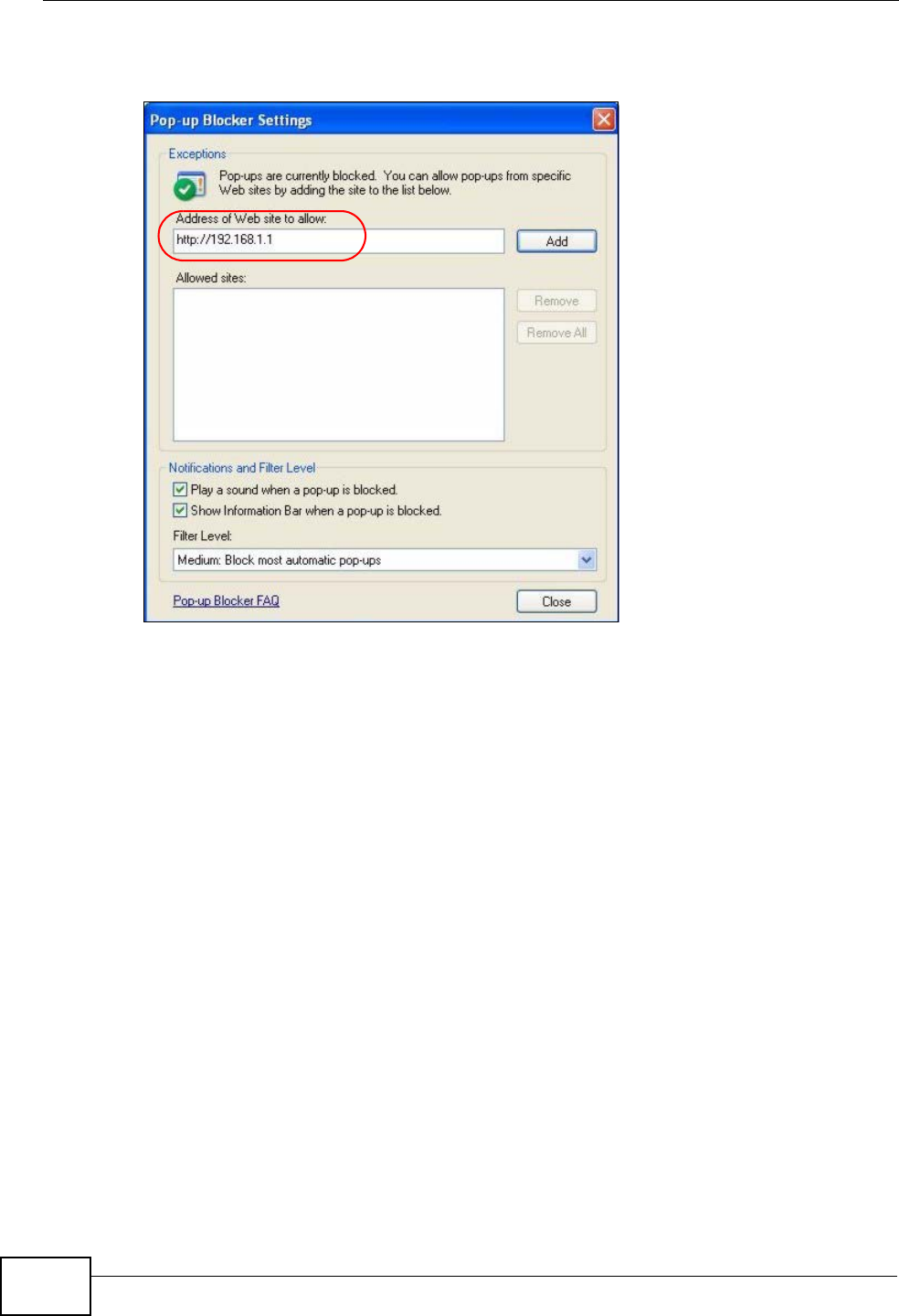
Appendix C Pop-up Windows, JavaScripts and Java Permissions
MAX-207HW2R User’s Guide
218
4Click Add to move the IP address to the list of Allowed sites.
Figure 115 Pop-up Blocker Settings
5Click Close to return to the Privacy screen.
6Click Apply to save this setting.
JavaScripts
If pages of the web configurator do not display properly in Internet Explorer, check
that JavaScripts are allowed.
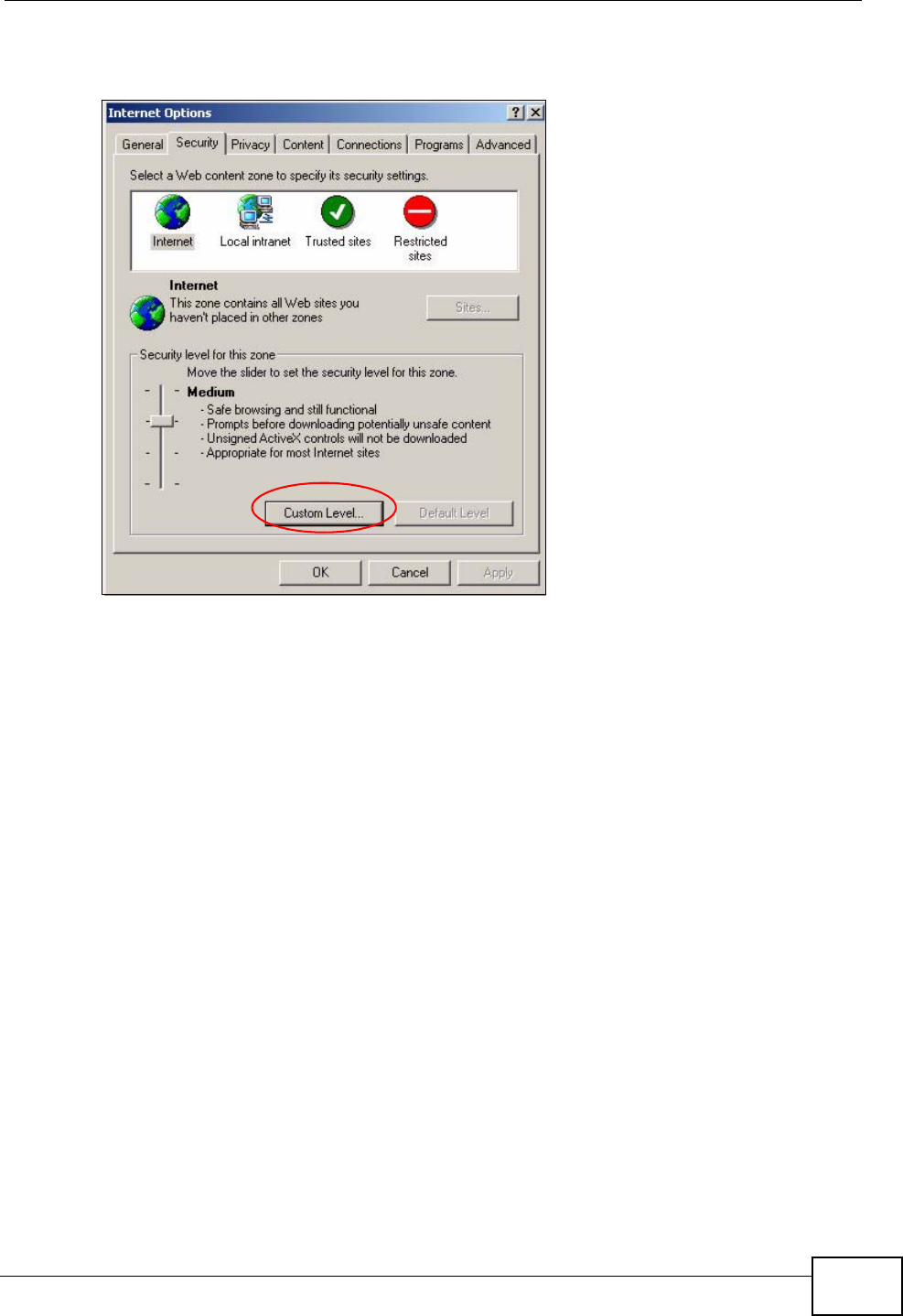
Appendix C Pop-up Windows, JavaScripts and Java Permissions
MAX-207HW2R User’s Guide 219
1In Internet Explorer, click Tools, Internet Options and then the Security tab.
Figure 116 Internet Options: Security
2Click the Custom Level... button.
3Scroll down to Scripting.
4Under Active scripting make sure that Enable is selected (the default).
5Under Scripting of Java applets make sure that Enable is selected (the
default).
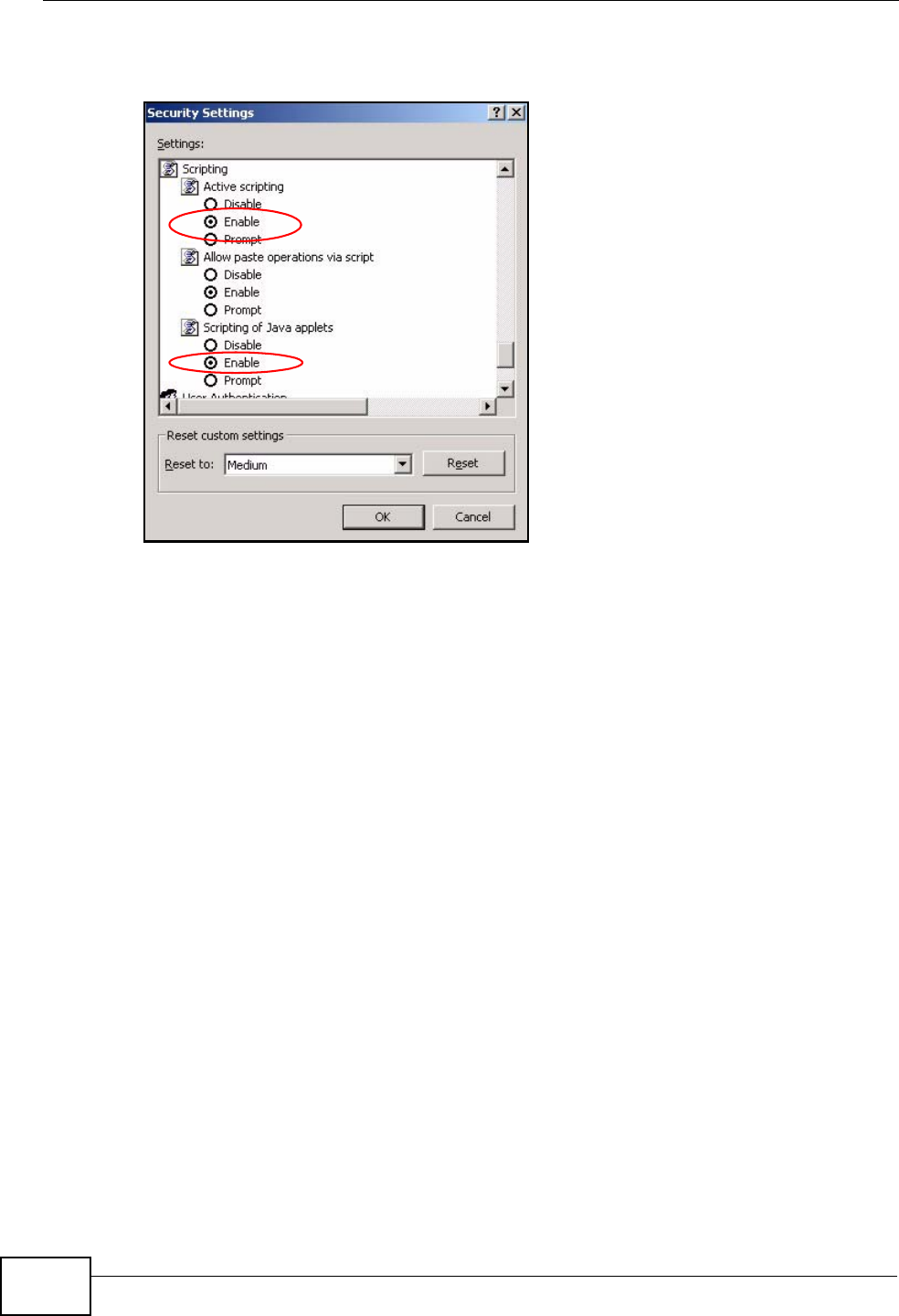
Appendix C Pop-up Windows, JavaScripts and Java Permissions
MAX-207HW2R User’s Guide
220
6Click OK to close the window.
Figure 117 Security Settings - Java Scripting
Java Permissions
1From Internet Explorer, click Tools, Internet Options and then the Security
tab.
2Click the Custom Level... button.
3Scroll down to Microsoft VM.
4Under Java permissions make sure that a safety level is selected.
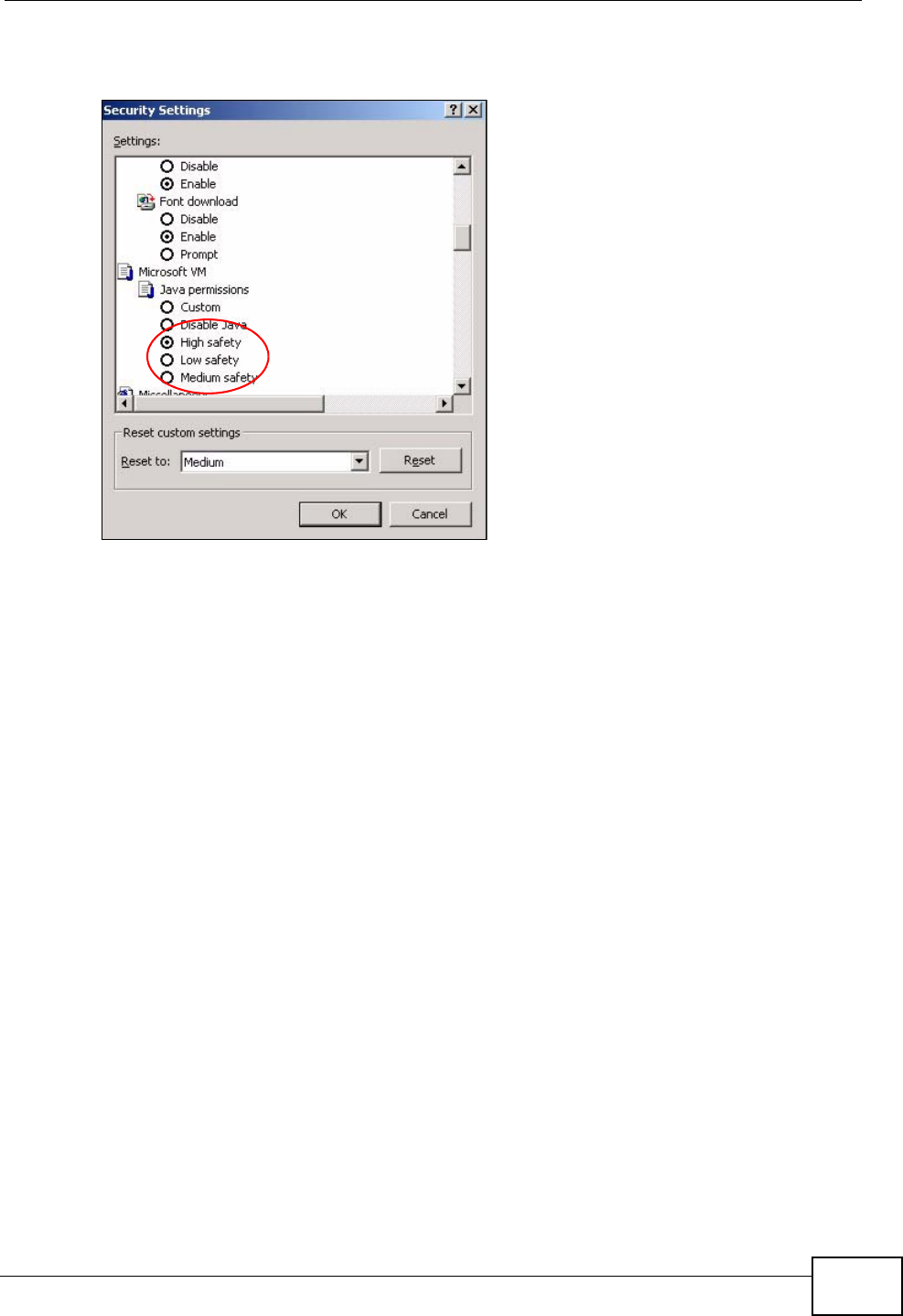
Appendix C Pop-up Windows, JavaScripts and Java Permissions
MAX-207HW2R User’s Guide 221
5Click OK to close the window.
Figure 118 Security Settings - Java
JAVA (Sun)
1From Internet Explorer, click Tools, Internet Options and then the Advanced
tab.
2Make sure that Use Java 2 for <applet> under Java (Sun) is selected.
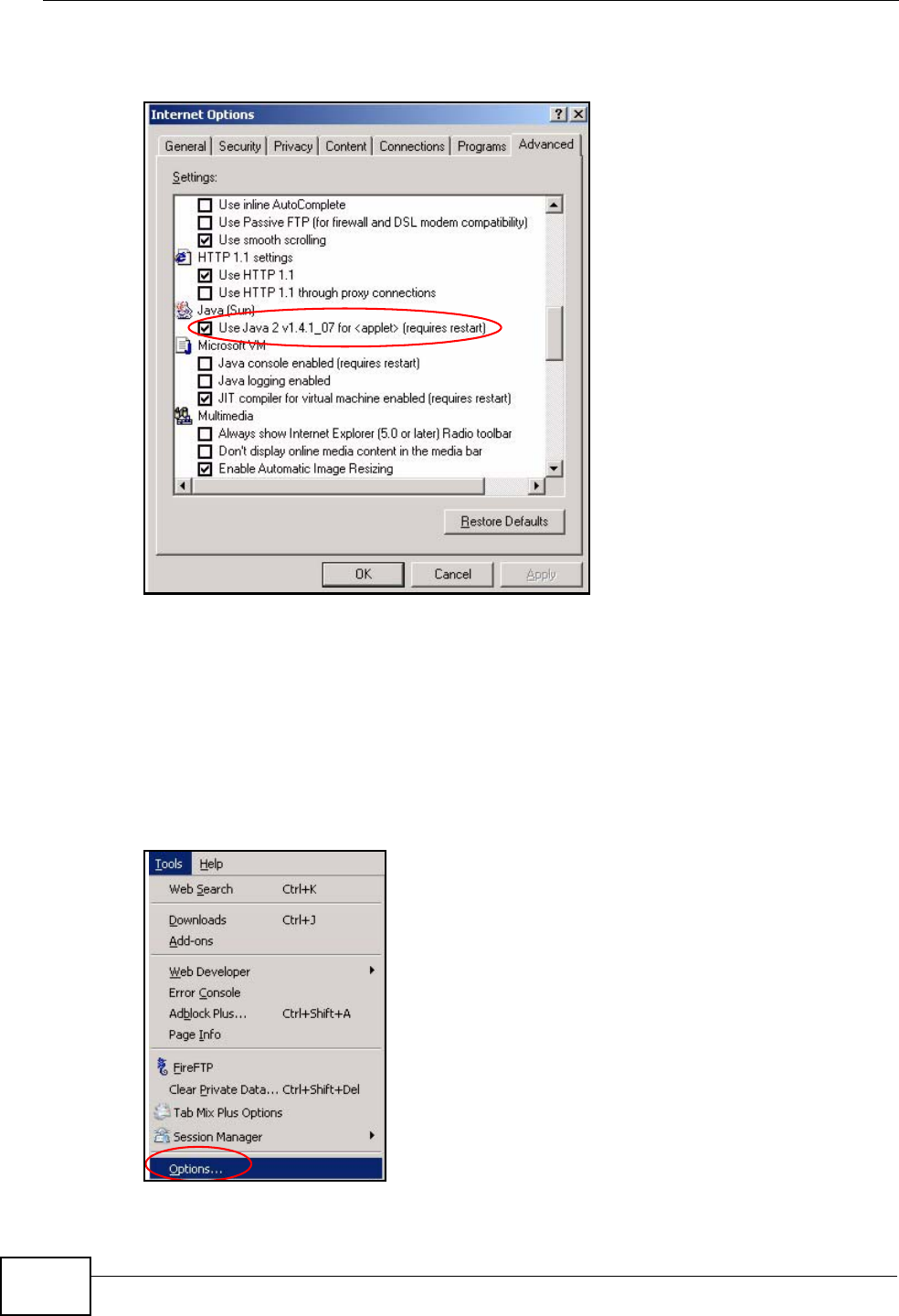
Appendix C Pop-up Windows, JavaScripts and Java Permissions
MAX-207HW2R User’s Guide
222
3Click OK to close the window.
Figure 119 Java (Sun)
Mozilla Firefox
Mozilla Firefox 2.0 screens are used here. Screens for other versions may vary.
You can enable Java, Javascripts and pop-ups in one screen. Click Tools, then
click Options in the screen that appears.
Figure 120 Mozilla Firefox: TOOLS > Options
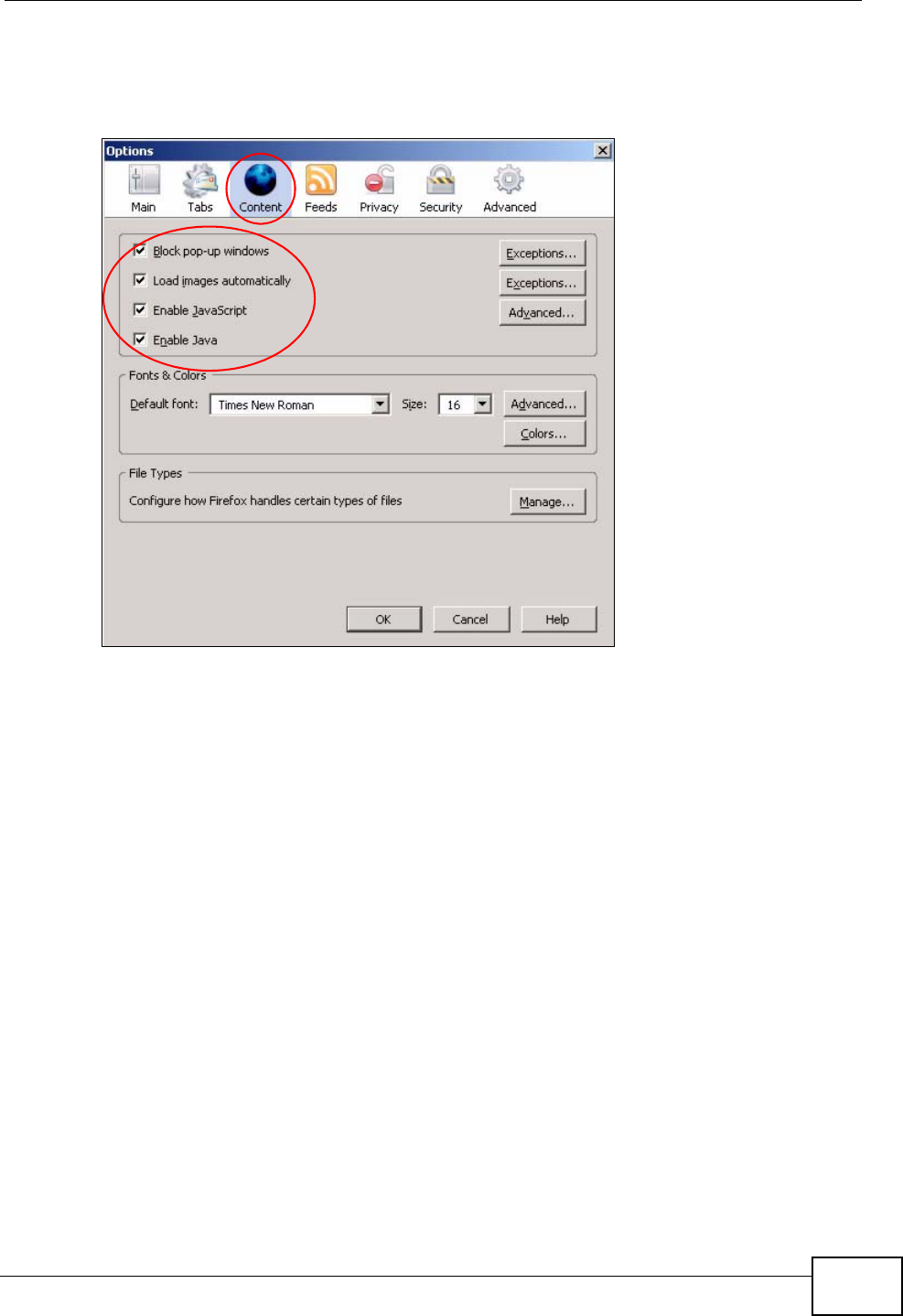
Appendix C Pop-up Windows, JavaScripts and Java Permissions
MAX-207HW2R User’s Guide 223
Click Content.to show the screen below. Select the check boxes as shown in the
following screen.
Figure 121 Mozilla Firefox Content Security

Appendix C Pop-up Windows, JavaScripts and Java Permissions
MAX-207HW2R User’s Guide
224

MAX-207HW2R User’s Guide 225
APPENDIX D
IP Addresses and Subnetting
This appendix introduces IP addresses and subnet masks.
IP addresses identify individual devices on a network. Every networking device
(including computers, servers, routers, printers, etc.) needs an IP address to
communicate across the network. These networking devices are also known as
hosts.
Subnet masks determine the maximum number of possible hosts on a network.
You can also use subnet masks to divide one network into multiple sub-networks.
Introduction to IP Addresses
One part of the IP address is the network number, and the other part is the host
ID. In the same way that houses on a street share a common street name, the
hosts on a network share a common network number. Similarly, as each house
has its own house number, each host on the network has its own unique
identifying number - the host ID. Routers use the network number to send packets
to the correct network, while the host ID determines to which host on the network
the packets are delivered.
Structure
An IP address is made up of four parts, written in dotted decimal notation (for
example, 192.168.100.1). Each of these four parts is known as an octet. An octet
is an eight-digit binary number (for example 11000000, which is 192 in decimal
notation).
Therefore, each octet has a possible range of 00000000 to 11111111 in binary, or
0 to 255 in decimal.
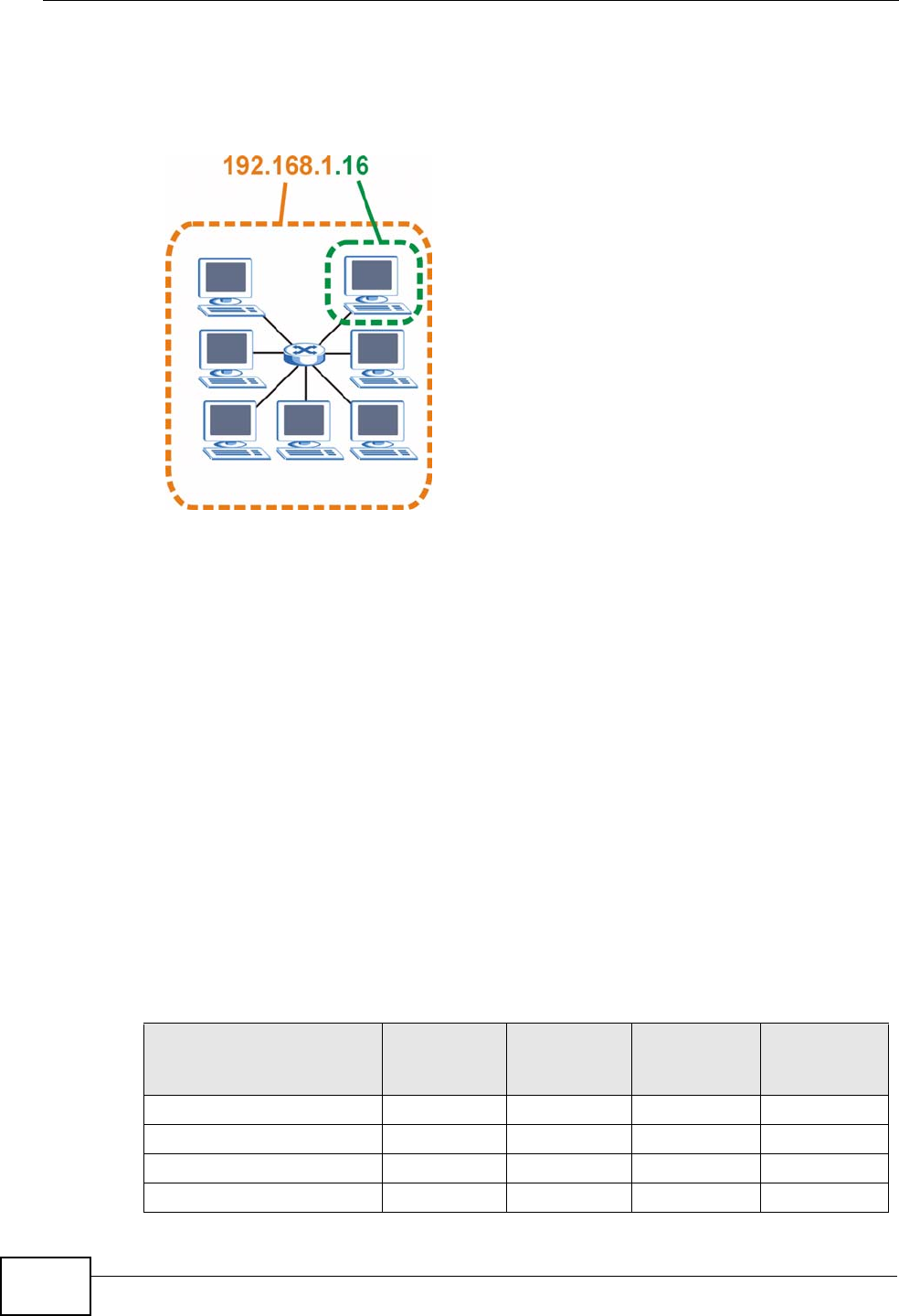
Appendix D IP Addresses and Subnetting
MAX-207HW2R User’s Guide
226
The following figure shows an example IP address in which the first three octets
(192.168.1) are the network number, and the fourth octet (16) is the host ID.
Figure 122 Network Number and Host ID
How much of the IP address is the network number and how much is the host ID
varies according to the subnet mask.
Subnet Masks
A subnet mask is used to determine which bits are part of the network number,
and which bits are part of the host ID (using a logical AND operation). The term
“subnet” is short for “sub-network”.
A subnet mask has 32 bits. If a bit in the subnet mask is a “1” then the
corresponding bit in the IP address is part of the network number. If a bit in the
subnet mask is “0” then the corresponding bit in the IP address is part of the host
ID.
The following example shows a subnet mask identifying the network number (in
bold text) and host ID of an IP address (192.168.1.2 in decimal).
Table 72 IP Address Network Number and Host ID Example
1ST OCTET:
(192)
2ND OCTET:
(168)
3RD OCTET:
(1)
4TH OCTET
(2)
IP Address (Binary) 11000000 10101000 00000001 00000010
Subnet Mask (Binary) 11111111 11111111 11111111 00000000
Network Number 11000000 10101000 00000001
Host ID 00000010
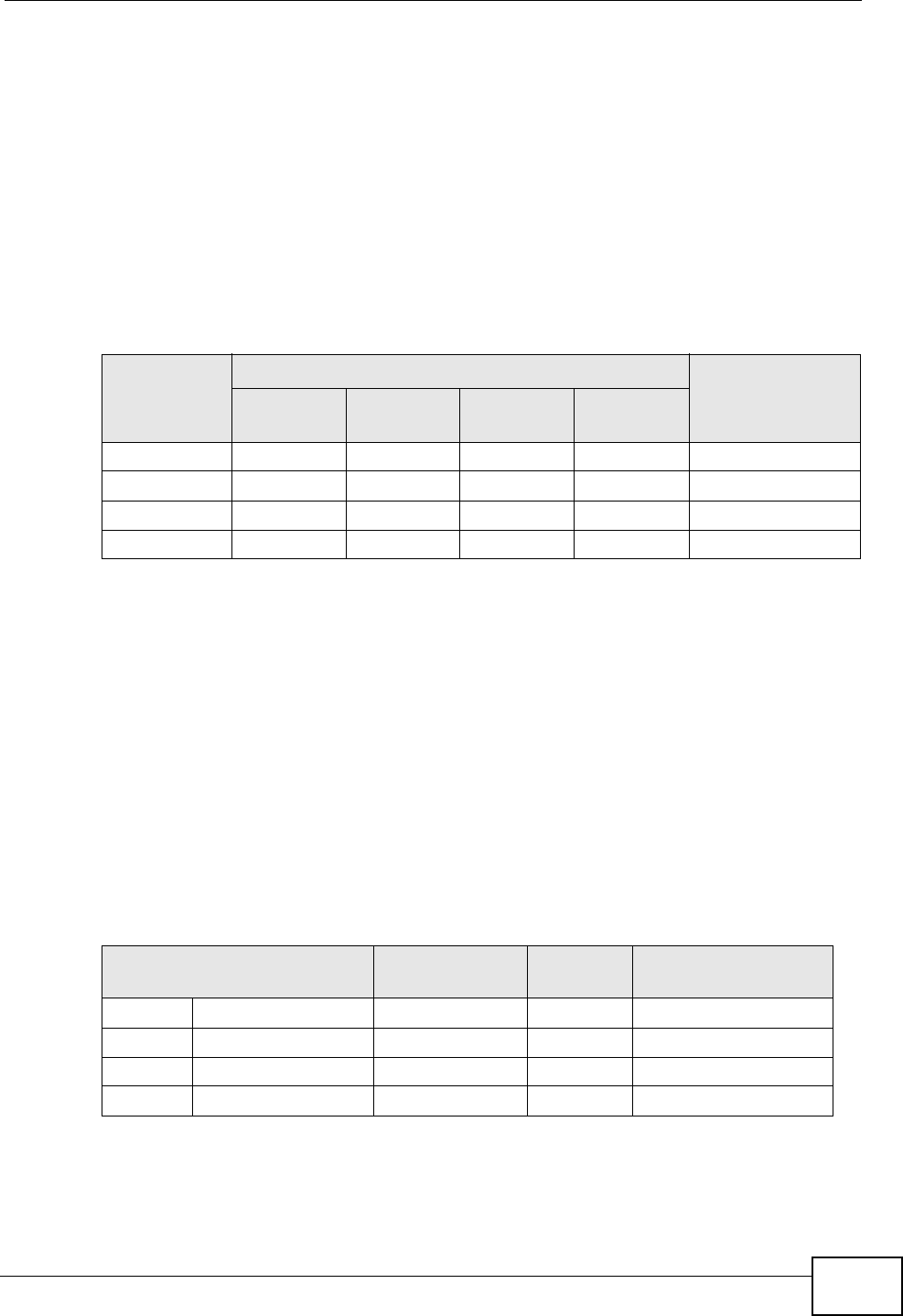
Appendix D IP Addresses and Subnetting
MAX-207HW2R User’s Guide 227
By convention, subnet masks always consist of a continuous sequence of ones
beginning from the leftmost bit of the mask, followed by a continuous sequence of
zeros, for a total number of 32 bits.
Subnet masks can be referred to by the size of the network number part (the bits
with a “1” value). For example, an “8-bit mask” means that the first 8 bits of the
mask are ones and the remaining 24 bits are zeroes.
Subnet masks are expressed in dotted decimal notation just like IP addresses. The
following examples show the binary and decimal notation for 8-bit, 16-bit, 24-bit
and 29-bit subnet masks.
Network Size
The size of the network number determines the maximum number of possible
hosts you can have on your network. The larger the number of network number
bits, the smaller the number of remaining host ID bits.
An IP address with host IDs of all zeros is the IP address of the network
(192.168.1.0 with a 24-bit subnet mask, for example). An IP address with host
IDs of all ones is the broadcast address for that network (192.168.1.255 with a
24-bit subnet mask, for example).
As these two IP addresses cannot be used for individual hosts, calculate the
maximum number of possible hosts in a network as follows:
Table 73 Subnet Masks
BINARY
DECIMAL
1ST
OCTET 2ND
OCTET 3RD
OCTET 4TH
OCTET
8-bit mask 11111111 00000000 00000000 00000000 255.0.0.0
16-bit mask 11111111 11111111 00000000 00000000 255.255.0.0
24-bit mask 11111111 11111111 11111111 00000000 255.255.255.0
29-bit mask 11111111 11111111 11111111 11111000 255.255.255.248
Table 74 Maximum Host Numbers
SUBNET MASK HOST ID SIZE MAXIMUM NUMBER
OF HOSTS
8 bits 255.0.0.0 24 bits 224 – 2 16777214
16 bits 255.255.0.0 16 bits 216 – 2 65534
24 bits 255.255.255.0 8 bits 28 – 2 254
29 bits 255.255.255.248 3 bits 23 – 2 6
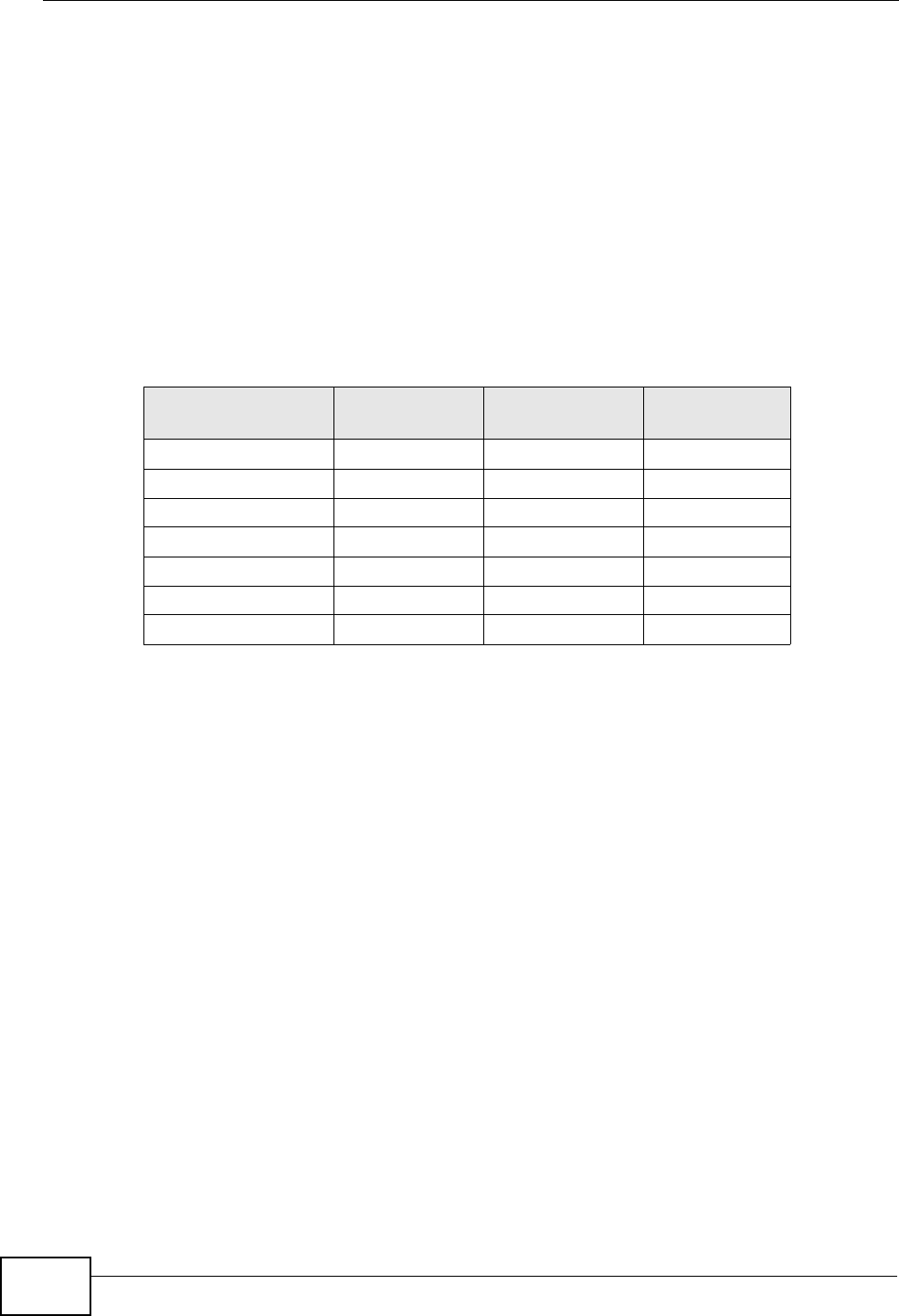
Appendix D IP Addresses and Subnetting
MAX-207HW2R User’s Guide
228
Notation
Since the mask is always a continuous number of ones beginning from the left,
followed by a continuous number of zeros for the remainder of the 32 bit mask,
you can simply specify the number of ones instead of writing the value of each
octet. This is usually specified by writing a “/” followed by the number of bits in
the mask after the address.
For example, 192.1.1.0 /25 is equivalent to saying 192.1.1.0 with subnet mask
255.255.255.128.
The following table shows some possible subnet masks using both notations.
Subnetting
You can use subnetting to divide one network into multiple sub-networks. In the
following example a network administrator creates two sub-networks to isolate a
group of servers from the rest of the company network for security reasons.
In this example, the company network address is 192.168.1.0. The first three
octets of the address (192.168.1) are the network number, and the remaining
octet is the host ID, allowing a maximum of 28 – 2 or 254 possible hosts.
Table 75 Alternative Subnet Mask Notation
SUBNET MASK ALTERNATIVE
NOTATION LAST OCTET
(BINARY) LAST OCTET
(DECIMAL)
255.255.255.0 /24 0000 0000 0
255.255.255.128 /25 1000 0000 128
255.255.255.192 /26 1100 0000 192
255.255.255.224 /27 1110 0000 224
255.255.255.240 /28 1111 0000 240
255.255.255.248 /29 1111 1000 248
255.255.255.252 /30 1111 1100 252
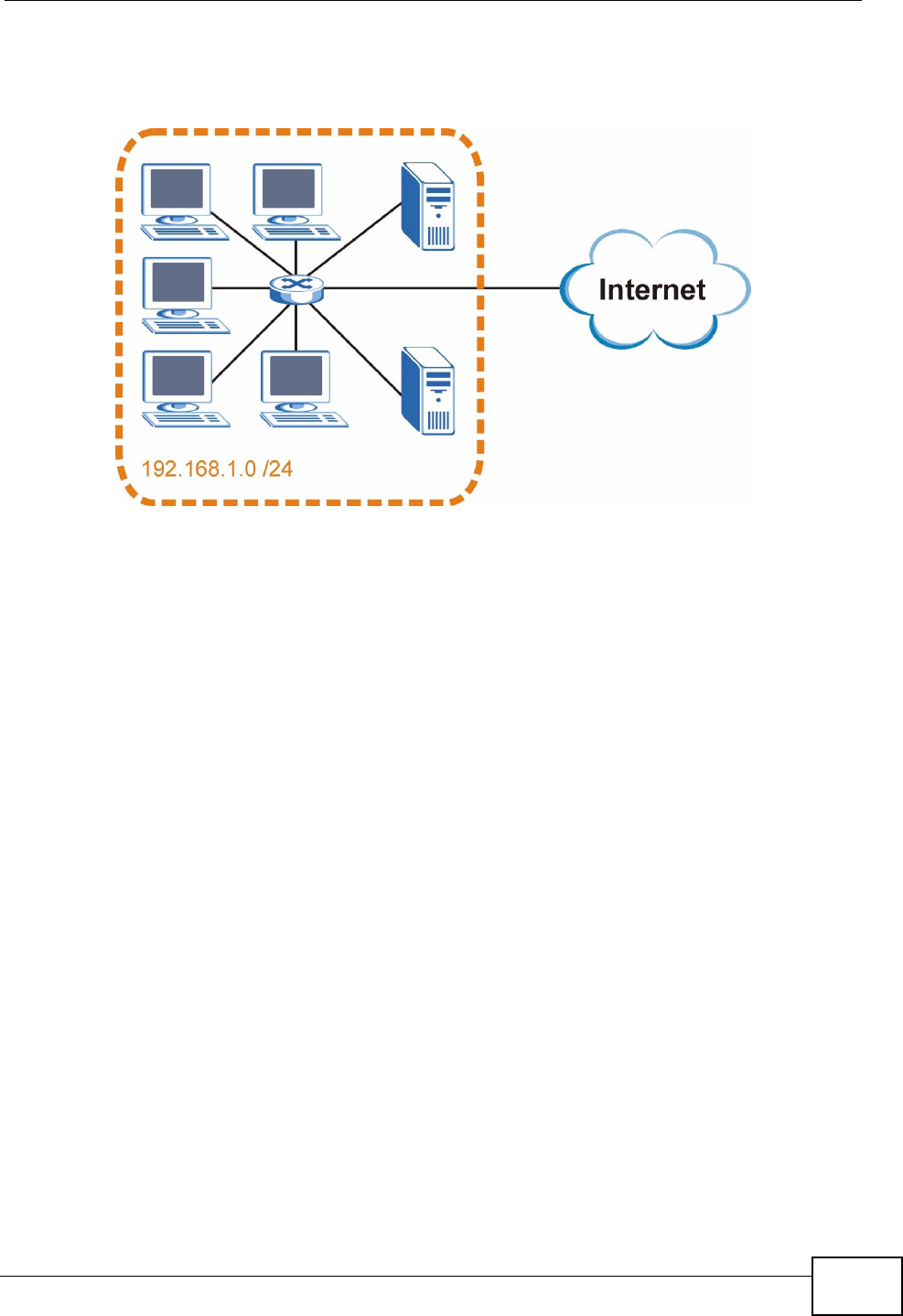
Appendix D IP Addresses and Subnetting
MAX-207HW2R User’s Guide 229
The following figure shows the company network before subnetting.
Figure 123 Subnetting Example: Before Subnetting
You can “borrow” one of the host ID bits to divide the network 192.168.1.0 into
two separate sub-networks. The subnet mask is now 25 bits (255.255.255.128 or
/25).
The “borrowed” host ID bit can have a value of either 0 or 1, allowing two
subnets; 192.168.1.0 /25 and 192.168.100.128 /25.
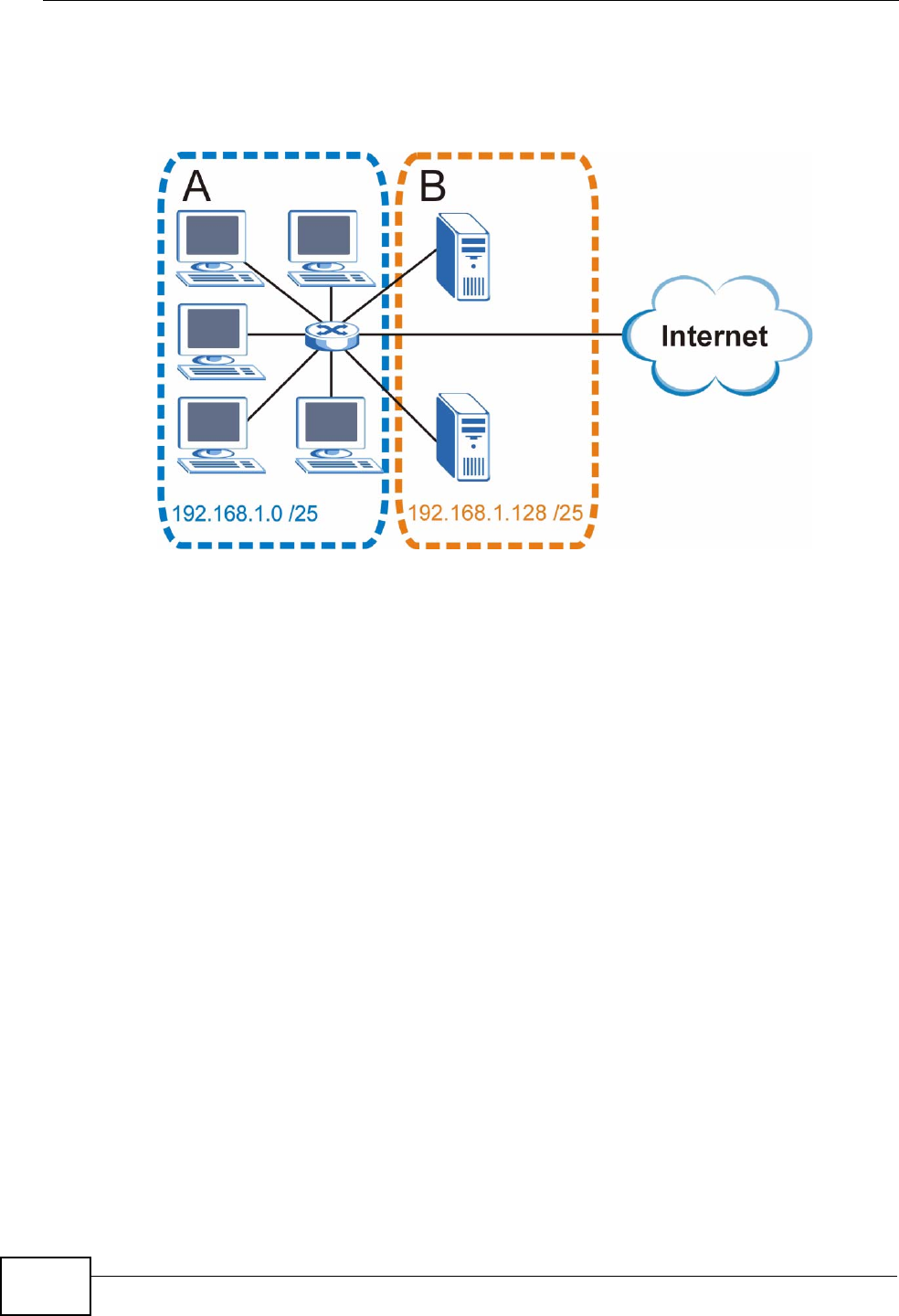
Appendix D IP Addresses and Subnetting
MAX-207HW2R User’s Guide
230
The following figure shows the company network after subnetting. There are now
two sub-networks, A and B.
Figure 124 Subnetting Example: After Subnetting
In a 25-bit subnet the host ID has 7 bits, so each sub-network has a maximum of
27 – 2 or 126 possible hosts (a host ID of all zeroes is the subnet’s address itself,
all ones is the subnet’s broadcast address).
192.168.1.0 with mask 255.255.255.128 is subnet A itself, and 192.168.100.127
with mask 255.255.255.128 is its broadcast address. Therefore, the lowest IP
address that can be assigned to an actual host for subnet A is 192.168.100.1 and
the highest is 192.168.100.126.
Similarly, the host ID range for subnet B is 192.168.100.129 to 192.168.1.254.
Example: Four Subnets
The previous example illustrated using a 25-bit subnet mask to divide a 24-bit
address into two subnets. Similarly, to divide a 24-bit address into four subnets,
you need to “borrow” two host ID bits to give four possible combinations (00, 01,
10 and 11). The subnet mask is 26 bits
(11111111.11111111.11111111.11000000) or 255.255.255.192.

Appendix D IP Addresses and Subnetting
MAX-207HW2R User’s Guide 231
Each subnet contains 6 host ID bits, giving 26 - 2 or 62 hosts for each subnet (a
host ID of all zeroes is the subnet itself, all ones is the subnet’s broadcast
address).
Table 76 Subnet 1
IP/SUBNET MASK NETWORK NUMBER LAST OCTET BIT
VALUE
IP Address (Decimal) 192.168.1. 0
IP Address (Binary) 11000000.10101000.00000001. 00000000
Subnet Mask (Binary) 11111111.11111111.11111111. 11000000
Subnet Address:
192.168.1.0 Lowest Host ID: 192.168.100.1
Broadcast Address:
192.168.1.63 Highest Host ID: 192.168.1.62
Table 77 Subnet 2
IP/SUBNET MASK NETWORK NUMBER LAST OCTET BIT
VALUE
IP Address 192.168.1. 64
IP Address (Binary) 11000000.10101000.00000001. 01000000
Subnet Mask (Binary) 11111111.11111111.11111111. 11000000
Subnet Address:
192.168.1.64 Lowest Host ID: 192.168.1.65
Broadcast Address:
192.168.100.127 Highest Host ID: 192.168.100.126
Table 78 Subnet 3
IP/SUBNET MASK NETWORK NUMBER LAST OCTET BIT
VALUE
IP Address 192.168.1. 128
IP Address (Binary) 11000000.10101000.00000001. 10000000
Subnet Mask (Binary) 11111111.11111111.11111111. 11000000
Subnet Address:
192.168.100.128 Lowest Host ID: 192.168.100.129
Broadcast Address:
192.168.100.191 Highest Host ID: 192.168.100.190
Table 79 Subnet 4
IP/SUBNET MASK NETWORK NUMBER LAST OCTET BIT
VALUE
IP Address 192.168.1. 192
IP Address (Binary) 11000000.10101000.00000001. 11000000
Subnet Mask (Binary) 11111111.11111111.11111111. 11000000
Subnet Address:
192.168.100.192 Lowest Host ID: 192.168.100.193
Broadcast Address:
192.168.1.255 Highest Host ID: 192.168.1.254
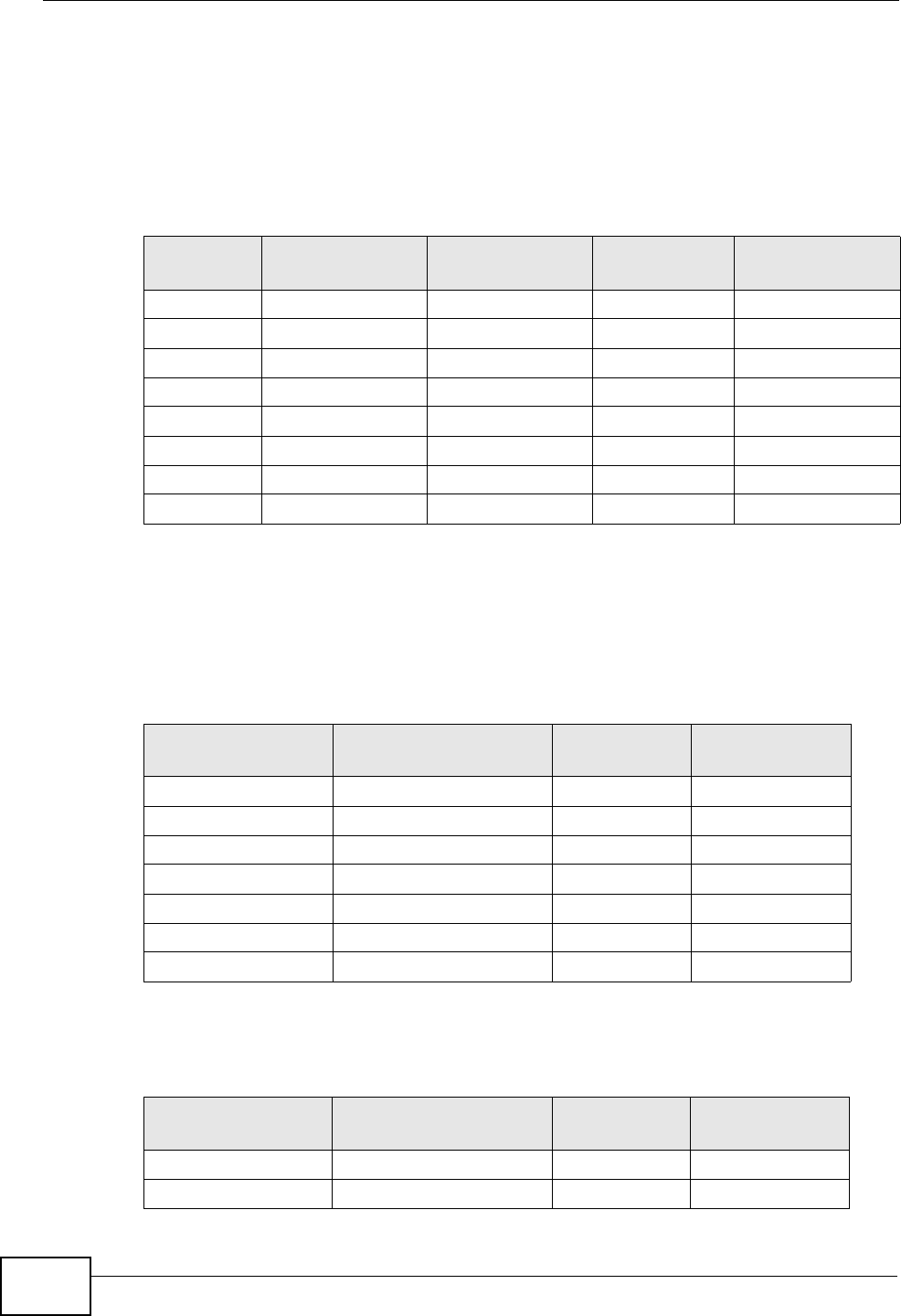
Appendix D IP Addresses and Subnetting
MAX-207HW2R User’s Guide
232
Example: Eight Subnets
Similarly, use a 27-bit mask to create eight subnets (000, 001, 010, 011, 100,
101, 110 and 111).
The following table shows IP address last octet values for each subnet.
Subnet Planning
The following table is a summary for subnet planning on a network with a 24-bit
network number.
The following table is a summary for subnet planning on a network with a 16-bit
network number.
Table 80 Eight Subnets
SUBNET SUBNET
ADDRESS FIRST ADDRESS LAST
ADDRESS BROADCAST
ADDRESS
1 0 1 30 31
232 33 62 63
364 65 94 95
496 97 126 127
5128 129 158 159
6160 161 190 191
7192 193 222 223
8224 225 254 255
Table 81 24-bit Network Number Subnet Planning
NO. “BORROWED”
HOST BITS SUBNET MASK NO. SUBNETS NO. HOSTS PER
SUBNET
1255.255.255.128 (/25) 2126
2255.255.255.192 (/26) 462
3255.255.255.224 (/27) 830
4255.255.255.240 (/28) 16 14
5255.255.255.248 (/29) 32 6
6255.255.255.252 (/30) 64 2
7255.255.255.254 (/31) 128 1
Table 82 16-bit Network Number Subnet Planning
NO. “BORROWED”
HOST BITS SUBNET MASK NO. SUBNETS NO. HOSTS PER
SUBNET
1255.255.128.0 (/17) 232766
2255.255.192.0 (/18) 416382
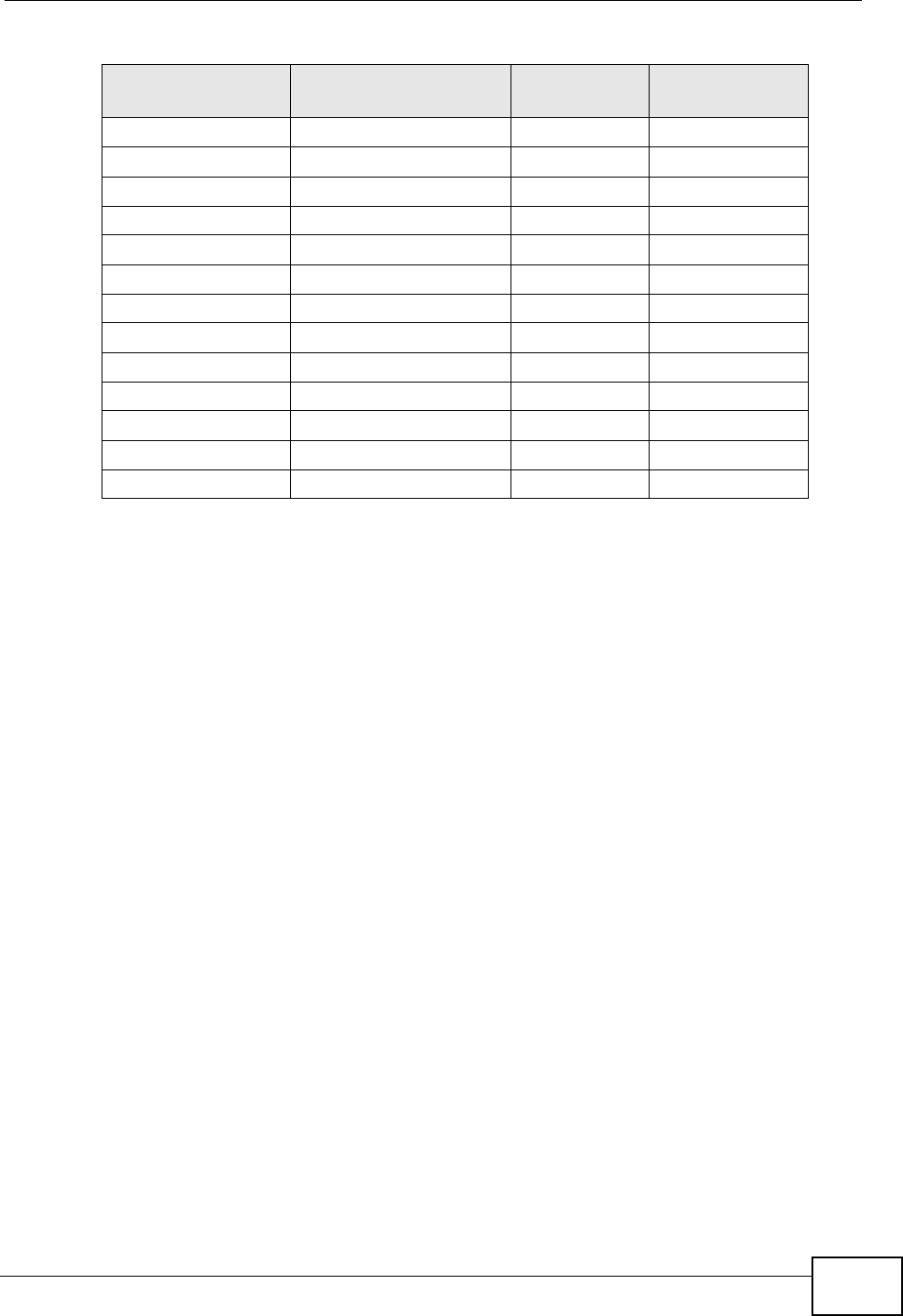
Appendix D IP Addresses and Subnetting
MAX-207HW2R User’s Guide 233
Configuring IP Addresses
Where you obtain your network number depends on your particular situation. If
the ISP or your network administrator assigns you a block of registered IP
addresses, follow their instructions in selecting the IP addresses and the subnet
mask.
If the ISP did not explicitly give you an IP network number, then most likely you
have a single user account and the ISP will assign you a dynamic IP address when
the connection is established. If this is the case, it is recommended that you select
a network number from 192.168.0.0 to 192.168.255.0. The Internet Assigned
Number Authority (IANA) reserved this block of addresses specifically for private
use; please do not use any other number unless you are told otherwise. You must
also enable Network Address Translation (NAT) on the MAX-207HW2R.
Once you have decided on the network number, pick an IP address for your MAX-
207HW2R that is easy to remember (for instance, 192.168.100.1) but make sure
that no other device on your network is using that IP address.
The subnet mask specifies the network number portion of an IP address. Your
MAX-207HW2R will compute the subnet mask automatically based on the IP
address that you entered. You don't need to change the subnet mask computed by
the MAX-207HW2R unless you are instructed to do otherwise.
3255.255.224.0 (/19) 88190
4255.255.240.0 (/20) 16 4094
5255.255.248.0 (/21) 32 2046
6255.255.252.0 (/22) 64 1022
7255.255.254.0 (/23) 128 510
8255.255.255.0 (/24) 256 254
9255.255.255.128 (/25) 512 126
10 255.255.255.192 (/26) 1024 62
11 255.255.255.224 (/27) 2048 30
12 255.255.255.240 (/28) 4096 14
13 255.255.255.248 (/29) 8192 6
14 255.255.255.252 (/30) 16384 2
15 255.255.255.254 (/31) 32768 1
Table 82 16-bit Network Number Subnet Planning (continued)
NO. “BORROWED”
HOST BITS SUBNET MASK NO. SUBNETS NO. HOSTS PER
SUBNET

Appendix D IP Addresses and Subnetting
MAX-207HW2R User’s Guide
234
Private IP Addresses
Every machine on the Internet must have a unique address. If your networks are
isolated from the Internet (running only between two branch offices, for example)
you can assign any IP addresses to the hosts without problems. However, the
Internet Assigned Numbers Authority (IANA) has reserved the following three
blocks of IP addresses specifically for private networks:
• 10.0.0.0 — 10.255.255.255
• 172.16.0.0 — 172.31.255.255
• 192.168.0.0 — 192.168.255.255
You can obtain your IP address from the IANA, from an ISP, or it can be assigned
from a private network. If you belong to a small organization and your Internet
access is through an ISP, the ISP can provide you with the Internet addresses for
your local networks. On the other hand, if you are part of a much larger
organization, you should consult your network administrator for the appropriate IP
addresses.
Regardless of your particular situation, do not create an arbitrary IP address;
always follow the guidelines above. For more information on address assignment,
please refer to RFC 1597, Address Allocation for Private Internets and RFC 1466,
Guidelines for Management of IP Address Space.
IP Address Conflicts
Each device on a network must have a unique IP address. Devices with duplicate
IP addresses on the same network will not be able to access the Internet or other
resources. The devices may also be unreachable through the network.
Conflicting Computer IP Addresses Example
More than one device can not use the same IP address. In the following example
computer A has a static (or fixed) IP address that is the same as the IP address
that a DHCP server assigns to computer B which is a DHCP client. Neither can
access the Internet. This problem can be solved by assigning a different static IP
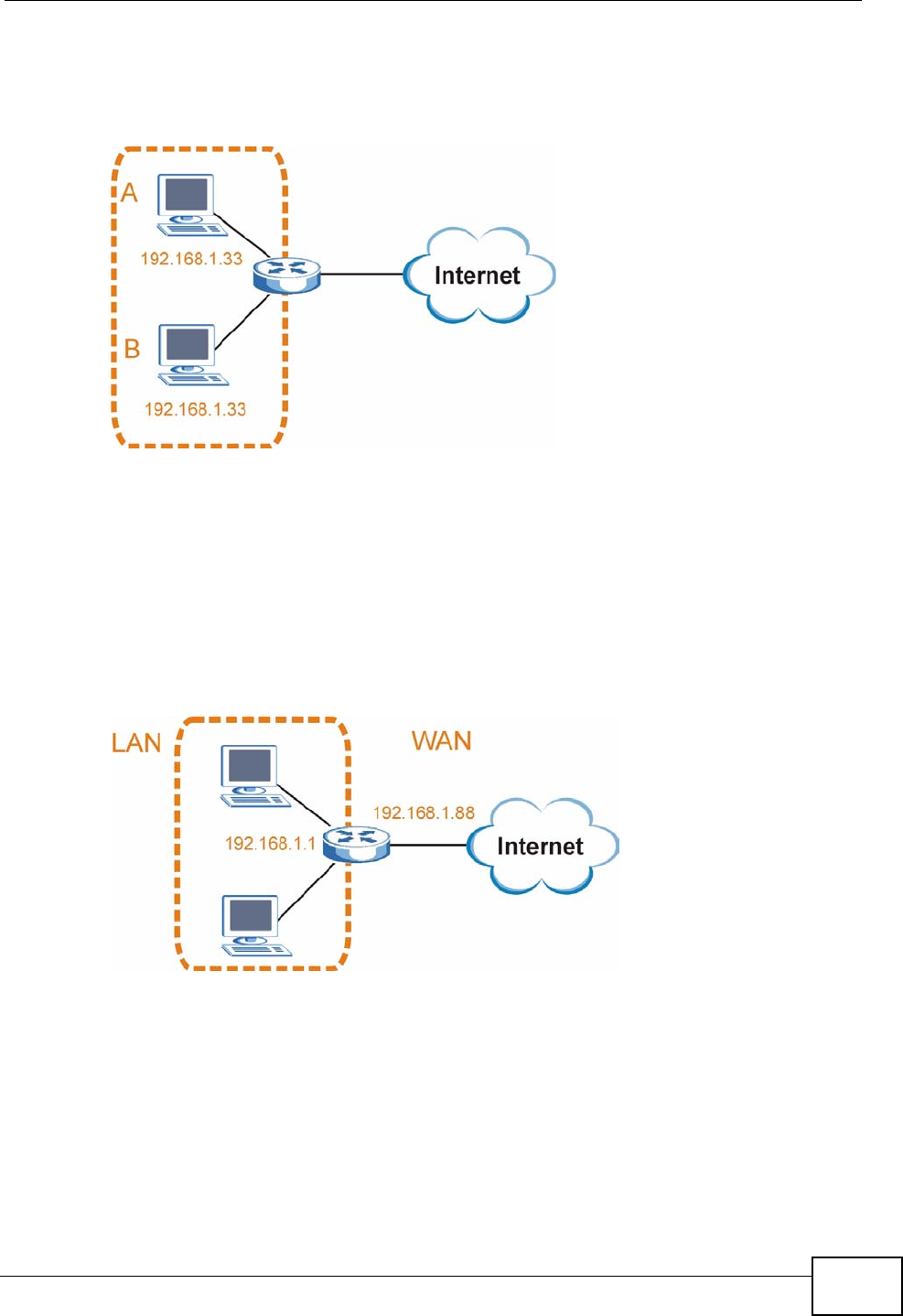
Appendix D IP Addresses and Subnetting
MAX-207HW2R User’s Guide 235
address to computer A or setting computer A to obtain an IP address
automatically.
Figure 125 Conflicting Computer IP Addresses Example
Conflicting Router IP Addresses Example
Since a router connects different networks, it must have interfaces using different
network numbers. For example, if a router is set between a LAN and the Internet
(WAN), the router’s LAN and WAN addresses must be on different subnets. In the
following example, the LAN and WAN are on the same subnet. The LAN computers
cannot access the Internet because the router cannot route between networks.
Figure 126 Conflicting Computer IP Addresses Example
Conflicting Computer and Router IP Addresses Example
More than one device can not use the same IP address. In the following example,
the computer and the router’s LAN port both use 192.168.100.1 as the IP address.
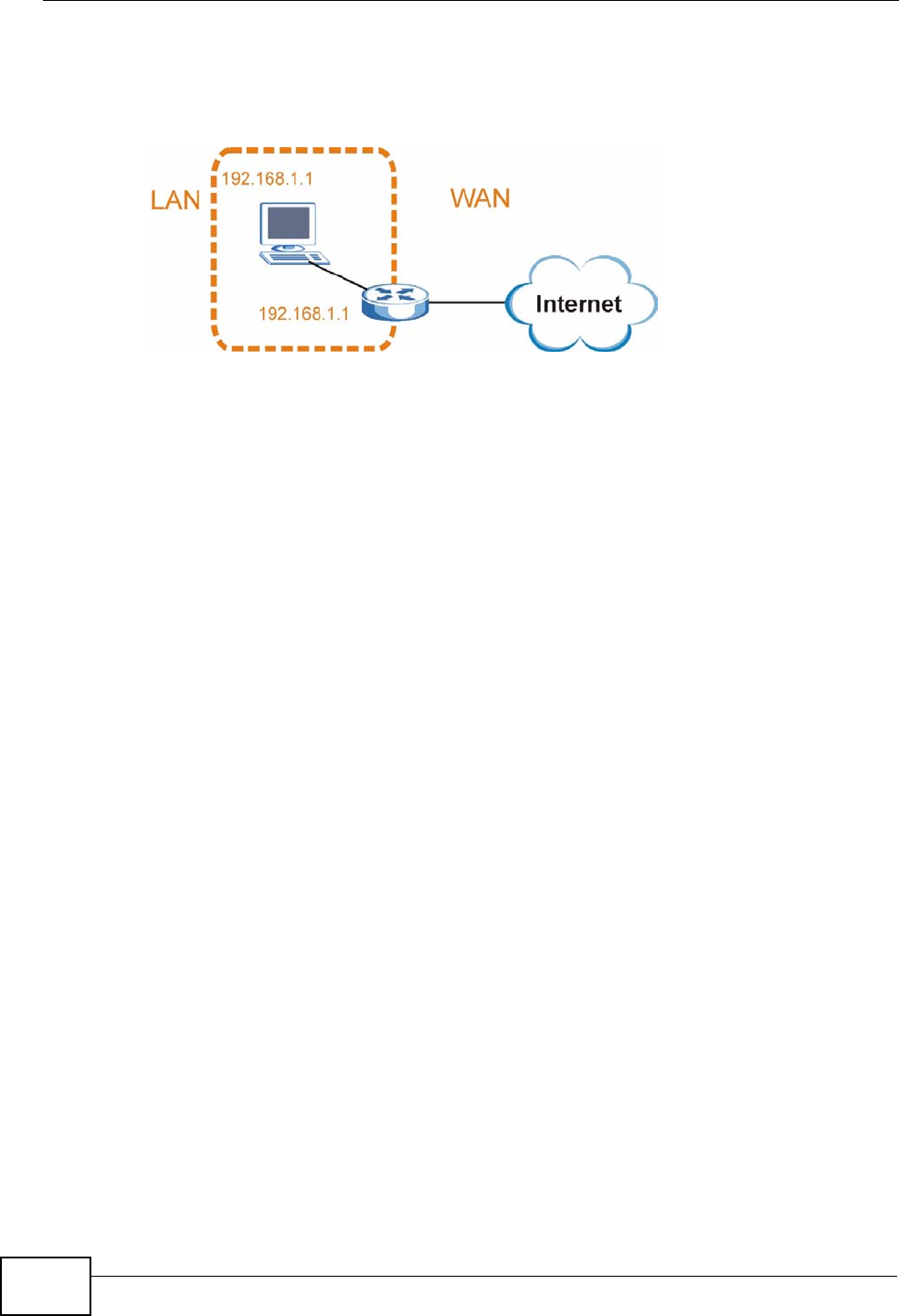
Appendix D IP Addresses and Subnetting
MAX-207HW2R User’s Guide
236
The computer cannot access the Internet. This problem can be solved by
assigning a different IP address to the computer or the router’s LAN port.
Figure 127 Conflicting Computer and Router IP Addresses Example

MAX-207HW2R User’s Guide 237
APPENDIX E
Importing Certificates
This appendix shows you how to import public key certificates into your web
browser.
Public key certificates are used by web browsers to ensure that a secure web site
is legitimate. When a certificate authority such as VeriSign, Comodo, or Network
Solutions, to name a few, receives a certificate request from a website operator,
they confirm that the web domain and contact information in the request match
those on public record with a domain name registrar. If they match, then the
certificate is issued to the website operator, who then places it on the site to be
issued to all visiting web browsers to let them know that the site is legitimate.
Many ZyXEL products, such as the NSA-2401, issue their own public key
certificates. These can be used by web browsers on a LAN or WAN to verify that
they are in fact connecting to the legitimate device and not one masquerading as
it. However, because the certificates were not issued by one of the several
organizations officially recognized by the most common web browsers, you will
need to import the ZyXEL-created certificate into your web browser and flag that
certificate as a trusted authority.
Note: You can see if you are browsing on a secure website if the URL in your web
browser’s address bar begins with https:// or there is a sealed padlock
icon ( ) somewhere in the main browser window (not all browsers show the
padlock in the same location.)
In this appendix, you can import a public key certificate for:
• Internet Explorer on page 238
•Firefox on page 248
•Opera on page 254
• Konqueror on page 262
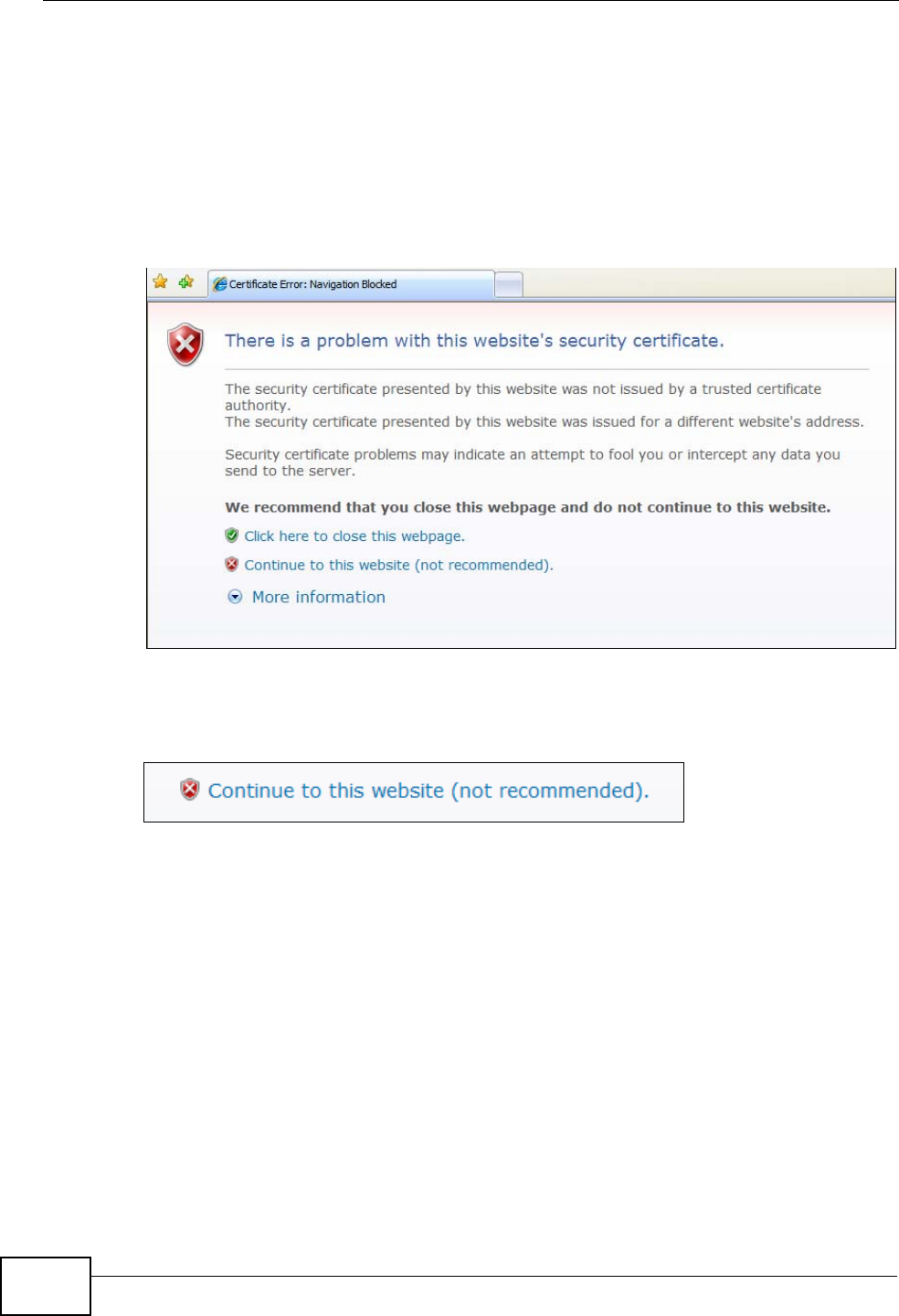
Appendix E Importing Certificates
MAX-207HW2R User’s Guide
238
Internet Explorer
The following example uses Microsoft Internet Explorer 7 on Windows XP
Professional; however, they can also apply to Internet Explorer on Windows Vista.
1If your device’s web configurator is set to use SSL certification, then the first time
you browse to it you are presented with a certification error.
Figure 128 Internet Explorer 7: Certification Error
2Click Continue to this website (not recommended).
Figure 129 Internet Explorer 7: Certification Error
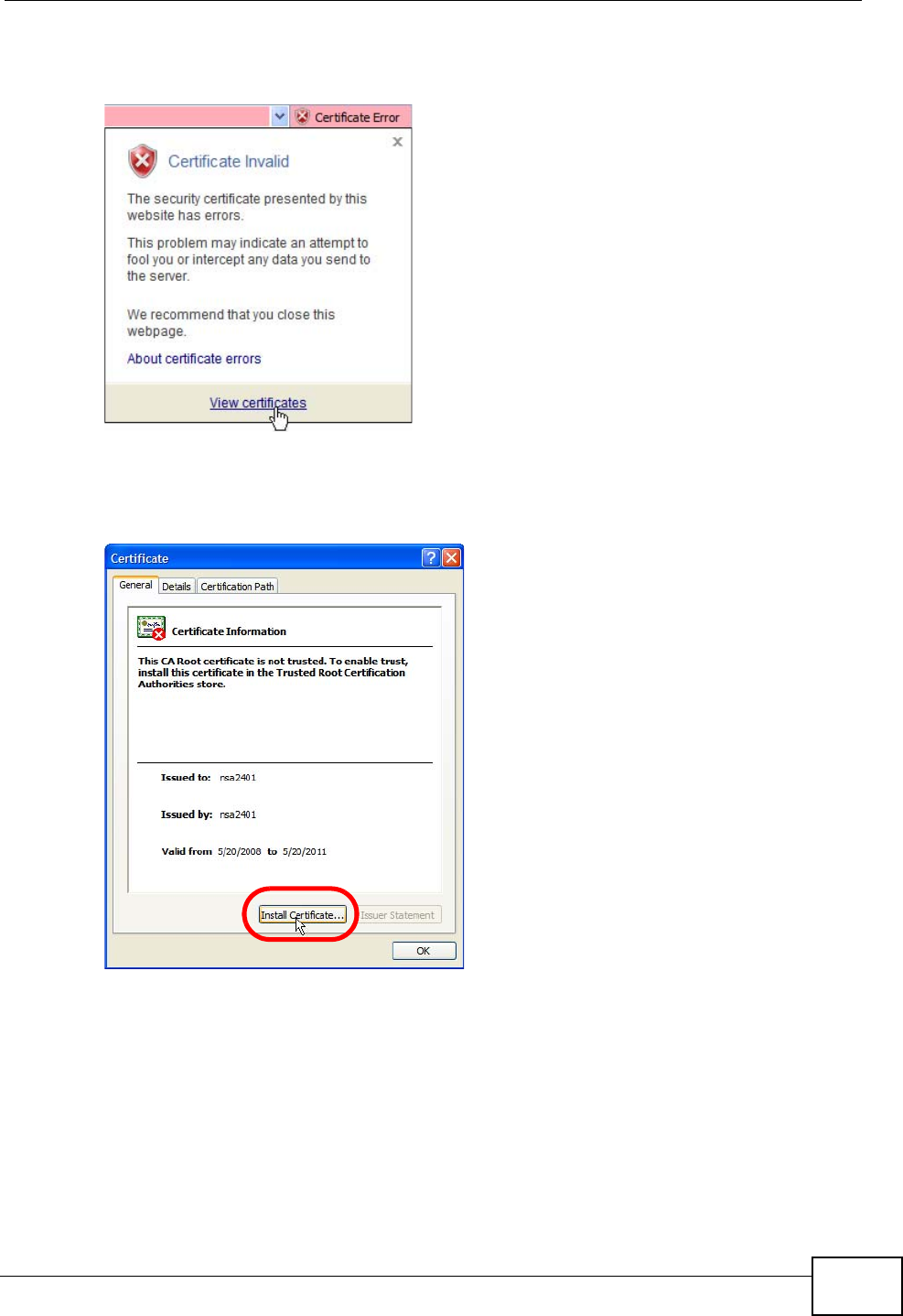
Appendix E Importing Certificates
MAX-207HW2R User’s Guide 239
3In the Address Bar, click Certificate Error > View certificates.
Figure 130 Internet Explorer 7: Certificate Error
4In the Certificate dialog box, click Install Certificate.
Figure 131 Internet Explorer 7: Certificate
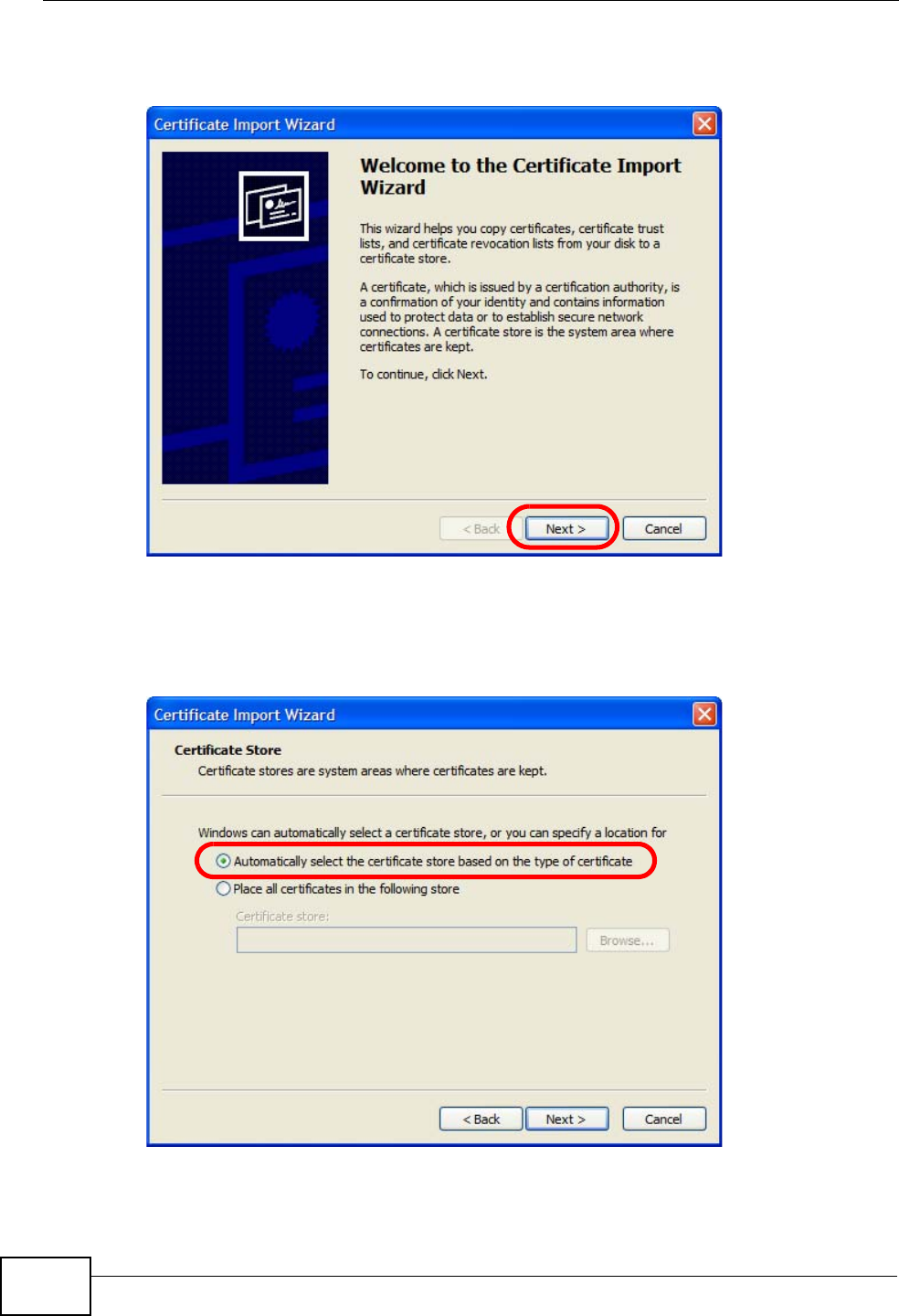
Appendix E Importing Certificates
MAX-207HW2R User’s Guide
240
5In the Certificate Import Wizard, click Next.
Figure 132 Internet Explorer 7: Certificate Import Wizard
6If you want Internet Explorer to Automatically select certificate store based
on the type of certificate, click Next again and then go to step 9.
Figure 133 Internet Explorer 7: Certificate Import Wizard
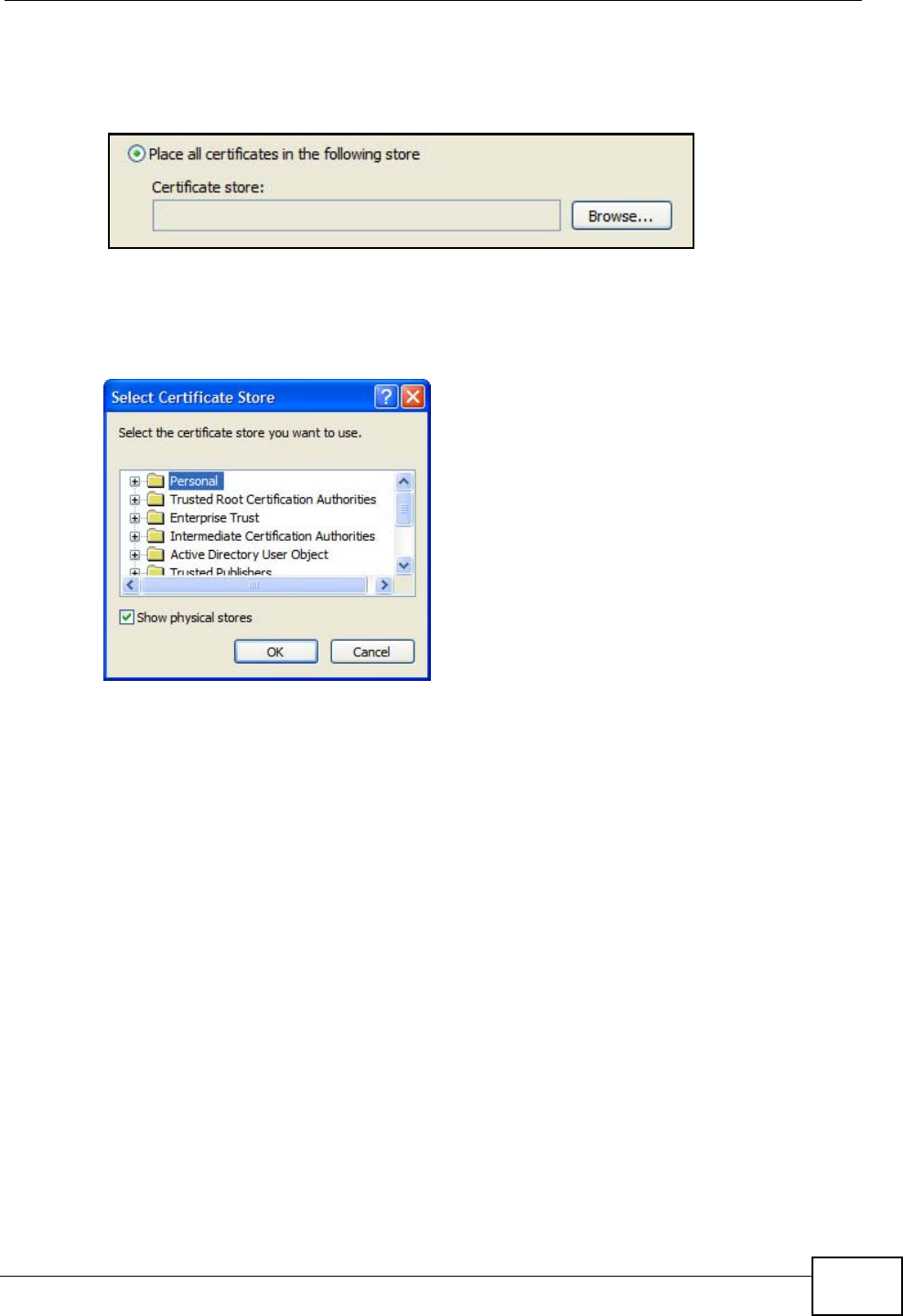
Appendix E Importing Certificates
MAX-207HW2R User’s Guide 241
7Otherwise, select Place all certificates in the following store and then click
Browse.
Figure 134 Internet Explorer 7: Certificate Import Wizard
8In the Select Certificate Store dialog box, choose a location in which to save the
certificate and then click OK.
Figure 135 Internet Explorer 7: Select Certificate Store
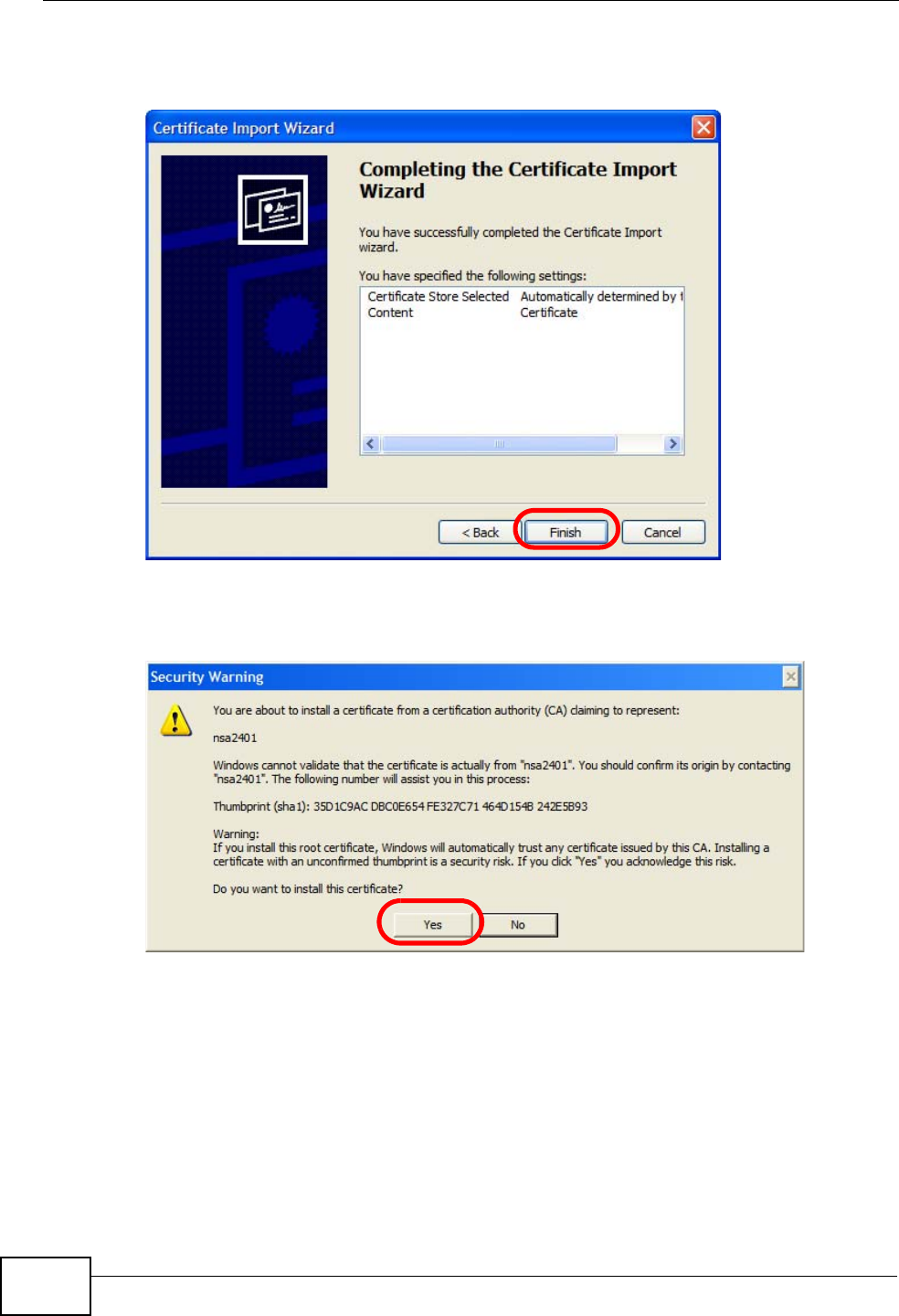
Appendix E Importing Certificates
MAX-207HW2R User’s Guide
242
9In the Completing the Certificate Import Wizard screen, click Finish.
Figure 136 Internet Explorer 7: Certificate Import Wizard
10 If you are presented with another Security Warning, click Yes.
Figure 137 Internet Explorer 7: Security Warning
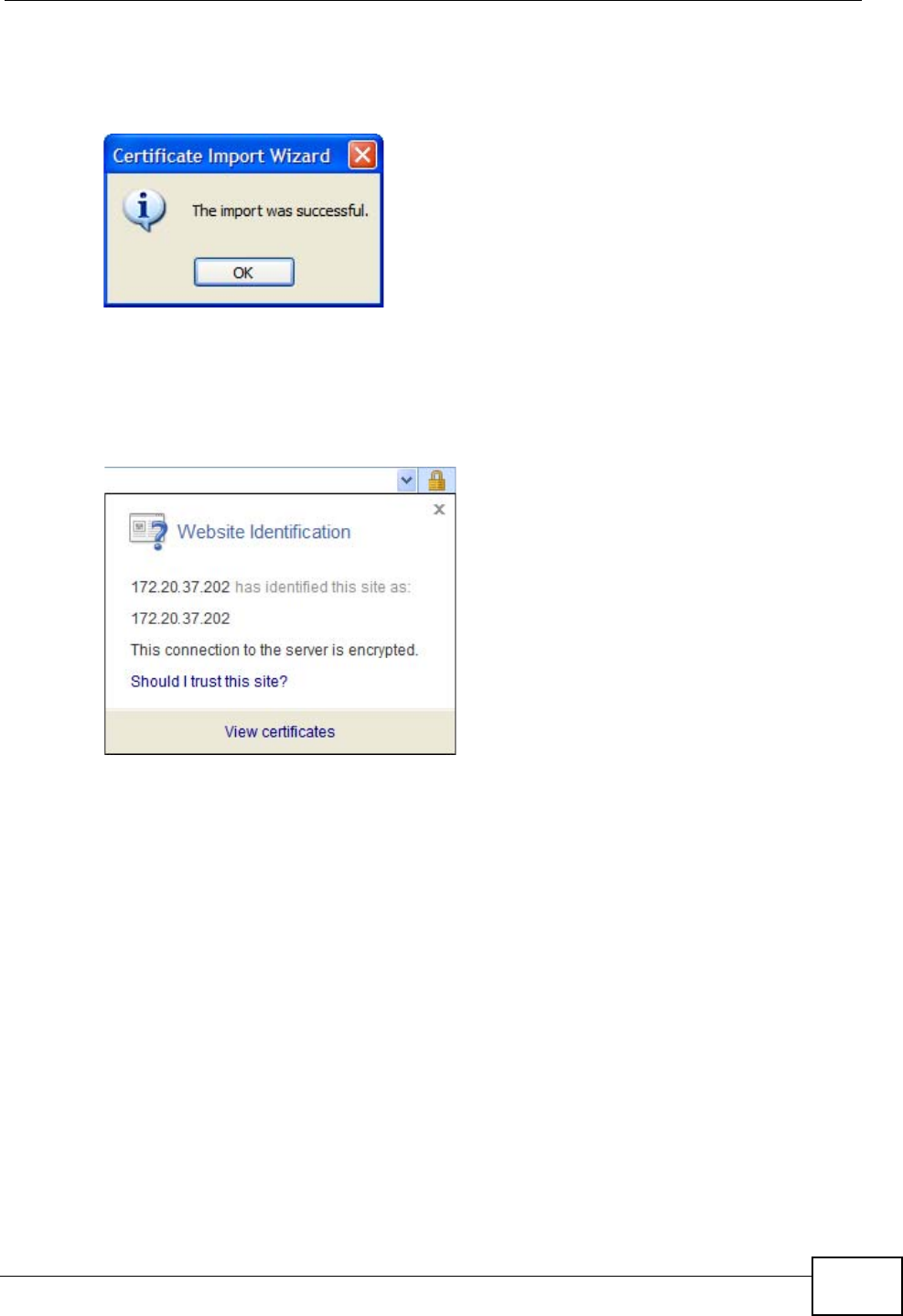
Appendix E Importing Certificates
MAX-207HW2R User’s Guide 243
11 Finally, click OK when presented with the successful certificate installation
message.
Figure 138 Internet Explorer 7: Certificate Import Wizard
12 The next time you start Internet Explorer and go to a ZyXEL web configurator
page, a sealed padlock icon appears in the address bar. Click it to view the page’s
Website Identification information.
Figure 139 Internet Explorer 7: Website Identification
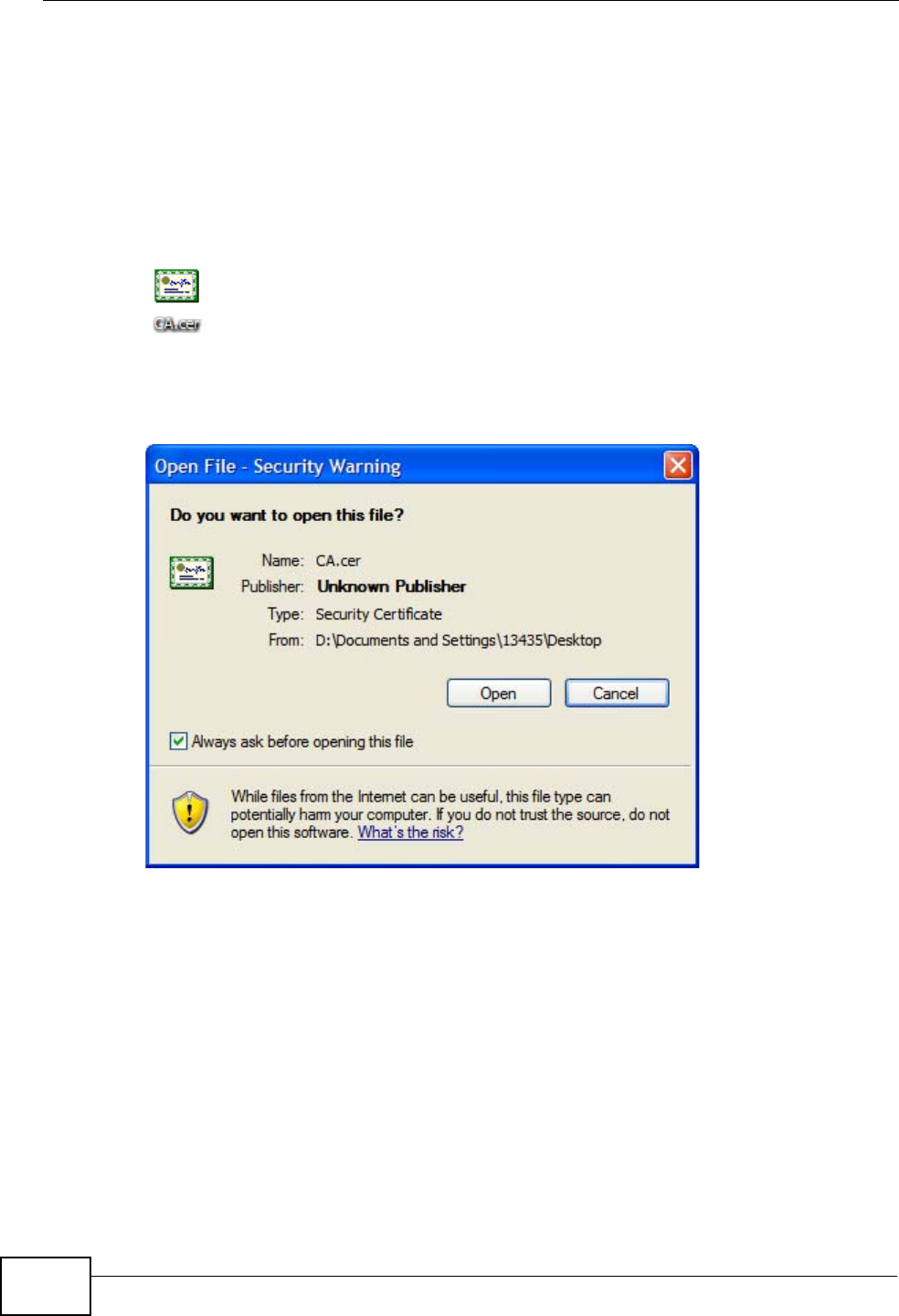
Appendix E Importing Certificates
MAX-207HW2R User’s Guide
244
Installing a Stand-Alone Certificate File in Internet Explorer
Rather than browsing to a ZyXEL web configurator and installing a public key
certificate when prompted, you can install a stand-alone certificate file if one has
been issued to you.
1Double-click the public key certificate file.
Figure 140 Internet Explorer 7: Public Key Certificate File
2In the security warning dialog box, click Open.
Figure 141 Internet Explorer 7: Open File - Security Warning
3Refer to steps 4-12 in the Internet Explorer procedure beginning on page 238 to
complete the installation process.
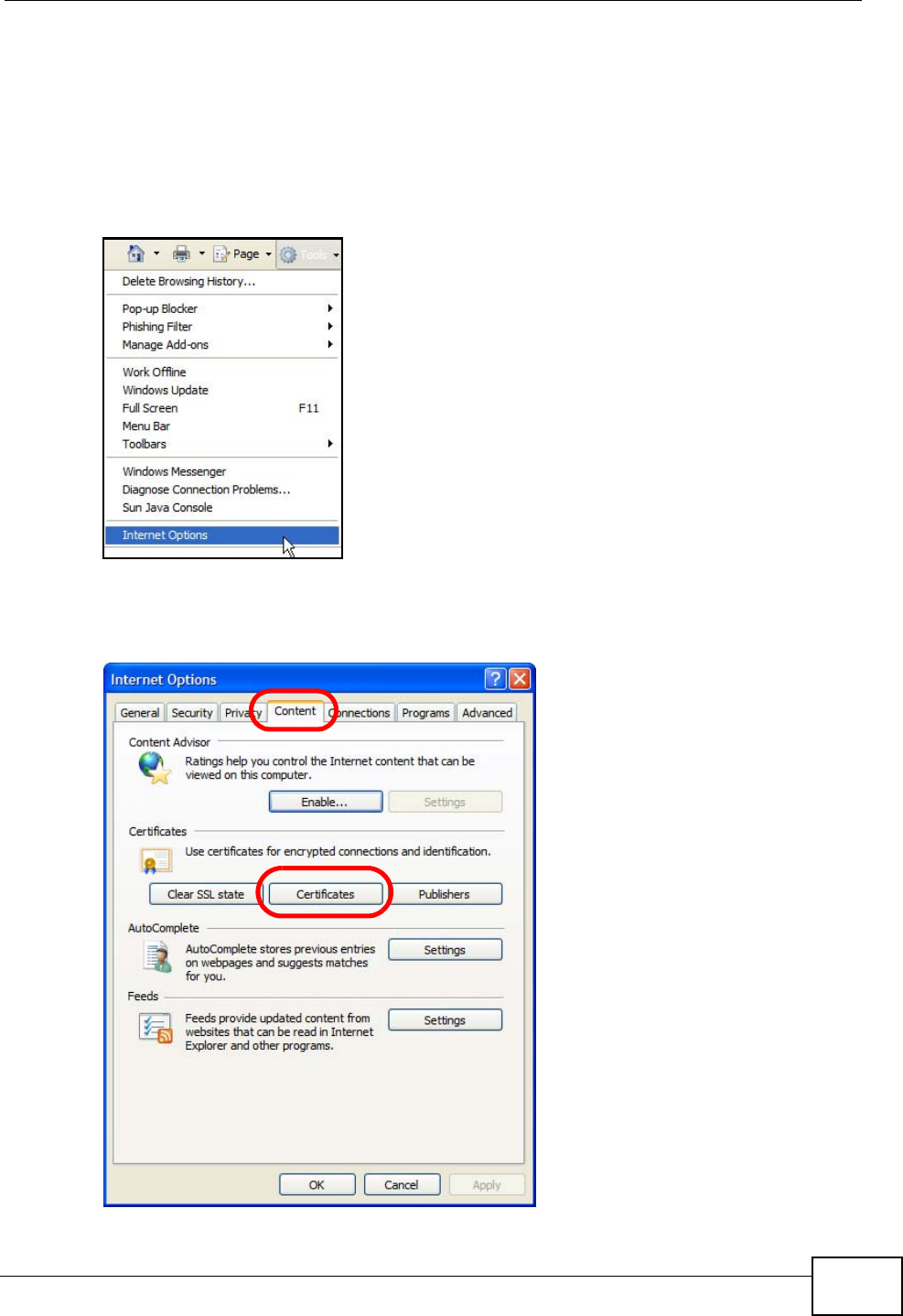
Appendix E Importing Certificates
MAX-207HW2R User’s Guide 245
Removing a Certificate in Internet Explorer
This section shows you how to remove a public key certificate in Internet Explorer
7.
1Open Internet Explorer and click TOOLS > Internet Options.
Figure 142 Internet Explorer 7: Tools Menu
2In the Internet Options dialog box, click Content > Certificates.
Figure 143 Internet Explorer 7: Internet Options
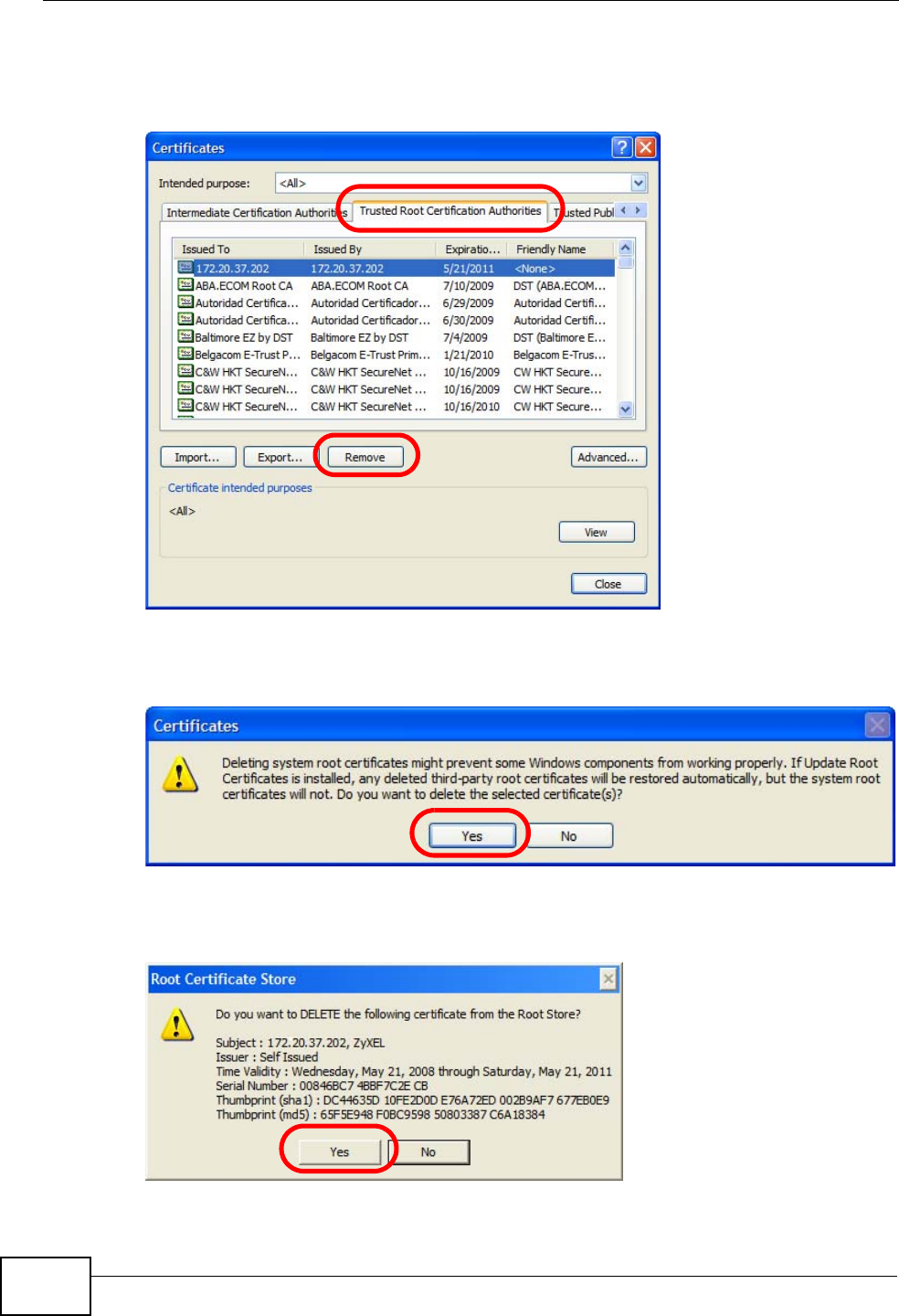
Appendix E Importing Certificates
MAX-207HW2R User’s Guide
246
3In the Certificates dialog box, click the Trusted Root Certificates Authorities
tab, select the certificate that you want to delete, and then click Remove.
Figure 144 Internet Explorer 7: Certificates
4In the Certificates confirmation, click Yes.
Figure 145 Internet Explorer 7: Certificates
5In the Root Certificate Store dialog box, click Yes.
Figure 146 Internet Explorer 7: Root Certificate Store

Appendix E Importing Certificates
MAX-207HW2R User’s Guide 247
6The next time you go to the web site that issued the public key certificate you just
removed, a certification error appears.
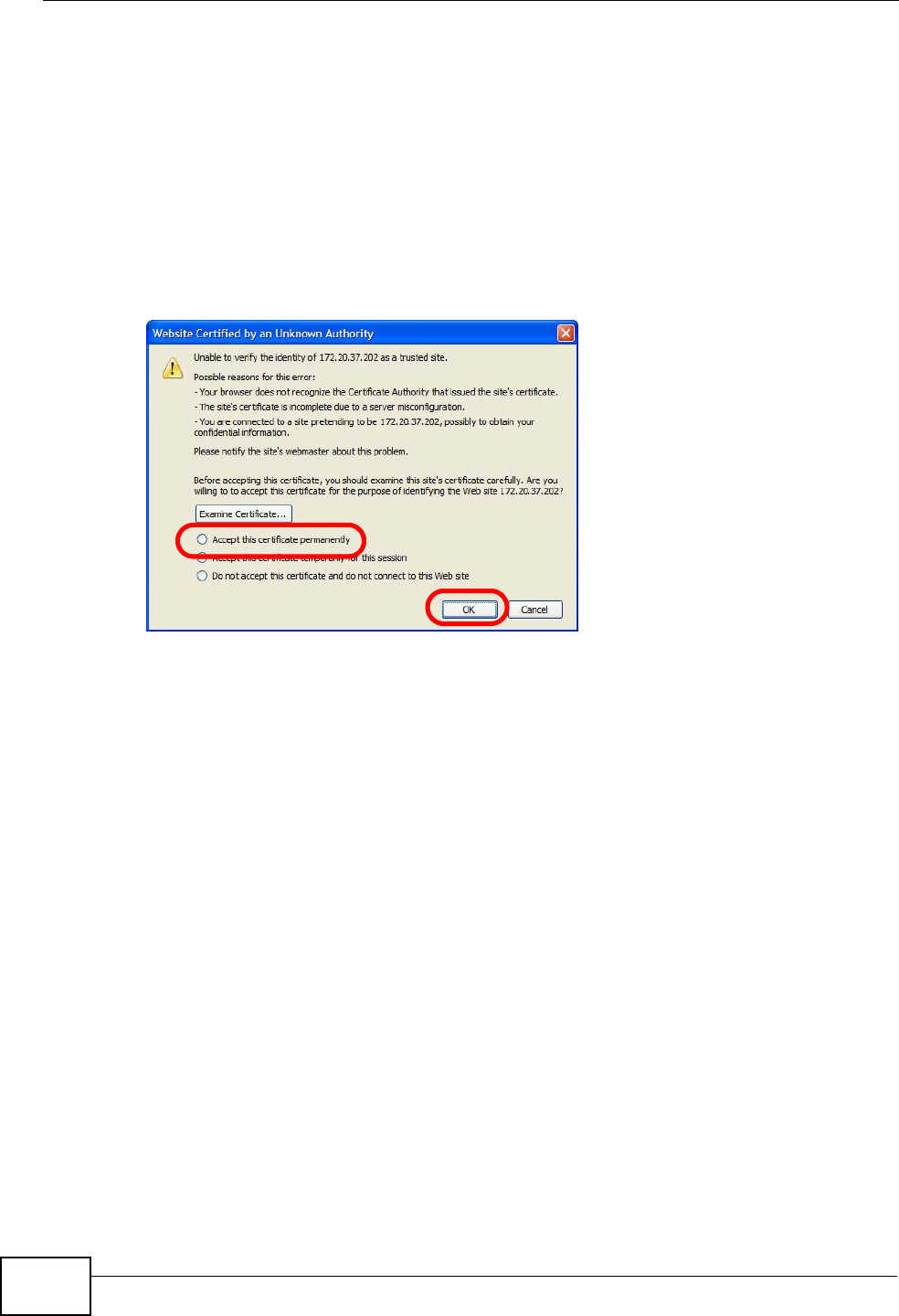
Appendix E Importing Certificates
MAX-207HW2R User’s Guide
248
Firefox
The following example uses Mozilla Firefox 2 on Windows XP Professional;
however, the screens can also apply to Firefox 2 on all platforms.
1If your device’s web configurator is set to use SSL certification, then the first time
you browse to it you are presented with a certification error.
2Select Accept this certificate permanently and click OK.
Figure 147 Firefox 2: Website Certified by an Unknown Authority
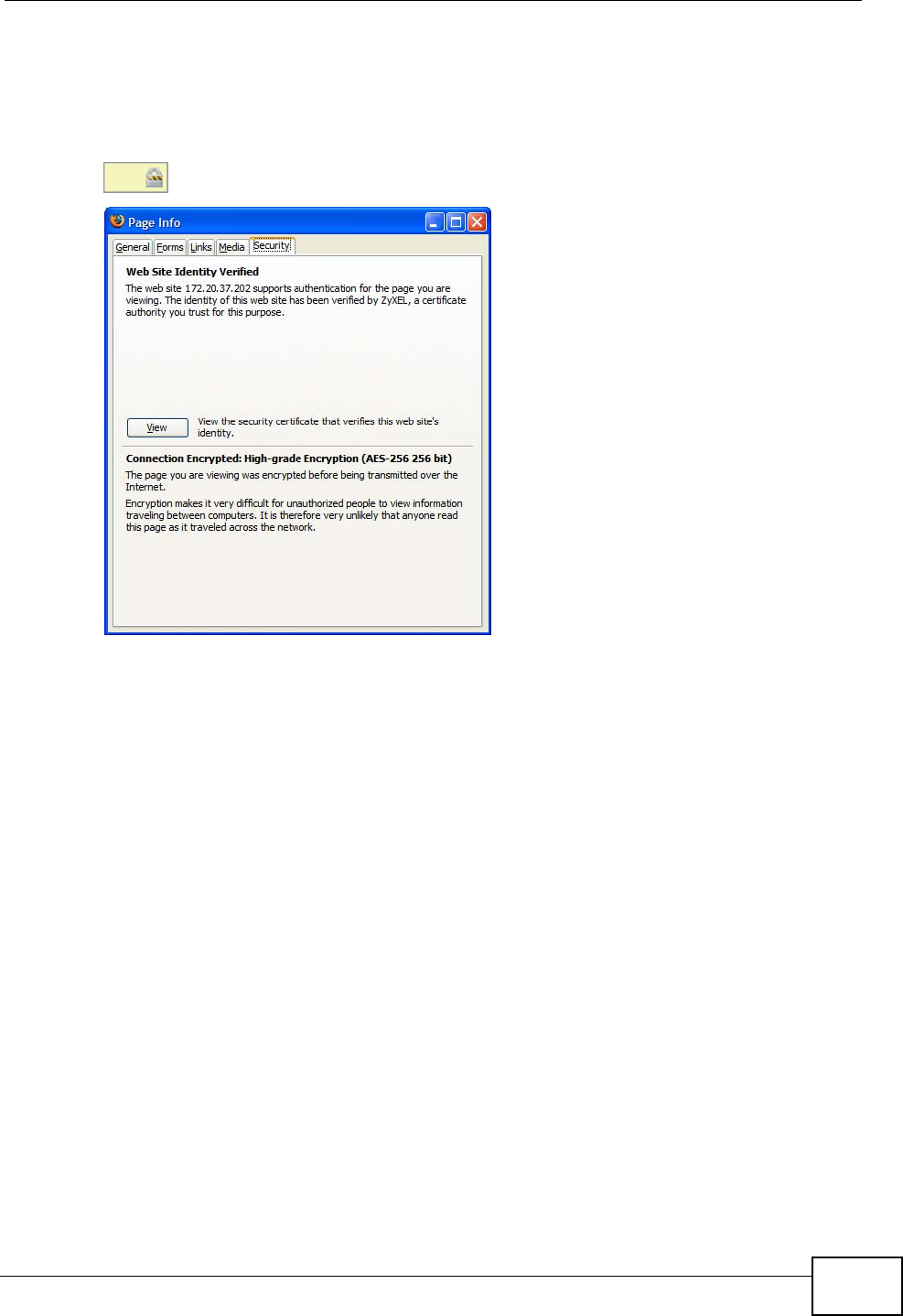
Appendix E Importing Certificates
MAX-207HW2R User’s Guide 249
3The certificate is stored and you can now connect securely to the web configurator.
A sealed padlock appears in the address bar, which you can click to open the Page
Info > Security window to view the web page’s security information.
Figure 148 Firefox 2: Page Info
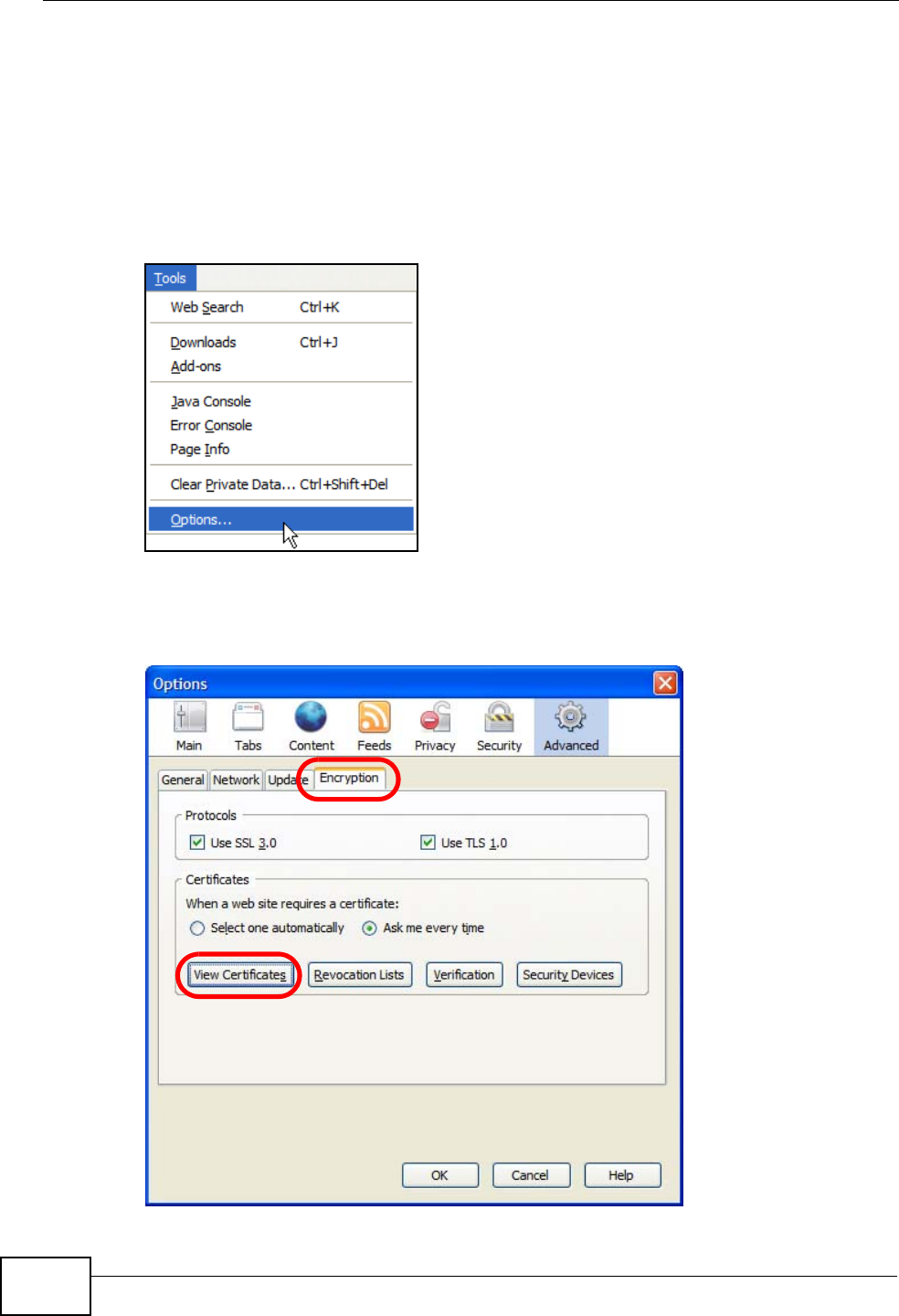
Appendix E Importing Certificates
MAX-207HW2R User’s Guide
250
Installing a Stand-Alone Certificate File in Firefox
Rather than browsing to a ZyXEL web configurator and installing a public key
certificate when prompted, you can install a stand-alone certificate file if one has
been issued to you.
1Open Firefox and click TOOLS > Options.
Figure 149 Firefox 2: Tools Menu
2In the Options dialog box, click ADVANCED > Encryption > View Certificates.
Figure 150 Firefox 2: Options
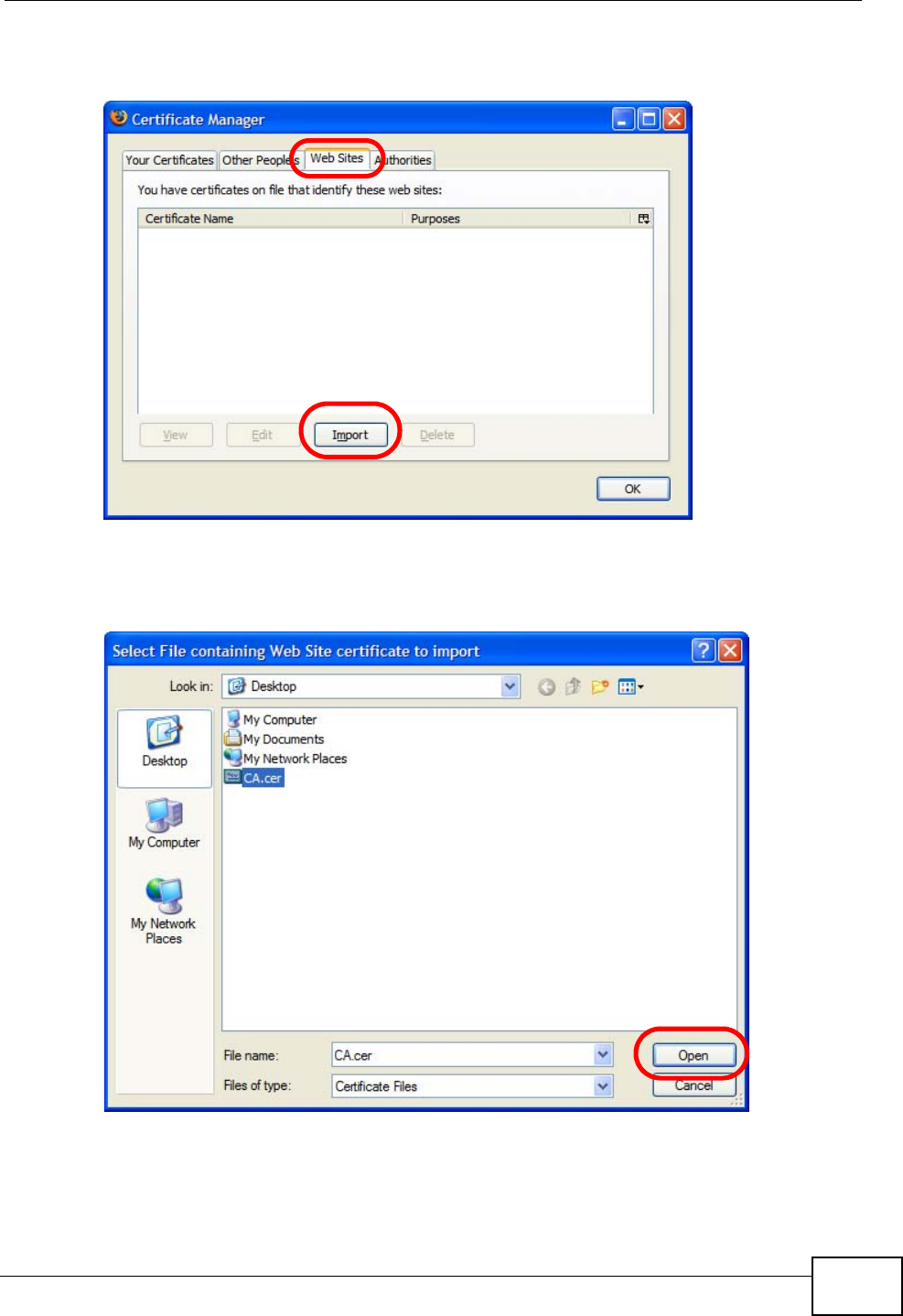
Appendix E Importing Certificates
MAX-207HW2R User’s Guide 251
3In the Certificate Manager dialog box, click Web Sites > Import.
Figure 151 Firefox 2: Certificate Manager
4Use the Select File dialog box to locate the certificate and then click Open.
Figure 152 Firefox 2: Select File
5The next time you visit the web site, click the padlock in the address bar to open
the Page Info > Security window to see the web page’s security information.
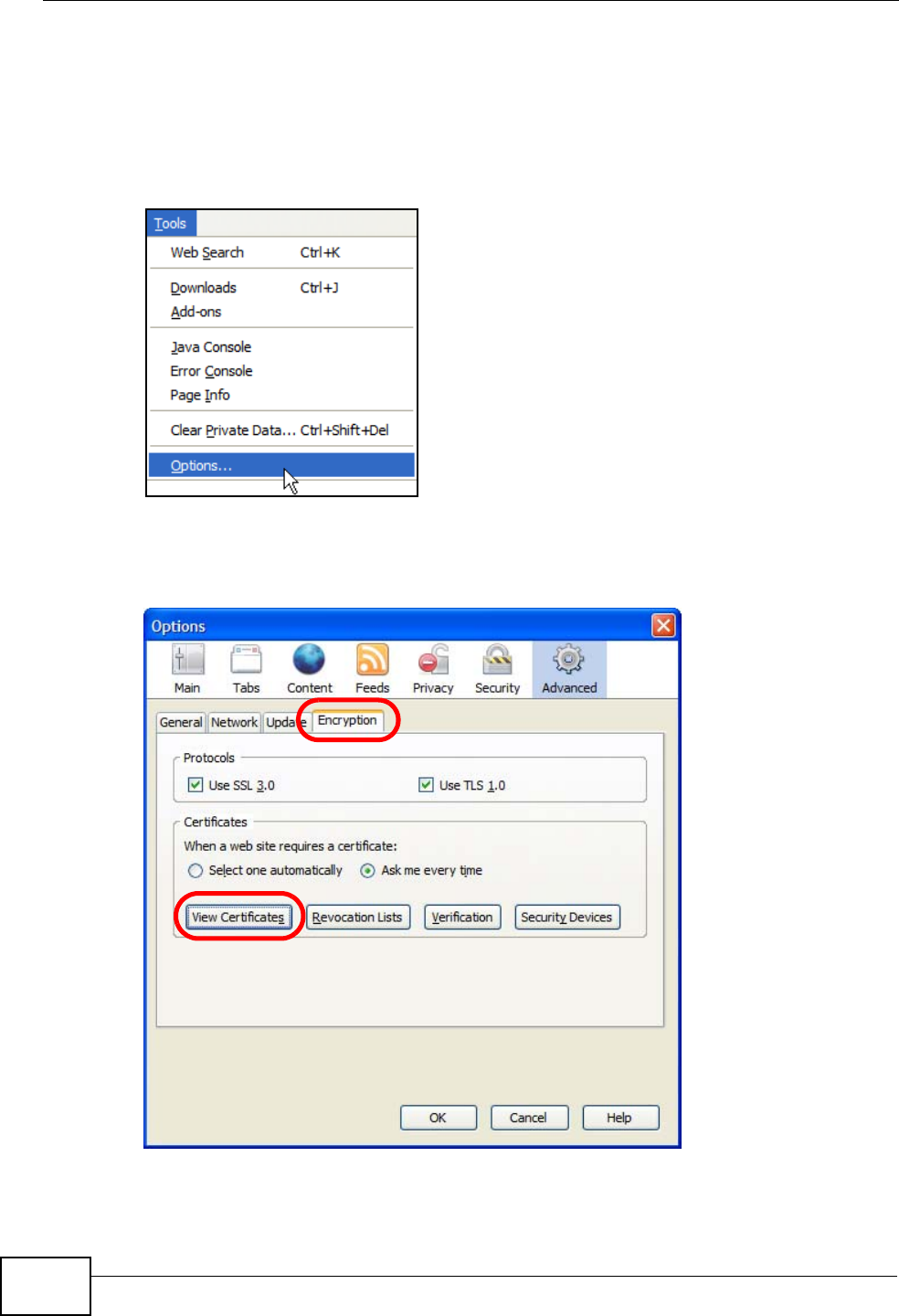
Appendix E Importing Certificates
MAX-207HW2R User’s Guide
252
Removing a Certificate in Firefox
This section shows you how to remove a public key certificate in Firefox 2.
1Open Firefox and click TOOLS > Options.
Figure 153 Firefox 2: Tools Menu
2In the Options dialog box, click ADVANCED > Encryption > View Certificates.
Figure 154 Firefox 2: Options
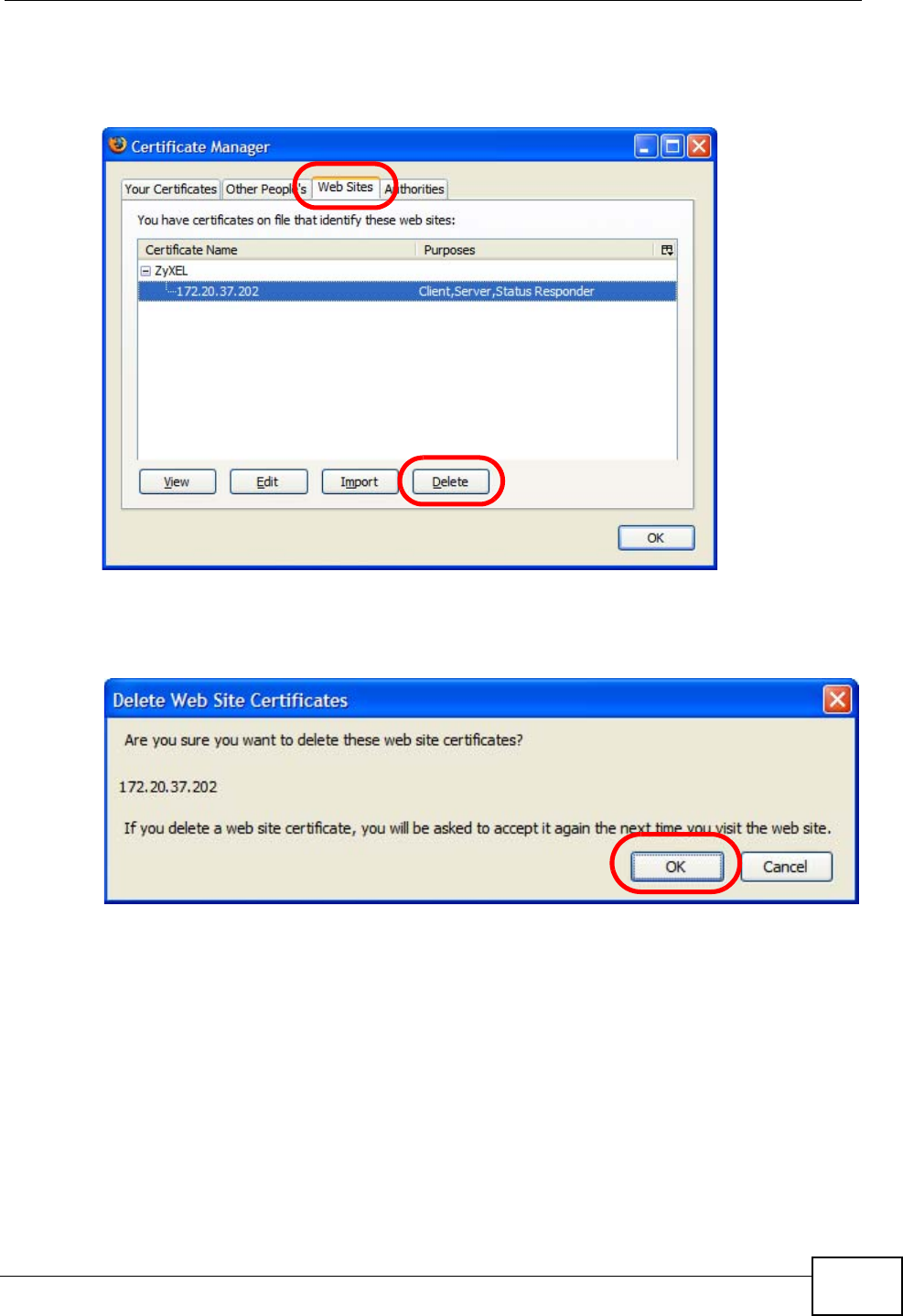
Appendix E Importing Certificates
MAX-207HW2R User’s Guide 253
3In the Certificate Manager dialog box, select the Web Sites tab, select the
certificate that you want to remove, and then click Delete.
Figure 155 Firefox 2: Certificate Manager
4In the Delete Web Site Certificates dialog box, click OK.
Figure 156 Firefox 2: Delete Web Site Certificates
5The next time you go to the web site that issued the public key certificate you just
removed, a certification error appears.
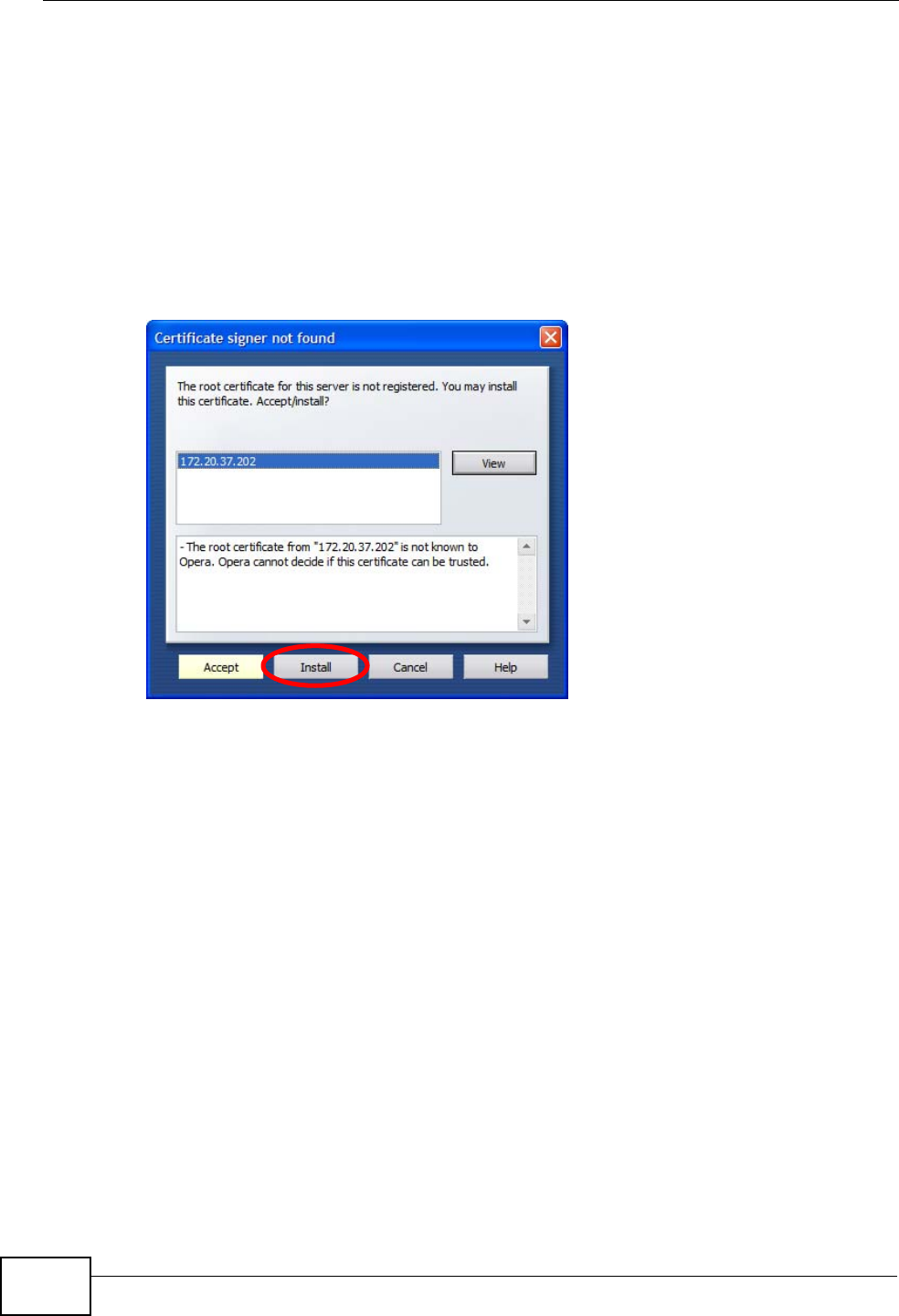
Appendix E Importing Certificates
MAX-207HW2R User’s Guide
254
Opera
The following example uses Opera 9 on Windows XP Professional; however, the
screens can apply to Opera 9 on all platforms.
1If your device’s web configurator is set to use SSL certification, then the first time
you browse to it you are presented with a certification error.
2Click Install to accept the certificate.
Figure 157 Opera 9: Certificate signer not found
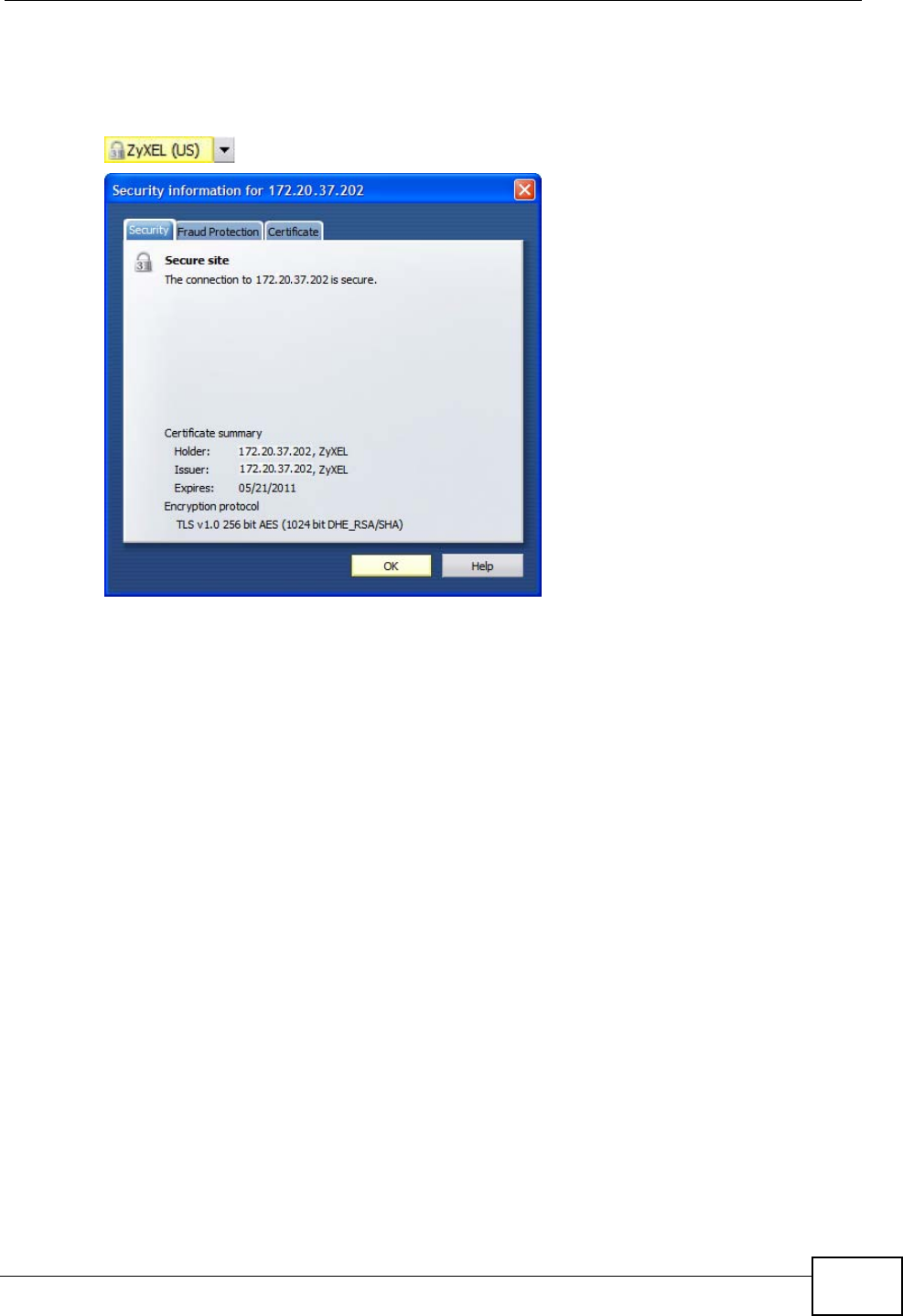
Appendix E Importing Certificates
MAX-207HW2R User’s Guide 255
3The next time you visit the web site, click the padlock in the address bar to open
the Security information window to view the web page’s security details.
Figure 158 Opera 9: Security information
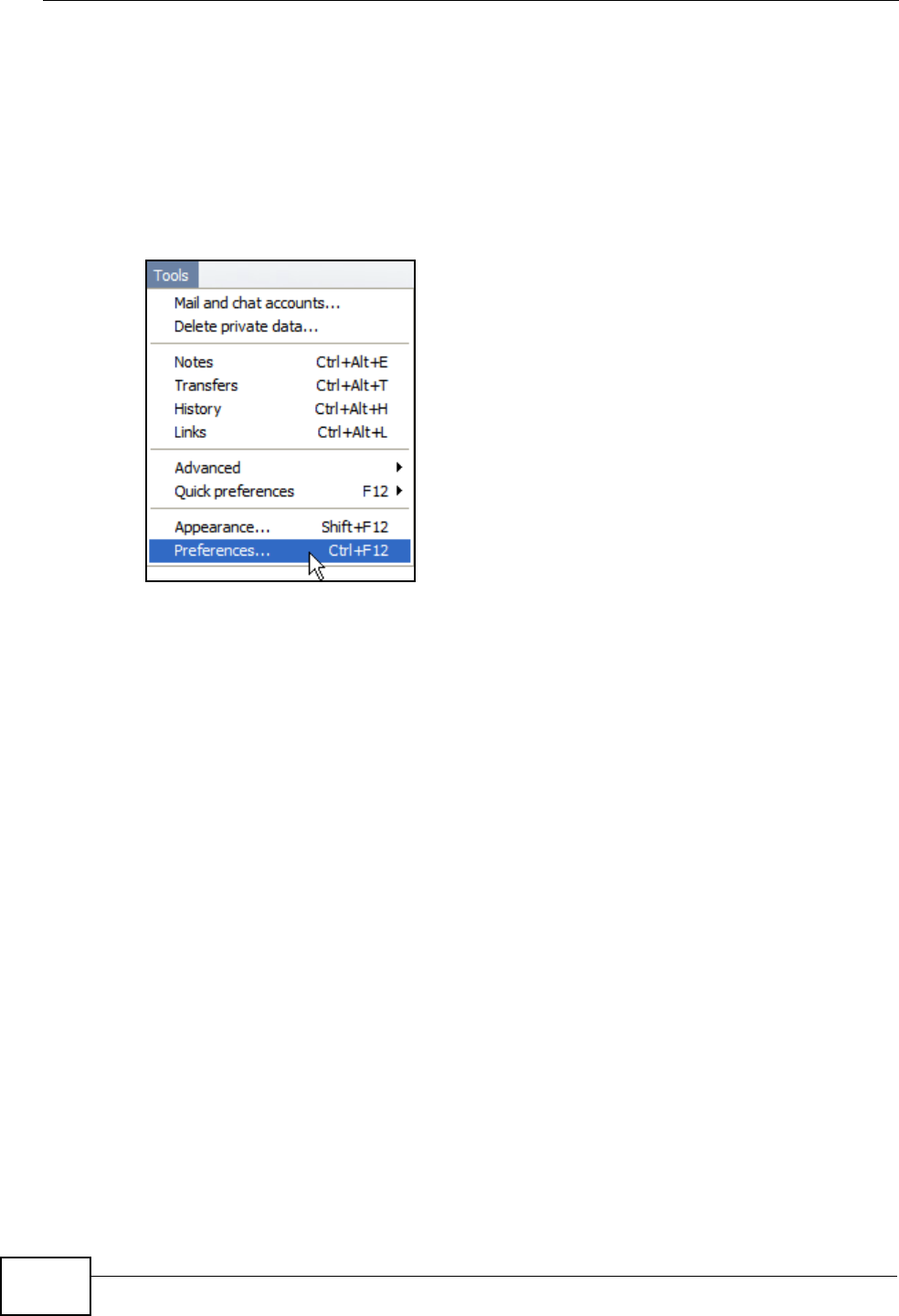
Appendix E Importing Certificates
MAX-207HW2R User’s Guide
256
Installing a Stand-Alone Certificate File in Opera
Rather than browsing to a ZyXEL web configurator and installing a public key
certificate when prompted, you can install a stand-alone certificate file if one has
been issued to you.
1Open Opera and click TOOLS > Preferences.
Figure 159 Opera 9: Tools Menu
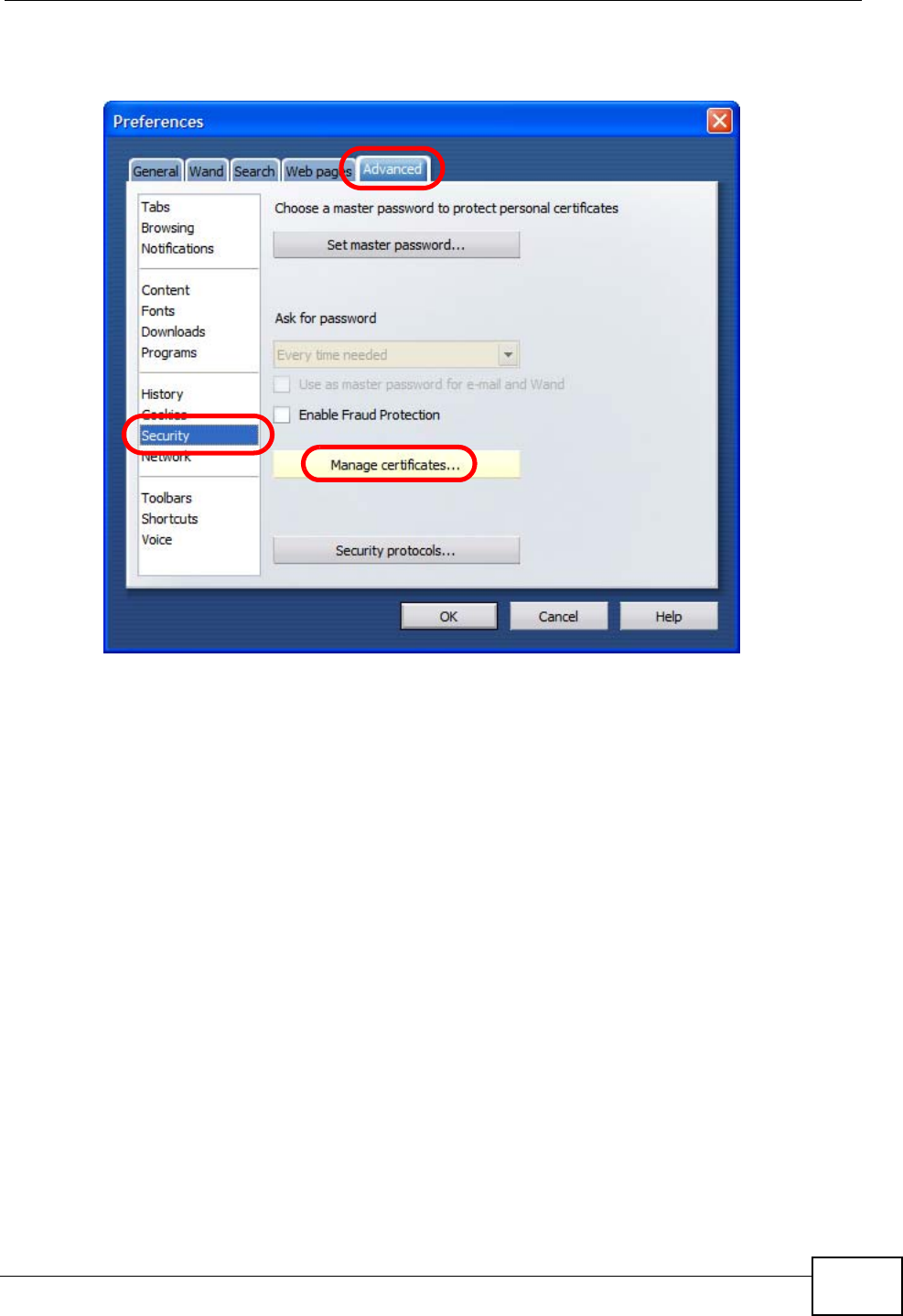
Appendix E Importing Certificates
MAX-207HW2R User’s Guide 257
2In Preferences, click ADVANCED > Security > Manage certificates.
Figure 160 Opera 9: Preferences
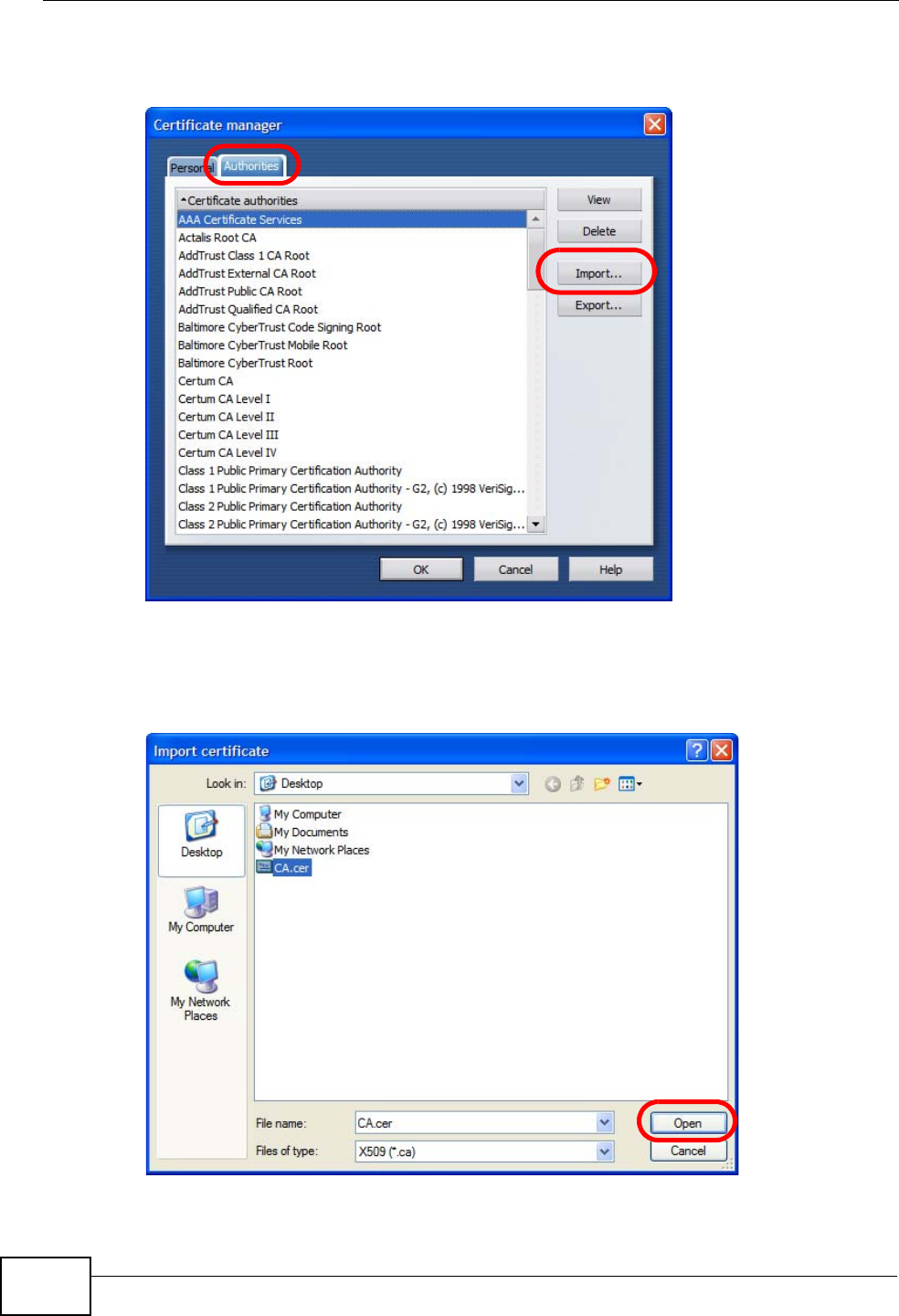
Appendix E Importing Certificates
MAX-207HW2R User’s Guide
258
3In the Certificates Manager, click Authorities > Import.
Figure 161 Opera 9: Certificate manager
4Use the Import certificate dialog box to locate the certificate and then click
Open.
Figure 162 Opera 9: Import certificate
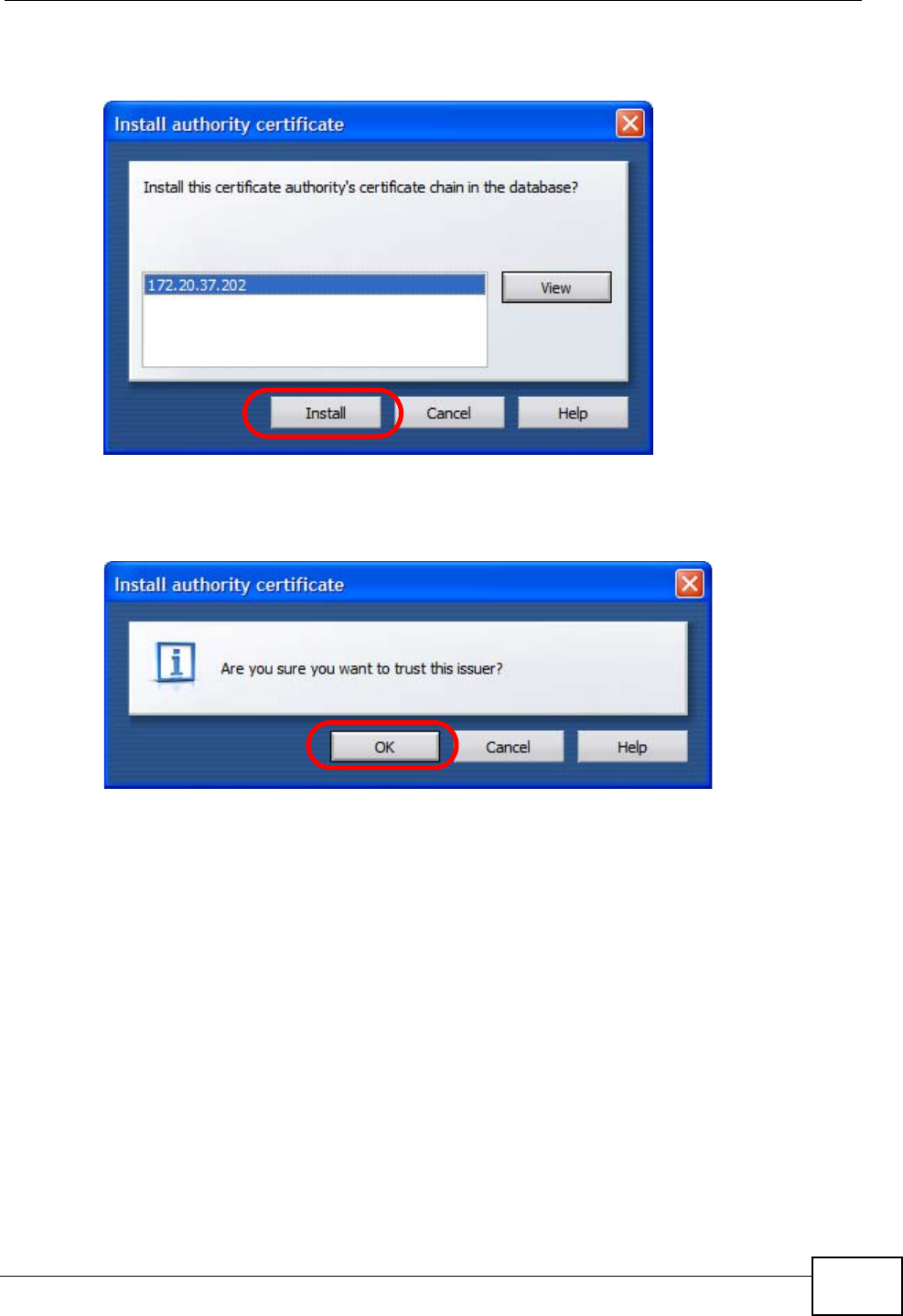
Appendix E Importing Certificates
MAX-207HW2R User’s Guide 259
5In the Install authority certificate dialog box, click Install.
Figure 163 Opera 9: Install authority certificate
6Next, click OK.
Figure 164 Opera 9: Install authority certificate
7The next time you visit the web site, click the padlock in the address bar to open
the Security information window to view the web page’s security details.
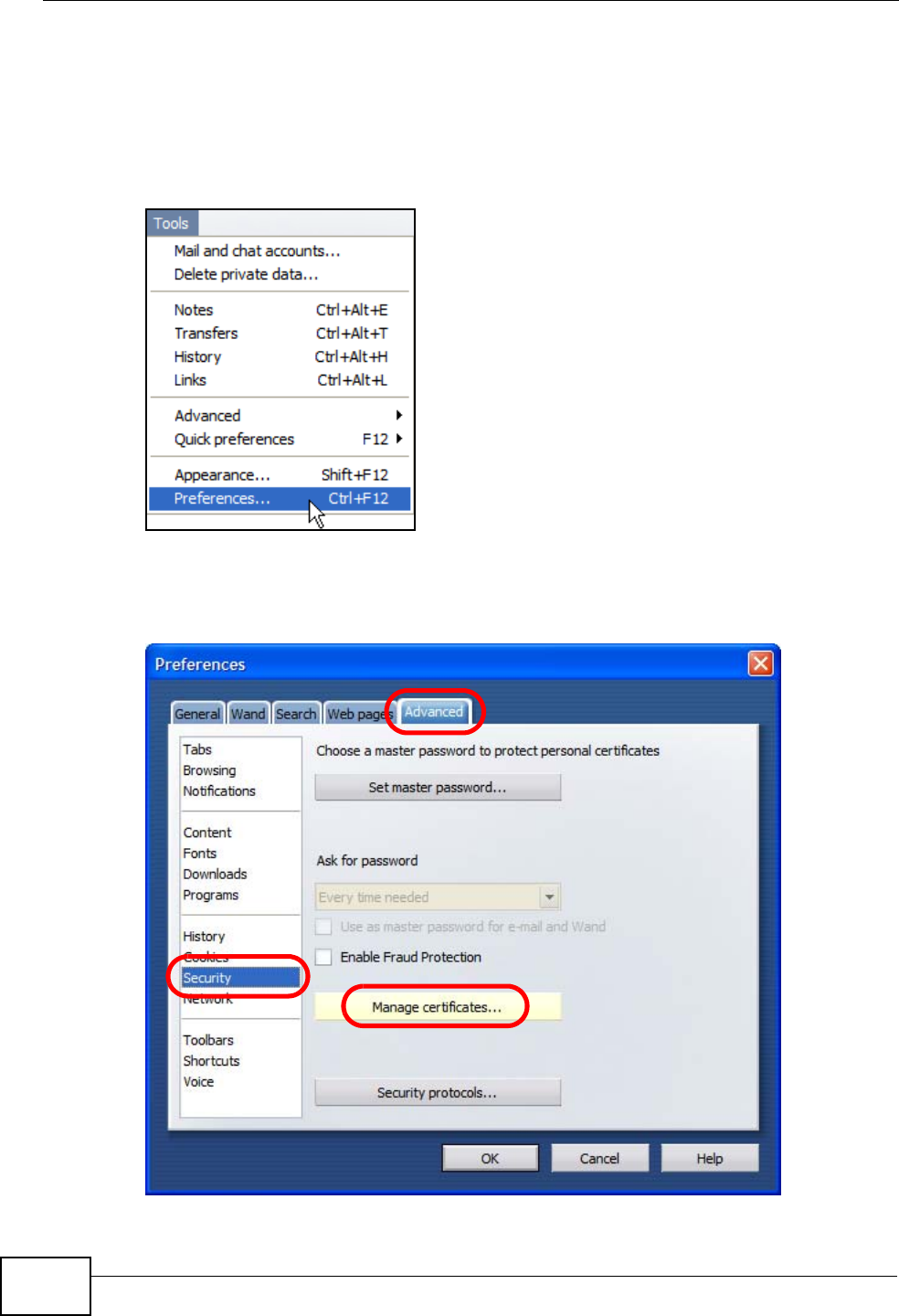
Appendix E Importing Certificates
MAX-207HW2R User’s Guide
260
Removing a Certificate in Opera
This section shows you how to remove a public key certificate in Opera 9.
1Open Opera and click TOOLS > Preferences.
Figure 165 Opera 9: Tools Menu
2In Preferences, ADVANCED > Security > Manage certificates.
Figure 166 Opera 9: Preferences
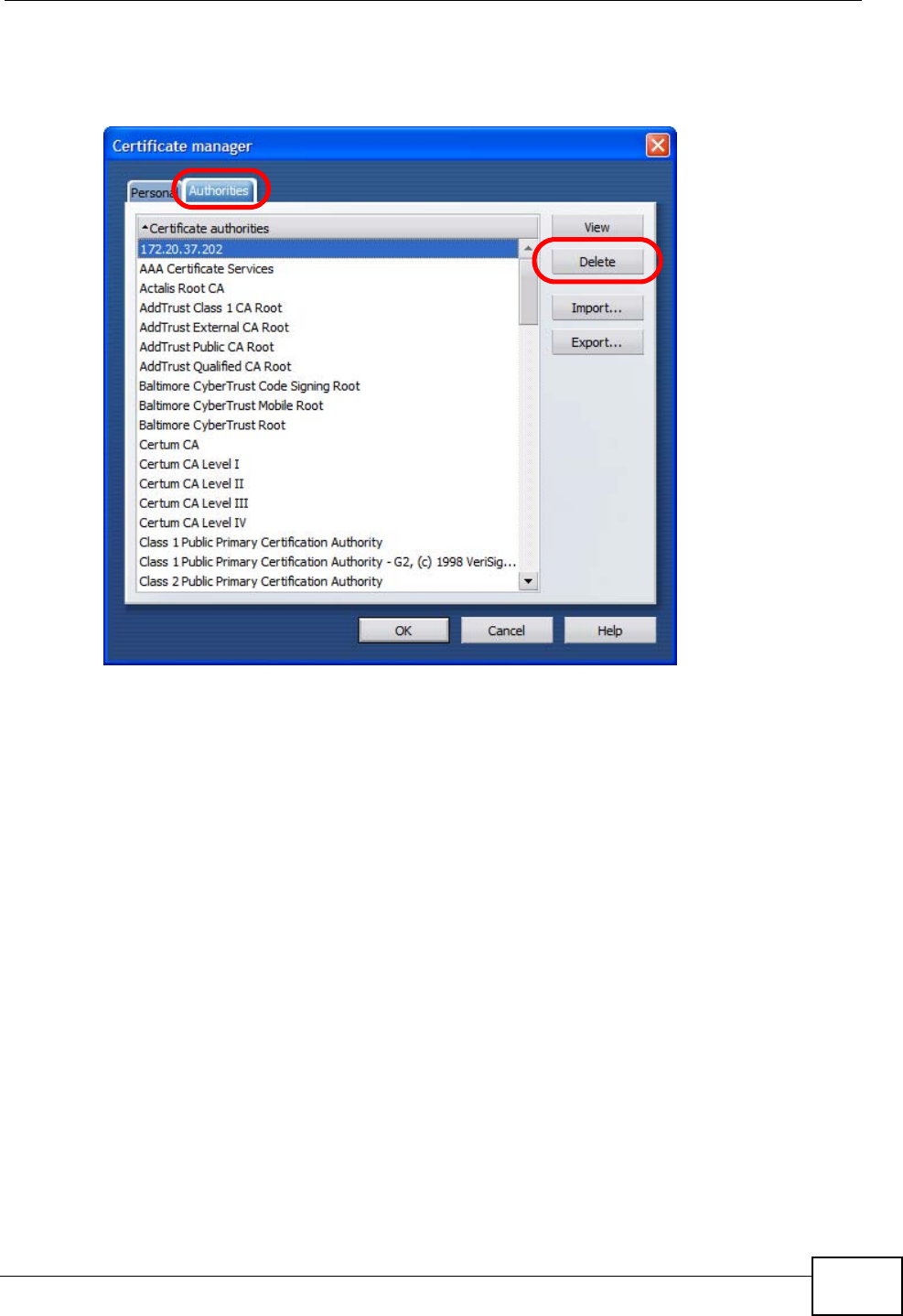
Appendix E Importing Certificates
MAX-207HW2R User’s Guide 261
3In the Certificates manager, select the Authorities tab, select the certificate
that you want to remove, and then click Delete.
Figure 167 Opera 9: Certificate manager
4The next time you go to the web site that issued the public key certificate you just
removed, a certification error appears.
Note: There is no confirmation when you delete a certificate authority, so be
absolutely certain that you want to go through with it before clicking the button.
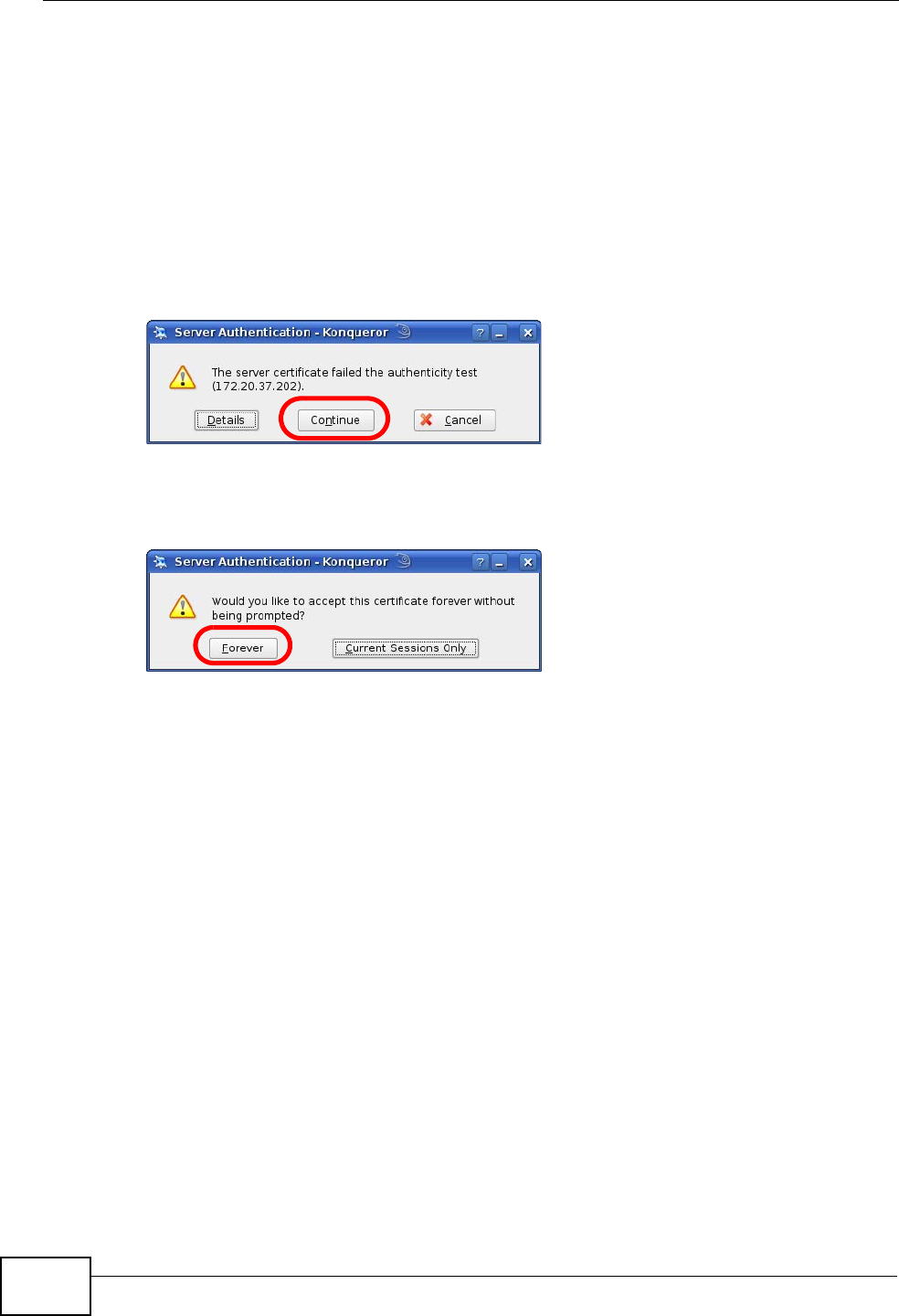
Appendix E Importing Certificates
MAX-207HW2R User’s Guide
262
Konqueror
The following example uses Konqueror 3.5 on openSUSE 10.3, however the
screens apply to Konqueror 3.5 on all Linux KDE distributions.
1If your device’s web configurator is set to use SSL certification, then the first time
you browse to it you are presented with a certification error.
2Click Continue.
Figure 168 Konqueror 3.5: Server Authentication
3Click Forever when prompted to accept the certificate.
Figure 169 Konqueror 3.5: Server Authentication
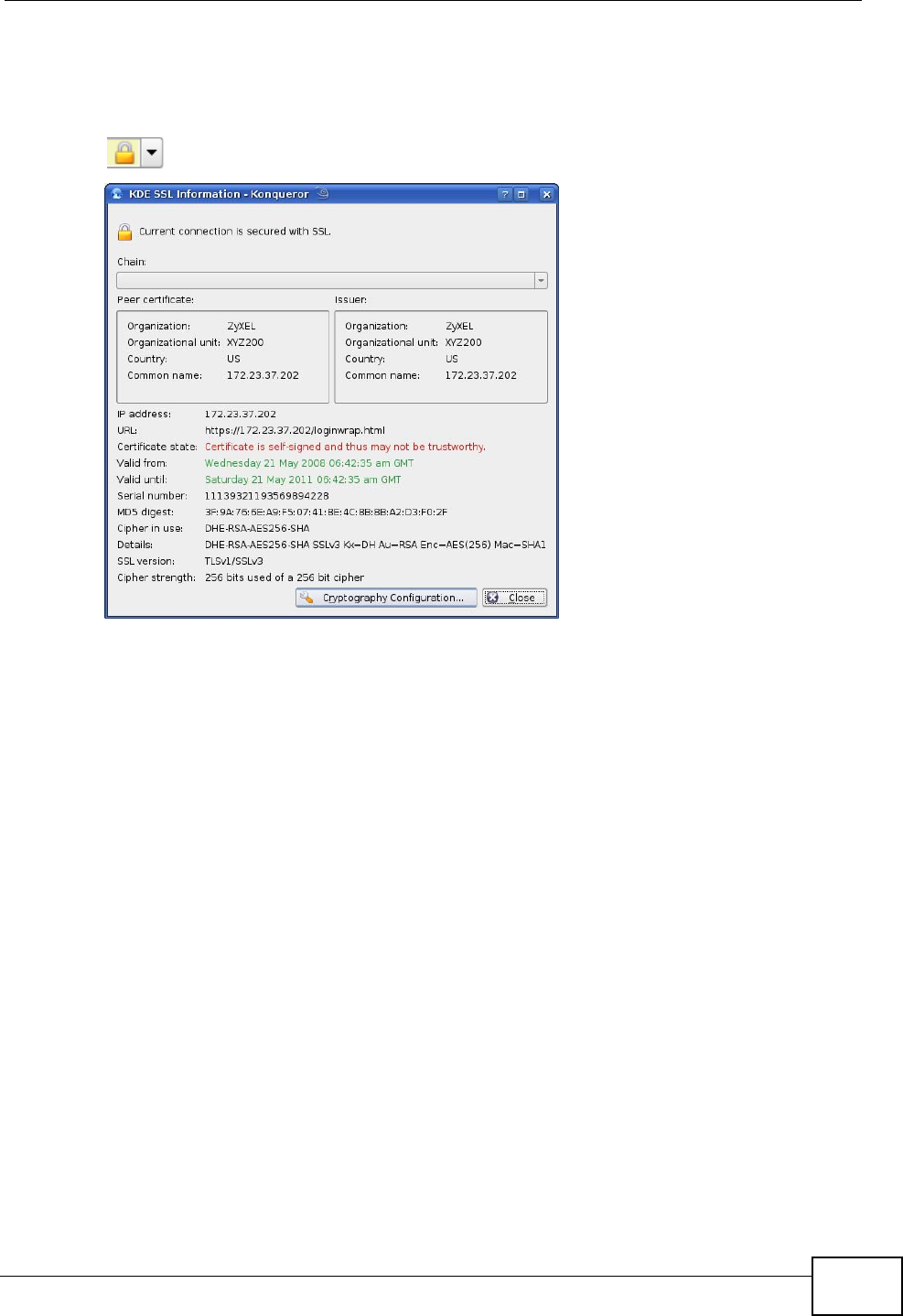
Appendix E Importing Certificates
MAX-207HW2R User’s Guide 263
4Click the padlock in the address bar to open the KDE SSL Information window
and view the web page’s security details.
Figure 170 Konqueror 3.5: KDE SSL Information
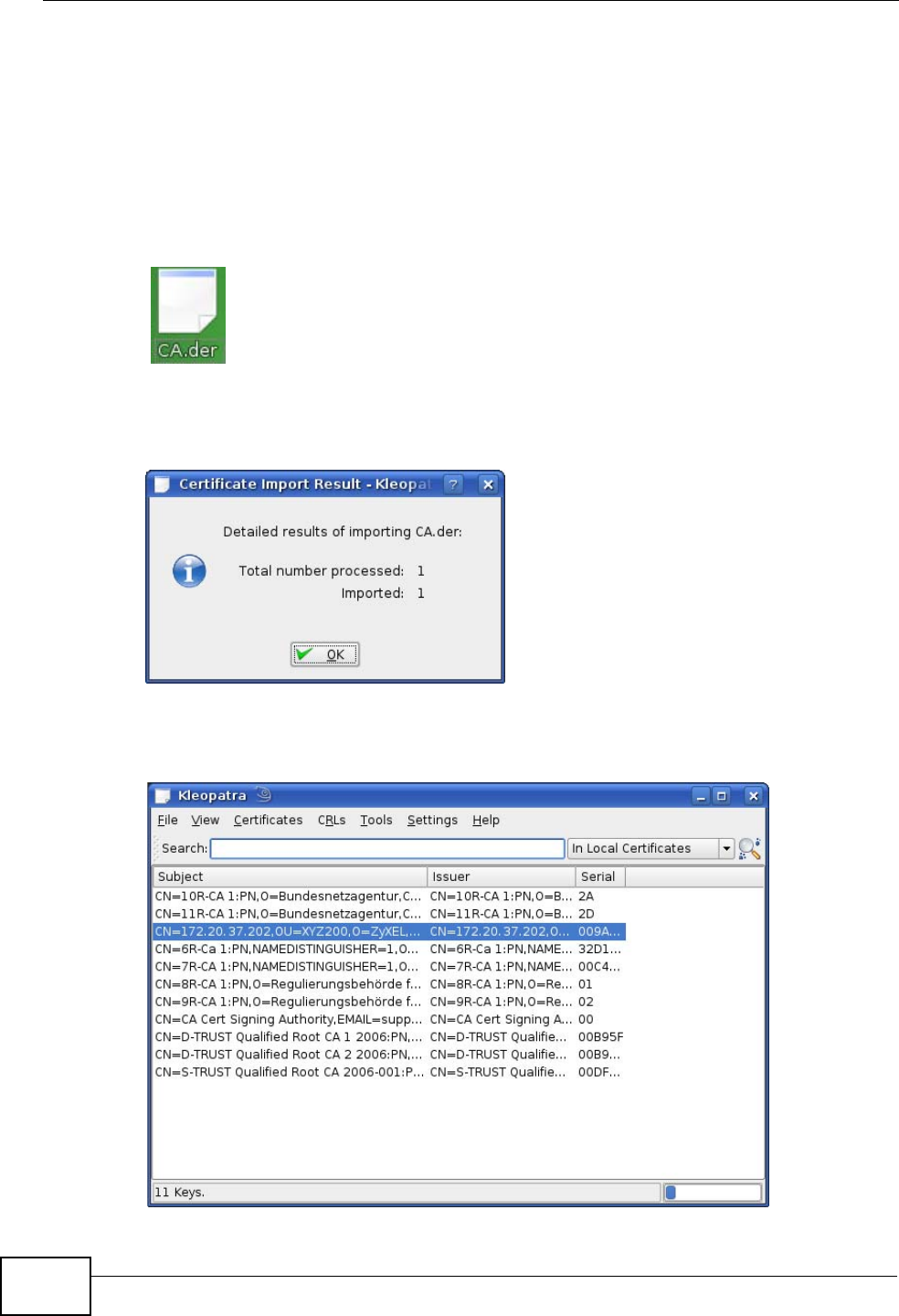
Appendix E Importing Certificates
MAX-207HW2R User’s Guide
264
Installing a Stand-Alone Certificate File in Konqueror
Rather than browsing to a ZyXEL web configurator and installing a public key
certificate when prompted, you can install a stand-alone certificate file if one has
been issued to you.
1Double-click the public key certificate file.
Figure 171 Konqueror 3.5: Public Key Certificate File
2In the Certificate Import Result - Kleopatra dialog box, click OK.
Figure 172 Konqueror 3.5: Certificate Import Result
The public key certificate appears in the KDE certificate manager, Kleopatra.
Figure 173 Konqueror 3.5: Kleopatra

Appendix E Importing Certificates
MAX-207HW2R User’s Guide 265
3The next time you visit the web site, click the padlock in the address bar to open
the KDE SSL Information window to view the web page’s security details.
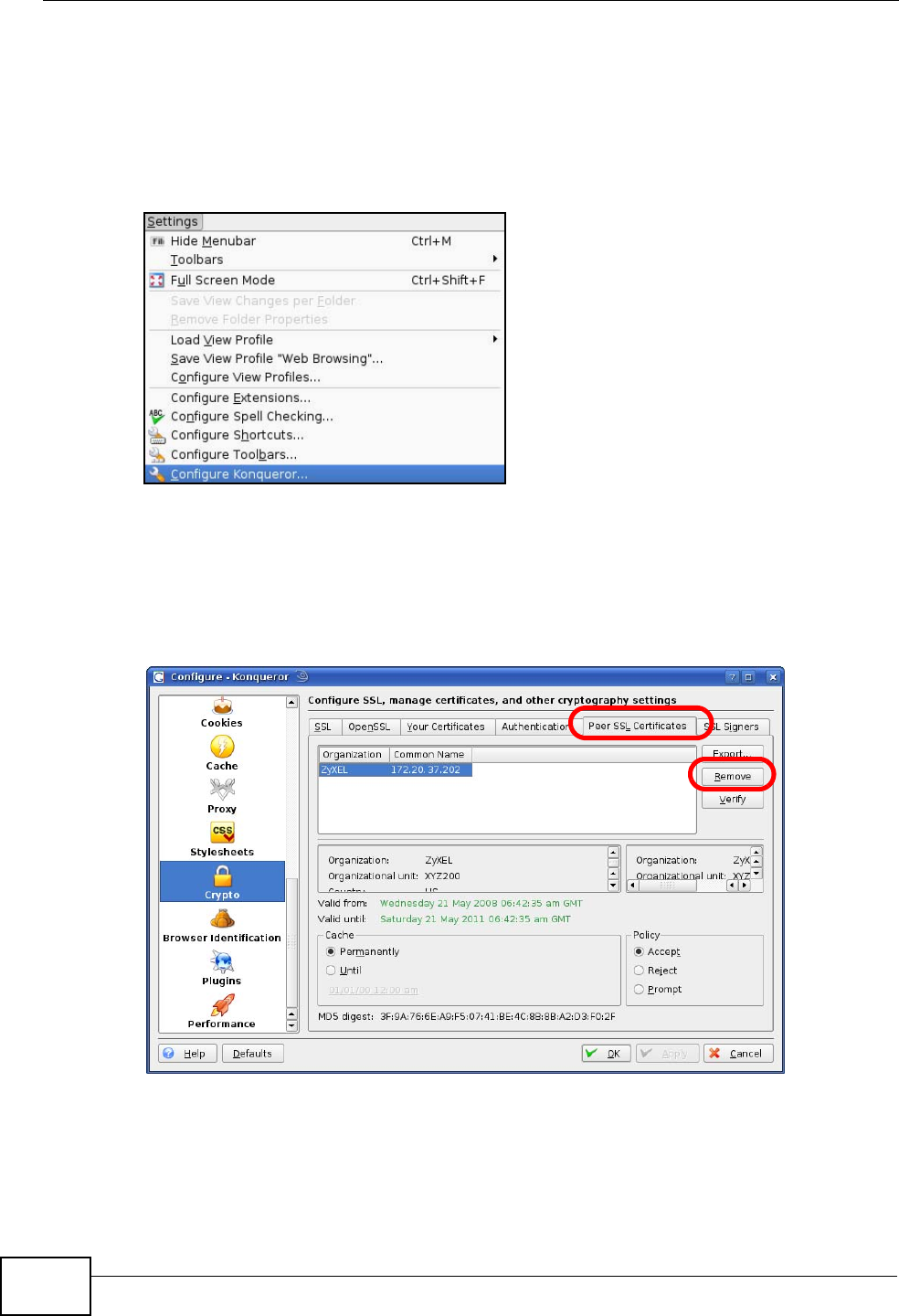
Appendix E Importing Certificates
MAX-207HW2R User’s Guide
266
Removing a Certificate in Konqueror
This section shows you how to remove a public key certificate in Konqueror 3.5.
1Open Konqueror and click Settings > Configure Konqueror.
Figure 174 Konqueror 3.5: Settings Menu
2In the Configure dialog box, select Crypto.
3On the Peer SSL Certificates tab, select the certificate you want to delete and
then click Remove.
Figure 175 Konqueror 3.5: Configure
4The next time you go to the web site that issued the public key certificate you just
removed, a certification error appears.

Appendix E Importing Certificates
MAX-207HW2R User’s Guide 267
Note: There is no confirmation when you remove a certificate authority, so be
absolutely certain you want to go through with it before clicking the button.

Appendix E Importing Certificates
MAX-207HW2R User’s Guide
268

MAX-207HW2R User’s Guide 269
APPENDIX F
SIP Passthrough
Enabling/Disabling the SIP ALG
You can turn off the MAX-207HW2R SIP ALG to avoid retranslating the IP address
of an existing SIP device that is using STUN. If you want to use STUN with a SIP
client device (a SIP phone or IP phone for example) behind the MAX-207HW2R,
use the ip alg disable ALG_SIP command to turn off the SIP ALG.
Signaling Session Timeout
Most SIP clients have an “expire” mechanism indicating the lifetime of signaling
sessions. The SIP UA sends registration packets to the SIP server periodically and
keeps the session alive in the MAX-207HW2R.
If the SIP client does not have this mechanism and makes no call during the MAX-
207HW2R SIP timeout default (60 minutes), the MAX-207HW2R SIP ALG drops
any incoming calls after the timeout period. You can use the ip alg siptimeout
command to change the timeout value.
Audio Session Timeout
If no voice packets go through the SIP ALG before the timeout period default (5
minutes) expires, the SIP ALG does not drop the call but blocks all voice traffic and
deletes the audio session. You cannot hear anything and you will need to make a
new call to continue your conversation.

Appendix F SIP Passthrough
MAX-207HW2R User’s Guide
270
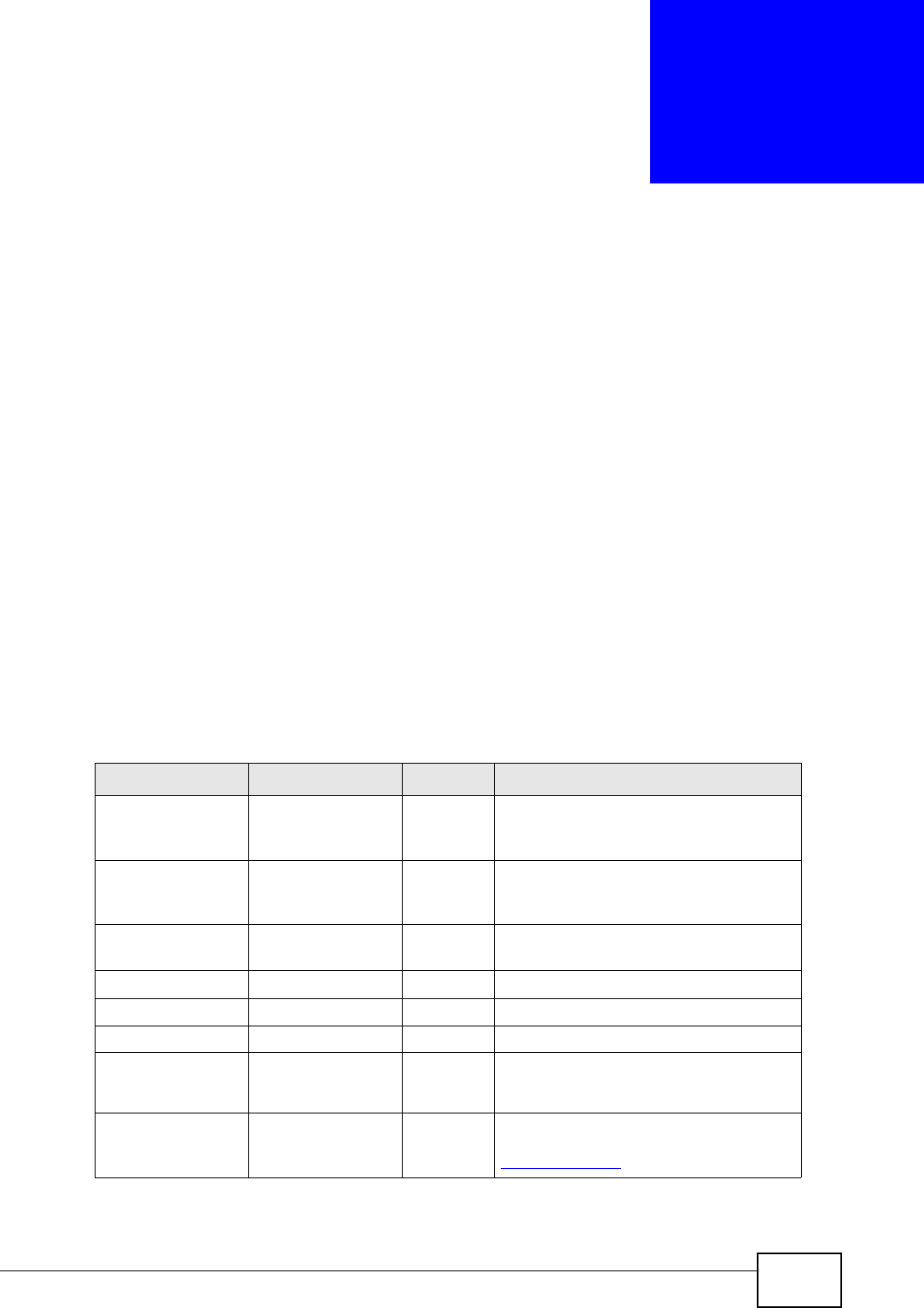
MAX-207HW2R User’s Guide 271
APPENDIX G
Common Services
The following table lists some commonly-used services and their associated
protocols and port numbers. For a comprehensive list of port numbers, ICMP type/
code numbers and services, visit the IANA (Internet Assigned Number Authority)
web site.
•Name: This is a short, descriptive name for the service. You can use this one or
create a different one, if you like.
•Protocol: This is the type of IP protocol used by the service. If this is TCP/
UDP, then the service uses the same port number with TCP and UDP. If this is
USER-DEFINED, the Port(s) is the IP protocol number, not the port number.
•Port(s): This value depends on the Protocol. Please refer to RFC 1700 for
further information about port numbers.
•If the Protocol is TCP, UDP, or TCP/UDP, this is the IP port number.
•If the Protocol is USER, this is the IP protocol number.
•Description: This is a brief explanation of the applications that use this service
or the situations in which this service is used.
Table 83 Commonly Used Services
NAME PROTOCOL PORT(S) DESCRIPTION
AH
(IPSEC_TUNNEL) User-Defined 51 The IPSEC AH (Authentication
Header) tunneling protocol uses this
service.
AIM/New-ICQ TCP 5190 AOL’s Internet Messenger service. It
is also used as a listening port by
ICQ.
AUTH TCP 113 Authentication protocol used by some
servers.
BGP TCP 179 Border Gateway Protocol.
BOOTP_CLIENT UDP 68 DHCP Client.
BOOTP_SERVER UDP 67 DHCP Server.
CU-SEEME TCP
UDP
7648
24032
A popular videoconferencing solution
from White Pines Software.
DNS TCP/UDP 53 Domain Name Server, a service that
matches web names (for example
www.zyxel.com) to IP numbers.

Appendix G Common Services
MAX-207HW2R User’s Guide
272
ESP
(IPSEC_TUNNEL) User-Defined 50 The IPSEC ESP (Encapsulation
Security Protocol) tunneling protocol
uses this service.
FINGER TCP 79 Finger is a UNIX or Internet related
command that can be used to find out
if a user is logged on.
FTP TCP
TCP
20
21
File Transfer Program, a program to
enable fast transfer of files, including
large files that may not be possible by
e-mail.
H.323 TCP 1720 NetMeeting uses this protocol.
HTTP TCP 80 Hyper Text Transfer Protocol - a
client/server protocol for the world
wide web.
HTTPS TCP 443 HTTPS is a secured http session often
used in e-commerce.
ICMP User-Defined 1Internet Control Message Protocol is
often used for diagnostic or routing
purposes.
ICQ UDP 4000 This is a popular Internet chat
program.
IGMP
(MULTICAST) User-Defined 2Internet Group Management Protocol
is used when sending packets to a
specific group of hosts.
IKE UDP 500 The Internet Key Exchange algorithm
is used for key distribution and
management.
IRC TCP/UDP 6667 This is another popular Internet chat
program.
MSN Messenger TCP 1863 Microsoft Networks’ messenger
service uses this protocol.
NEW-ICQ TCP 5190 An Internet chat program.
NEWS TCP 144 A protocol for news groups.
NFS UDP 2049 Network File System - NFS is a client/
server distributed file service that
provides transparent file sharing for
network environments.
NNTP TCP 119 Network News Transport Protocol is
the delivery mechanism for the
USENET newsgroup service.
PING User-Defined 1Packet INternet Groper is a protocol
that sends out ICMP echo requests to
test whether or not a remote host is
reachable.
POP3 TCP 110 Post Office Protocol version 3 lets a
client computer get e-mail from a
POP3 server through a temporary
connection (TCP/IP or other).
Table 83 Commonly Used Services (continued)
NAME PROTOCOL PORT(S) DESCRIPTION

Appendix G Common Services
MAX-207HW2R User’s Guide 273
PPTP TCP 1723 Point-to-Point Tunneling Protocol
enables secure transfer of data over
public networks. This is the control
channel.
PPTP_TUNNEL
(GRE) User-Defined 47 PPTP (Point-to-Point Tunneling
Protocol) enables secure transfer of
data over public networks. This is the
data channel.
RCMD TCP 512 Remote Command Service.
REAL_AUDIO TCP 7070 A streaming audio service that
enables real time sound over the web.
REXEC TCP 514 Remote Execution Daemon.
RLOGIN TCP 513 Remote Login.
RTELNET TCP 107 Remote Telnet.
RTSP TCP/UDP 554 The Real Time Streaming (media
control) Protocol (RTSP) is a remote
control for multimedia on the
Internet.
SFTP TCP 115 Simple File Transfer Protocol.
SMTP TCP 25 Simple Mail Transfer Protocol is the
message-exchange standard for the
Internet. SMTP enables you to move
messages from one e-mail server to
another.
SNMP TCP/UDP 161 Simple Network Management
Program.
SNMP-TRAPS TCP/UDP 162 Traps for use with the SNMP
(RFC:1215).
SQL-NET TCP 1521 Structured Query Language is an
interface to access data on many
different types of database systems,
including mainframes, midrange
systems, UNIX systems and network
servers.
SSH TCP/UDP 22 Secure Shell Remote Login Program.
STRM WORKS UDP 1558 Stream Works Protocol.
SYSLOG UDP 514 Syslog allows you to send system logs
to a UNIX server.
TACACS UDP 49 Login Host Protocol used for (Terminal
Access Controller Access Control
System).
TELNET TCP 23 Telnet is the login and terminal
emulation protocol common on the
Internet and in UNIX environments. It
operates over TCP/IP networks. Its
primary function is to allow users to
log into remote host systems.
Table 83 Commonly Used Services (continued)
NAME PROTOCOL PORT(S) DESCRIPTION
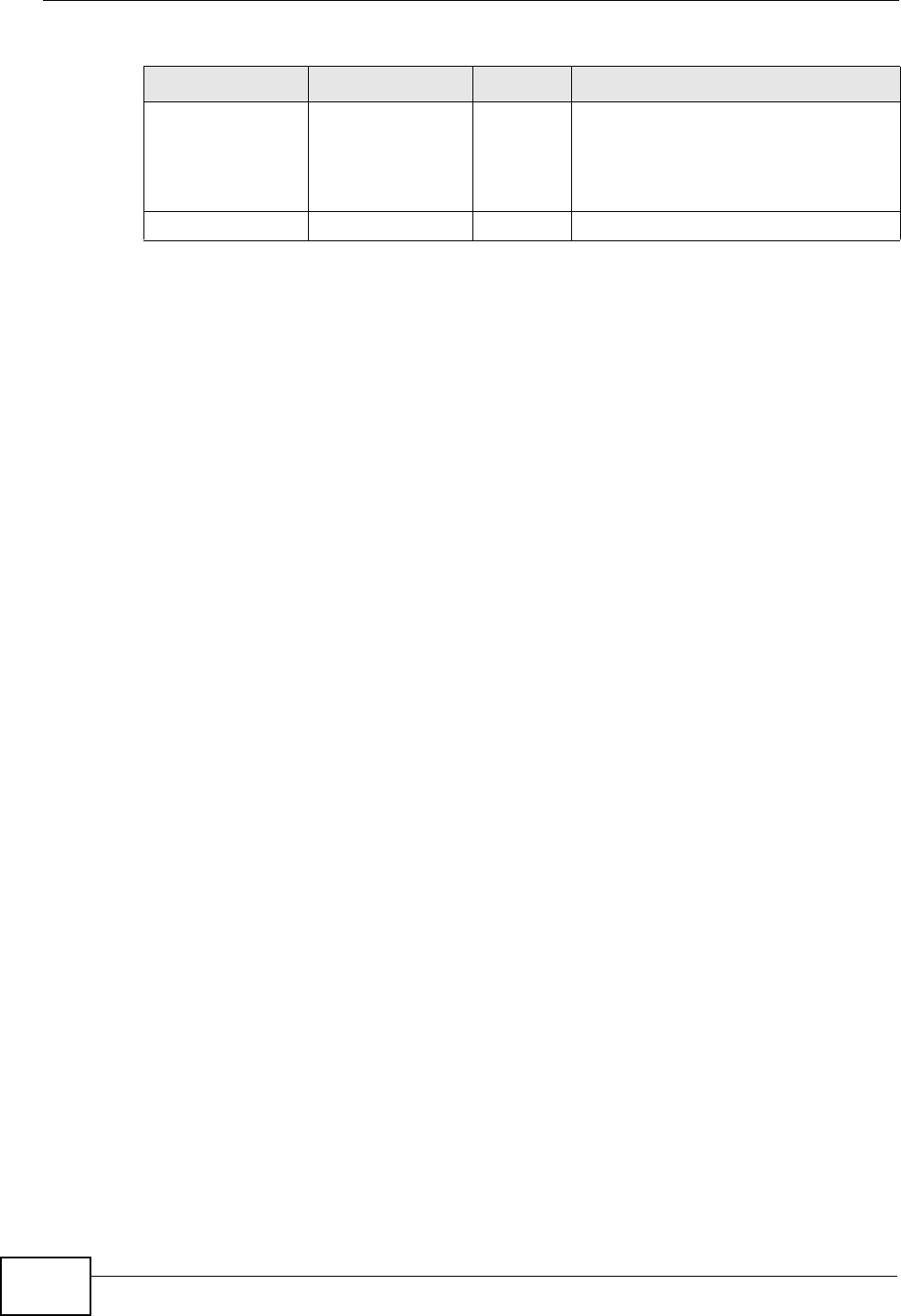
Appendix G Common Services
MAX-207HW2R User’s Guide
274
TFTP UDP 69 Trivial File Transfer Protocol is an
Internet file transfer protocol similar
to FTP, but uses the UDP (User
Datagram Protocol) rather than TCP
(Transmission Control Protocol).
VDOLIVE TCP 7000 Another videoconferencing solution.
Table 83 Commonly Used Services (continued)
NAME PROTOCOL PORT(S) DESCRIPTION

MAX-207HW2R User’s Guide 275
APPENDIX H
Legal Information
Copyright
Copyright © 2010 by ZyXEL Communications Corporation.
The contents of this publication may not be reproduced in any part or as a whole,
transcribed, stored in a retrieval system, translated into any language, or
transmitted in any form or by any means, electronic, mechanical, magnetic,
optical, chemical, photocopying, manual, or otherwise, without the prior written
permission of ZyXEL Communications Corporation.
Published by ZyXEL Communications Corporation. All rights reserved.
Disclaimers
ZyXEL does not assume any liability arising out of the application or use of any
products, or software described herein. Neither does it convey any license under
its patent rights nor the patent rights of others. ZyXEL further reserves the right
to make changes in any products described herein without notice. This publication
is subject to change without notice.
Your use of the MAX-207HW2R is subject to the terms and conditions of any
related service providers.
Do not use the MAX-207HW2R for illegal purposes. Illegal downloading or sharing
of files can result in severe civil and criminal penalties. You are subject to the
restrictions of copyright laws and any other applicable laws, and will bear the
consequences of any infringements thereof. ZyXEL bears NO responsibility or
liability for your use of the download service feature.
Trademarks
Trademarks mentioned in this publication are used for identification purposes only
and may be properties of their respective owners.

Appendix H Legal Information
MAX-207HW2R User’s Guide
276
Certifications
Federal Communications Commission (FCC) Interference Statement
The device complies with Part 15 of FCC rules. Operation is subject to the
following two conditions:
• This device may not cause harmful interference.
• This device must accept any interference received, including interference that
may cause undesired operations.
This device has been tested and found to comply with the limits for a Class B
digital device pursuant to Part 15 of the FCC Rules. These limits are designed to
provide reasonable protection against harmful interference in a residential
installation. This device generates, uses, and can radiate radio frequency energy,
and if not installed and used in accordance with the instructions, may cause
harmful interference to radio communications. However, there is no guarantee
that interference will not occur in a particular installation.
If this device does cause harmful interference to radio/television reception, which
can be determined by turning the device off and on, the user is encouraged to try
to correct the interference by one or more of the following measures:
1Reorient or relocate the receiving antenna.
2Increase the separation between the equipment and the receiver.
3Connect the equipment into an outlet on a circuit different from that to which the
receiver is connected.
4Consult the dealer or an experienced radio/TV technician for help.
FCC Radiation Exposure Statement
•This transmitter must not be co-located or operating in conjunction
with any other antenna or transmitter.
• To comply with FCC RF exposure compliance requirements, a separation
distance of at least 20 cm must be maintained between the antenna of this
device and all persons.
注意 !
依據 低功率電波輻射性電機管理辦法
第十二條 經型式認證合格之低功率射頻電機,非經許可,公司、商號或使用
者均不得擅自變更頻率、加大功率或變更原設計之特性及功能。

Appendix H Legal Information
MAX-207HW2R User’s Guide 277
第十四條 低功率射頻電機之使用不得影響飛航安全及干擾合法通信;經發現
有干擾現象時,應立即停用,並改善至無干擾時方得繼續使用。
前項合法通信,指依電信規定作業之無線電信。低功率射頻電機須忍
受合法通信或工業、科學及醫療用電波輻射性電機設備之干擾。
本機限在不干擾合法電臺與不受被干擾保障條件下於室內使用。
減少電磁波影響,請妥適使用。
Notices
Changes or modifications not expressly approved by the party responsible for
compliance could void the user's authority to operate the equipment.
This Class B digital apparatus complies with Canadian ICES-003.
Cet appareil numérique de la classe B est conforme à la norme NMB-003 du
Canada.
Viewing Certifications
1Go to http://www.zyxel.com.
2Select your product on the ZyXEL home page to go to that product's page.
3Select the certification you wish to view from this page.
ZyXEL Limited Warranty
ZyXEL warrants to the original end user (purchaser) that this product is free from
any defects in materials or workmanship for a period of up to two years from the
date of purchase. During the warranty period, and upon proof of purchase, should
the product have indications of failure due to faulty workmanship and/or
materials, ZyXEL will, at its discretion, repair or replace the defective products or
components without charge for either parts or labor, and to whatever extent it
shall deem necessary to restore the product or components to proper operating
condition. Any replacement will consist of a new or re-manufactured functionally
equivalent product of equal or higher value, and will be solely at the discretion of
ZyXEL. This warranty shall not apply if the product has been modified, misused,
tampered with, damaged by an act of God, or subjected to abnormal working
conditions.
Note
Repair or replacement, as provided under this warranty, is the exclusive remedy of
the purchaser. This warranty is in lieu of all other warranties, express or implied,

Appendix H Legal Information
MAX-207HW2R User’s Guide
278
including any implied warranty of merchantability or fitness for a particular use or
purpose. ZyXEL shall in no event be held liable for indirect or consequential
damages of any kind to the purchaser.
To obtain the services of this warranty, contact your vendor. You may also refer to
the warranty policy for the region in which you bought the device at http://
www.zyxel.com/web/support_warranty_info.php.
Registration
Register your product online to receive e-mail notices of firmware upgrades and
information at www.zyxel.com.

Index
MAX-207HW2R User’s Guide 279
Index
Numerics
802.11 mode 63
A
AAA 72–73
AbS 101
access point, See AP 55
accounting server
see AAA
ACK message 106
activity 72
Advanced Encryption Standard
see AES
AES 185
alternative subnet mask notation 228
analysis-by-synthesis 101
AP (Access Point) 55
authentication 72, 74, 183
inner 186
key
server 72
types 186
authentication type 57
open system 57
shared key 57
authorization 183
request and reply 185
server 72
B
base station
see BS
BS 71–72
links 72
BYE request 106
C
CA 127, 130
and certificates 131
call
Europe type service mode 117
hold 117–119
service mode 117–119
transfer 118–119
waiting 118–119
CBC-MAC 185
CCMP 183, 185
cell 71
Certificate Revocation List (CRL) 131
certificates 127, 183
advantages 131
and CA 131
certification path 130
expired 130
factory-default 131
file formats 131
importing 128
not used for encryption 130
revoked 130
thumbprint algorithms 133
thumbprints 133
used for authentication 130
verification 185
verifying fingerprints 132
certification
authority, see CA
notices 277
requests 127
viewing 277
chaining 185
chaining message authentication
see CCMP
channel ID 60
circuit-switched telephone networks 97
Class of Service (CoS) 109
client-server
protocol 107

Index
MAX-207HW2R User’s Guide
280
SIP 107
CMAC
see MAC
codec 100
comfort noise 111
copyright 275
CoS 109
counter mode
see CCMP
coverage area 71
cryptography 183
D
data 183–185
decryption 183
encryption 183
flow 185
DHCP 32, 44, 90
client 90
server 32, 44
diameter 73
Differentiated Services
see DiffServ
DiffServ 109
DiffServ Code Point (DSCP) 109
marking rule 110
digital ID 183
domain name 90
DS field 110
DSCP
see DiffServ
dynamic DNS 90
Dynamic Host Configuration Protocol
see DHCP
E
EAP 73
echo cancellation 111
encryption 183–185
traffic 185
encryption type 57
Ethernet
encapsulation 85
Europe type call service mode 117
Extensible Authorization Protocol
see EAP
F
FCC interference statement 276
firewall 145, 151
flash key 117
flashing 117
fragmentation threshold 63
FTP 90, 136
restrictions 136
G
G.168 111
G.711 101
G.729 101
H
hide SSID 60
hybrid waveform codec 101
I
IANA 234
identity 72, 183
idle timeout 136
IEEE 802.11b 63
IEEE 802.11g 63
IEEE 802.16 71, 183
IEEE 802.16e 71
importing a certificate 128
inner authentication 186
Internet

Index
MAX-207HW2R User’s Guide 281
access 73
Internet Assigned Numbers Authority
see IANA 234
Internet Telephony Service Provider
see ITSP
interoperability 71
IP-PBX 97
ITSP 97
ITU-T 111
K
key 74, 183
request and reply 185
M
MAC 185
MAC address filter 58
action 64
MAC filter 64
MAN 71
Management Information Base (MIB) 140
Message Authentication Code
see MAC
message integrity 185
message waiting indication 101
Metropolitan Area Network
see MAN
microwave 71, 72
mobile station
see MS
MS 72
multimedia 97
MWI 101
N
NAT 233
and remote management 136
server sets 85
network
activity 72
services 72
O
OK response 106
outbound proxy 109
P
pattern-spotting 185
PBX services 97
PCM 101
peer-to-peer calls 121
per-hop behavior 110
PHB (per-hop behavior) 110
phone
services 112
PIN, WPS 65
PKMv2 73, 74, 183, 186
plain text encryption 185
preamble 63
Privacy Key Management
see PKM
private key 183
product registration 278
proxy server
SIP 107
public certificate 185
public key 74, 183
Public-Key Infrastructure (PKI) 131
public-private key pairs 127, 130
pulse code modulation 101
push button 65
R
RADIUS 72, 73, 184
Message Types 184
Messages 184

Index
MAX-207HW2R User’s Guide
282
Shared Secret Key 184
Real-time Transport Protocol
see RTP
redirect server
SIP 108
register server
SIP 98
registration
product 278
related documentation 3
remote management and NAT 136
remote management limitations 136
required bandwidth 101
RFC 1889 98
RFC 3842 101
RTP 98
RTS/CTS threshold 63
S
safety warnings 7
secure communication 74, 183
secure connection 73
security 183
security association 185
see SA
service set 60
Service Set IDentification, see SSID
services 72
Session Initiation Protocol
see SIP
silence suppression 111
silent packets 111
SIP 97
account 98
ACK message 106
ALG 109
BYE request 106
call progression 106
client 107
client server 107
identities 98
INVITE request 106
number 98
OK response 106
proxy server 107
redirect server 108
register server 98
servers 107
service domain 98
URI 98
user agent 107
SNMP 136
manager 140
sound quality 101
speed dial 121
SS 71, 72
SSID 60
stateful inspection 151
STUN 109
subnet 225
mask 226
subnetting 228
subscriber station
see SS
supplementary phone services 112
syntax conventions 5
system timeout 136
T
tampering
TCP/IP configuration 32, 44
TEK 185
TFTP restrictions 136
three-way conference 118, 120
TLS 74, 183
transport encryption key
see TEK
transport layer security
see TLS
triangle route
problem 151
solutions 152
TTLS 74, 183, 186
tunneled TLS
see TTLS

Index
MAX-207HW2R User’s Guide 283
U
unauthorized device 183
uniform resource identifier 98
USA type call service mode 119
use NAT 109
use NAT feature 98
user agent, SIP 107
user authentication 183
user name 91
V
VAD 111
verification 185
voice
activity detection 111
coding 100
mail 97
Voice over IP
see VoIP
VoIP 97
W
waveform codec 101
WiMAX 71–72
security 185
WiMAX Forum 71
wireless client 55
Wireless Interoperability for Microwave Access
see WiMAX
wireless LAN
channel 60
MAC address filter 58
WPS
adding stations 65
PIN 65
push button 65
Wireless Metropolitan Area Network
see MAN
wireless network
access 71
example 55
overview 55
standard 71
wireless security 183
WLAN 55
802.11 mode 63
channel 60
fragmentation threshold 63
hide SSID 60
IEEE 802.11b 63
IEEE 802.11g 63
preamble 63
RTS/CTS threshold 63
see also wireless.
WPA-PSK 62
WPA-PSK 62
WPS
adding stations 65
PIN 65
push button 65

Index
MAX-207HW2R User’s Guide
284